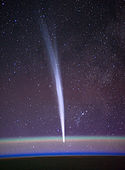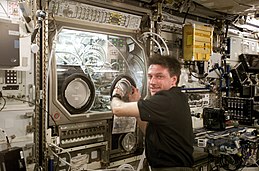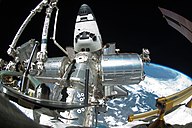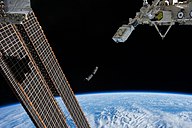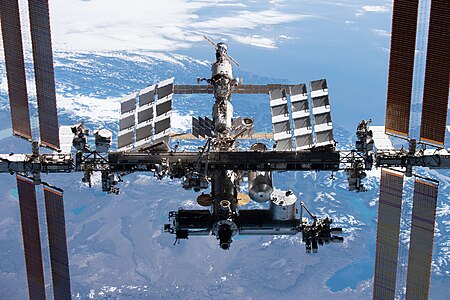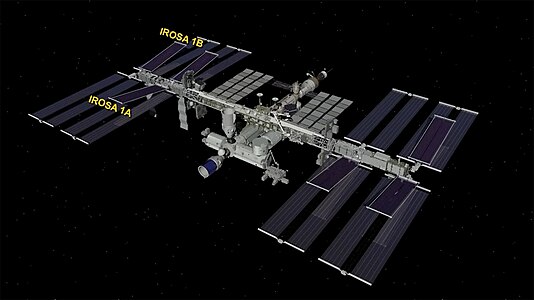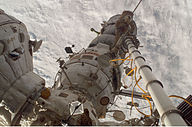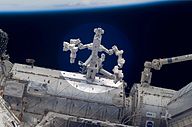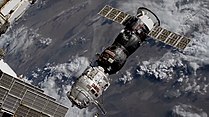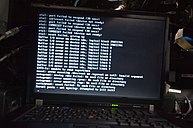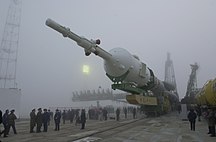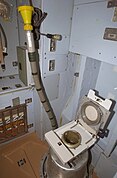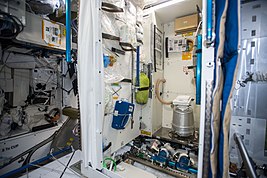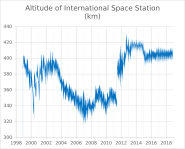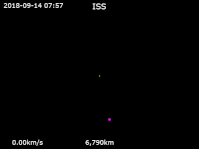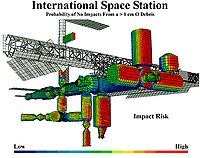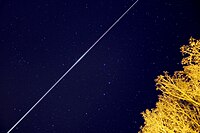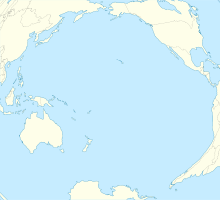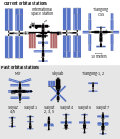Международная космическая станция
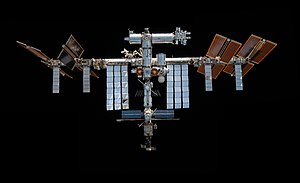 Косой вид снизу в ноябре 2021 г. | |
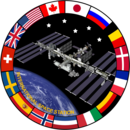 Знаки отличия программы Международной космической станции с флагами первоначальных подписавших государств. | |
| Статистика станции | |
|---|---|
| ИДЕНТИФИКАТОР КОСПЭРЭ | 1998-067А |
| САТКАТ нет. | 25544 |
| Позывной | Альфа , Станция |
| Экипаж |
|
| Запуск | 20 ноября 1998 г. |
| Стартовая площадка | |
| Масса | 450 000 кг (990 000 фунтов) [3] |
| Длина | 109 м (358 футов) (общая длина), 94 м (310 футов) (длина фермы) [4] |
| Ширина | 73 м (239 футов) (длина солнечной батареи) [4] |
| под давлением Объем | 1005,0 м 3 (35 491 куб футов) [4] |
| Атмосферное давление | 101,3 кПа (14,7 фунтов на квадратный дюйм ; 1,0 атм ) 79% азота, 21% кислорода |
| Высота перигея | 413 км (256,6 миль) над уровнем моря [5] |
| Высота апогея | 422 км (262,2 миль) над уровнем моря [5] |
| Наклонение орбиты | 51.64° [5] |
| Орбитальная скорость | 7,67 км/с; 27 600 км/ч; 17 100 миль в час [6] |
| Орбитальный период | 92,9 минуты [7] |
| Орбит в день | 15.5 [5] |
| орбиты Эпоха | 16 августа 16:19:30 [8] |
| Дни на орбите | 25 лет, 8 месяцев, 14 дней (4 августа 2024 г.) |
| Дней занято | 23 года, 9 месяцев, 1 день (4 августа 2024 г.) |
| Количество орбит | 141 117 по состоянию на август 2023 г. [update][8] |
| Орбитальный распад | 2 км/месяц |
| Статистика по состоянию на 22 декабря 2022 г. (если не указано иное) Ссылки: [4] [5] [9] [10] [11] | |
| Конфигурация | |
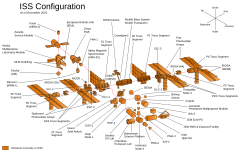 | |
Международная космическая станция ( МКС ) — крупная космическая станция, собираемая и обслуживаемая на низкой околоземной орбите совместными усилиями пяти космических агентств и их подрядчиков: НАСА (США), Роскосмоса (Россия), ЕКА (Европа), JAXA (Япония). и CSA (Канада). МКС — крупнейшая космическая станция, когда-либо построенная. Его основная цель — проведение экспериментов в области микрогравитации и космической среды . [12]
В эксплуатационном отношении станция разделена на два блока: российский орбитальный сегмент (ROS), собранный Роскосмосом, и американский орбитальный сегмент (USOS), собранный NASA, JAXA, ESA и CSA. Яркой особенностью МКС является интегрированная ферменная конструкция , которая соединяет большие солнечные панели и радиаторы с герметичными модулями. Герметичные модули предназначены для исследований, проживания, хранения, управления космическими кораблями и выполнения шлюзовых функций. Посещение стыковки космических кораблей на станции через восемь стыковочных и причальных портов . МКС поддерживает орбиту со средней высотой 400 километров (250 миль). [13] и вращается вокруг Земли примерно за 93 минуты, совершая 15,5 витков в день. [14]
Программа МКС объединяет два предыдущих плана по созданию пилотируемых станций на околоземной орбите: космическую станцию «Свобода» , запланированную Соединенными Штатами, и станцию «Мир-2» , запланированную Советским Союзом. Первый модуль МКС был запущен в 1998 году. Основные модули были запущены ракетами «Протон» и «Союз» , а также системой запуска «Спейс Шаттл» . Первые долговременные жители, Экспедиция 1 , прибыли 2 ноября 2000 года. С тех пор станция постоянно находилась под оккупацией в течение 23 лет и 276 дней, что является самым продолжительным непрерывным пребыванием человека в космосе. По состоянию на март 2024 г. [update]Космическую станцию посетили 279 человек из 22 стран. [15] Ожидается, что МКС будет иметь дополнительные модули ( например, орбитальный сегмент «Аксиома» ) и будет находиться в эксплуатации до конца 2030 года, после чего ее планируется спустить с орбиты специализированным космическим кораблем НАСА. [16]
История
[ редактировать ]Когда в начале 1970-х годов космическая гонка подошла к концу, США и СССР начали рассматривать различные варианты потенциального сотрудничества в космическом пространстве. Кульминацией этого стал испытательный проект «Аполлон-Союз» 1975 года , первая стыковка космических кораблей двух разных космических держав. УПАС был признан успешным, и рассматривались также дальнейшие совместные миссии.
Одной из таких концепций была компания International Skylab, которая предлагала запустить резервную космическую станцию Skylab B для миссии, в ходе которой будут неоднократно посещаться экипажи кораблей «Аполлон» и «Союз» . [17] Более амбициозной была космическая лаборатория «Скайлэб-Салют», которая предлагала стыковать «Скайлэб Б» с советской космической станцией «Салют» . Падение бюджетов и рост напряженности в холодной войне в конце 1970-х годов привели к тому, что эти концепции отошли на второй план, как и еще один план по стыковке космического корабля "Шаттл" с космической станцией "Салют". [18]
В начале 1980-х годов НАСА планировало запустить модульную космическую станцию « Свобода» как аналог космических станций «Салют» и «Мир» . В 1984 году ЕКА было приглашено принять участие в проекте « Свобода космической станции» , а к 1987 году ЕКА одобрило создание лаборатории «Колумбус». [19] Японский экспериментальный модуль (JEM), или Кибо , был анонсирован в 1985 году как часть космической станции «Свобода» в ответ на запрос НАСА в 1982 году.
В начале 1985 года министры науки стран Европейского космического агентства (ЕКА) одобрили программу «Колумбус» — самую амбициозную попытку в космосе, предпринятую этой организацией в то время. План, инициированный Германией и Италией, включал модуль, который будет прикреплен к «Фридому» и сможет превратиться в полноценный европейский орбитальный форпост до конца века. [20]
Рост затрат поставил эти планы под сомнение в начале 1990-х годов. Конгресс не пожелал предоставить достаточно денег для строительства и эксплуатации Freedom и потребовал от НАСА увеличить международное участие, чтобы покрыть растущие расходы, иначе они полностью отменят весь проект. [21]
Одновременно СССР занимался планированием космической станции «Мир-2» и к середине 1980-х годов приступил к строительству модулей для новой станции. Однако распад Советского Союза потребовал значительного сокращения масштабов этих планов, и вскоре Мир-2 оказался под угрозой того, что вообще никогда не будет запущен. [22] Поскольку оба проекта космических станций оказались под угрозой, американские и российские официальные лица встретились и предложили их объединить. [23]
В сентябре 1993 года вице-президент США Эл Гор и премьер-министр России Виктор Черномырдин объявили о планах создания новой космической станции, которая в конечном итоге стала Международной космической станцией. [24] В рамках подготовки к этому новому проекту они также договорились, что Соединенные Штаты будут участвовать в программе «Мир», включая стыковку американских шаттлов в «Шаттл -Мир» программе . [25]
12 апреля 2021 года на встрече с президентом России Владимиром Путиным тогдашний вице-премьер Юрий Борисов объявил, что принял решение о выходе России из программы МКС в 2025 году. [26] [27] По мнению российских властей, сроки работы станции истекли, а ее состояние оставляет желать лучшего. [26] 26 июля 2022 года Борисов, ставший главой Роскосмоса, представил Путину свои планы выхода из программы после 2024 года. [28] Однако Робин Гейтенс, представитель НАСА, отвечающий за эксплуатацию космической станции, ответил, что НАСА не получало никаких официальных уведомлений от Роскосмоса относительно планов вывода. [29] 21 сентября 2022 года Борисов заявил, что Россия «весьма вероятно» продолжит участие в программе МКС до 2028 года. [30]Цель
[ редактировать ]Первоначально МКС задумывалась как лаборатория, обсерватория и фабрика, а также обеспечивала транспортировку, техническое обслуживание и низкоорбитальную базу для возможных будущих миссий на Луну, Марс и астероиды. Однако не все варианты использования, предусмотренные первоначальным меморандумом о взаимопонимании между НАСА и Роскосмосом, были реализованы. [31] В Национальной космической политике США 2010 года МКС получила дополнительные функции по обслуживанию коммерческих, дипломатических, [32] и образовательных целях. [33]
Научные исследования
[ редактировать ]МКС предоставляет платформу для проведения научных исследований, располагающую электроэнергией, данными, охлаждением и экипажем для поддержки экспериментов. Небольшие беспилотные космические корабли также могут служить платформами для экспериментов, особенно тех, которые связаны с невесомостью и выходом в космос, но космические станции предлагают долгосрочную среду, где исследования могут проводиться потенциально в течение десятилетий, в сочетании с легким доступом для исследователей-людей. [34] [35]
МКС упрощает отдельные эксперименты, позволяя группам экспериментов использовать одни и те же запуски и время экипажа. Исследования проводятся в самых разных областях, включая астробиологию , астрономию , физику , материаловедение , космическую погоду , метеорологию и исследования человека , включая космическую медицину и науки о жизни . [36] [37] [38] [39] Ученые на Земле имеют своевременный доступ к данным и могут предложить экипажу экспериментальные модификации. Если необходимы последующие эксперименты, регулярно запланированные запуски кораблей снабжения позволяют относительно легко запускать новое оборудование. [35] Экипажи совершают экспедиции продолжительностью несколько месяцев, обеспечивая около 160 человеко-часов в неделю работы экипажа из шести человек. Однако значительное количество времени экипажа отнимает обслуживание станции. [40]
Пожалуй, самым заметным экспериментом на МКС является Альфа-магнитный спектрометр (AMS), который предназначен для обнаружения темной материи и ответа на другие фундаментальные вопросы о нашей Вселенной. По данным НАСА, AMS так же важен, как и космический телескоп Хаббл . В настоящее время он пристыкован к станции, но его невозможно было легко разместить на свободно летающей спутниковой платформе из-за его потребностей в мощности и пропускной способности. [41] [42] 3 апреля 2013 года ученые сообщили, что намеки на темную материю . AMS, возможно, обнаружил [43] [44] [45] [46] [47] [48] По словам ученых, «первые результаты космического альфа-магнитного спектрометра подтверждают необъяснимый избыток высокоэнергетических позитронов в космических лучах, связанных с Землей». [ нужна ссылка ]
Космическая среда враждебна жизни. Незащищенное пребывание в космосе характеризуется интенсивным радиационным полем (состоящим в основном из протонов и других субатомных заряженных частиц солнечного ветра , помимо космических лучей ), высоким вакуумом, экстремальными температурами и микрогравитацией. [49] Некоторые простые формы жизни, называемые экстремофилами , [50] а также мелких беспозвоночных, называемых тихоходками. [51] могут выжить в этой среде в чрезвычайно сухом состоянии за счет высыхания .
Медицинские исследования расширяют знания о влиянии длительного пребывания в космосе на организм человека, включая атрофию мышц , потерю костной массы и сдвиг жидкости. длительных полетов человека в космос и колонизации космоса Эти данные будут использоваться для определения возможности . В 2006 году данные о потере костной массы и мышечной атрофии показали, что существует значительный риск переломов и проблем с движением, если астронавты приземлятся на планете после длительного межпланетного круиза, такого как шестимесячный интервал, необходимый для путешествия на Марс . [52] [53]
Медицинские исследования проводятся на борту МКС по поручению Национального института космических биомедицинских исследований (NSBRI). Особое место среди них занимает исследование «Усовершенствованное диагностическое ультразвуковое исследование в условиях микрогравитации», в ходе которого астронавты выполняют ультразвуковое сканирование под руководством удаленных экспертов. Исследование рассматривает диагностику и лечение заболеваний в космосе. Обычно на борту МКС нет врача, и диагностика заболеваний является сложной задачей. Ожидается, что ультразвуковое сканирование с дистанционным управлением будет применяться на Земле в ситуациях неотложной помощи и оказания медицинской помощи в сельской местности, где доступ к квалифицированному врачу затруднен. [54] [55] [56]
В августе 2020 года ученые сообщили, что бактерии с Земли, в частности бактерии Deinococcus radiodurans , обладающие высокой устойчивостью к опасностям окружающей среды , выживают в космическом пространстве в течение трех лет , согласно исследованиям, проведенным на Международной космической станции. Эти результаты подтвердили идею панспермии , гипотезу о том, что жизнь существует во Вселенной , распределенной различными способами, включая космическую пыль , метеороиды , астероиды , кометы , планетоиды или загрязненные космические корабли . [57] [58]
Дистанционное зондирование Земли, астрономия и исследования дальнего космоса на МКС значительно расширились в 2010-е годы после завершения строительства американского орбитального сегмента в 2011 году. На протяжении более чем 20 лет существования программы МКС исследователи на борту МКС и на Земля исследовала аэрозоли , озон , молнии и оксиды в атмосфере Земли, а также Солнце , космические лучи, космическую пыль , антиматерию и темную материю во Вселенной. Примерами экспериментов по дистанционному зондированию Земли, проведенных на МКС, являются Орбитальная углеродная обсерватория 3 , ISS-RapidScat , ECOSTRESS , Исследование динамики глобальной экосистемы и Система транспортировки облачных аэрозолей . Астрономические телескопы и эксперименты на базе МКС включают SOLAR , исследователь внутреннего состава нейтронной звезды , калориметрический электронный телескоп , монитор рентгеновского изображения всего неба (MAXI) и альфа-магнитный спектрометр . [36] [59]
Свободное падение
[ редактировать ]

Гравитация на высоте МКС примерно на 90% сильнее, чем на поверхности Земли, но объекты на орбите находятся в постоянном состоянии свободного падения , что приводит к кажущемуся состоянию невесомости . [60] Эта воспринимаемая невесомость нарушается пятью эффектами: [61]
- Перетащите из остаточной атмосферы.
- Вибрация от движений механических систем и экипажа.
- Срабатывание бортовых гироскопов момента ориентации .
- Включение двигателей для изменения положения или орбиты.
- Эффекты гравитационного градиента , также известные как приливные эффекты. Объекты в разных местах МКС, если бы они не были прикреплены к станции, двигались бы по несколько разным орбитам. Будучи механически соединенными, эти элементы испытывают небольшие силы, которые заставляют станцию двигаться как твердое тело .
Исследователи изучают влияние почти невесомой среды станции на эволюцию, развитие, рост и внутренние процессы растений и животных. В ответ на некоторые данные НАСА хочет исследовать влияние микрогравитации на рост трехмерных человеческих тканей и необычных белковых кристаллов , которые могут образовываться в космосе. [36]
Исследование физики жидкостей в условиях микрогравитации позволит получить более качественные модели поведения жидкостей. Поскольку в условиях микрогравитации жидкости могут почти полностью смешиваться, физики исследуют жидкости, которые плохо смешиваются на Земле. Изучение реакций, которые замедляются из-за низкой гравитации и низких температур, улучшит наше понимание сверхпроводимости . [36]
Изучение материаловедения является важной исследовательской деятельностью МКС, целью которой является получение экономических выгод за счет совершенствования методов, используемых на Земле. [62] Другие области интересов включают влияние низкой гравитации на горение посредством изучения эффективности сжигания и контроля выбросов и загрязняющих веществ. Эти результаты могут улучшить знания о производстве энергии и привести к экономическим и экологическим выгодам. [36]
Разведка
[ редактировать ]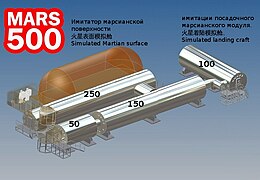
МКС предоставляет место на относительной безопасности низкой околоземной орбиты для тестирования систем космических аппаратов, которые потребуются для длительных полетов на Луну и Марс. Это обеспечивает опыт эксплуатации, технического обслуживания, ремонта и замены на орбите. Это поможет развить необходимые навыки управления космическими кораблями дальше от Земли, снизить риски миссий и расширить возможности межпланетных космических кораблей. [63] Ссылаясь на эксперимент МАРС-500 , эксперимент по изоляции экипажа, проводимый на Земле, ЕКА заявляет: «В то время как МКС необходима для ответа на вопросы, касающиеся возможного воздействия невесомости, радиации и других специфических космических факторов, таких аспектов, как влияние длительного -срочная изоляция и заключение могут быть более целесообразно решены с помощью наземного моделирования». [64] Сергей Краснов, руководитель программ пилотируемых космических полетов российского космического агентства «Роскосмос», в 2011 году предположил, что «укороченная версия» МАРС-500 может быть реализована на МКС. [65]
В 2009 году, отмечая ценность самой структуры партнерства, Сергей Краснов писал: «По сравнению с партнерами, действующими по отдельности, партнеры, развивающие взаимодополняющие способности и ресурсы, могут дать нам гораздо больше уверенности в успехе и безопасности освоения космоса. МКС помогает и дальше». продвижение освоения околоземного космического пространства и реализация перспективных программ исследования и освоения Солнечной системы, включая Луну и Марс». [66] Миссия с экипажем на Марс может стать многонациональной инициативой с участием космических агентств и стран, не входящих в нынешнее партнерство по МКС. В 2010 году генеральный директор ЕКА Жан-Жак Дорден заявил, что его агентство готово предложить остальным четырем партнерам пригласить Китай, Индию и Южную Корею присоединиться к партнерству по МКС. [67] Глава НАСА Чарльз Болден заявил в феврале 2011 года: «Любая миссия на Марс, скорее всего, будет глобальной задачей». [68] В настоящее время федеральное законодательство США запрещает сотрудничество НАСА с Китаем в космических проектах без одобрения ФБР и Конгресса. [69]
Образование и культурная деятельность
[ редактировать ]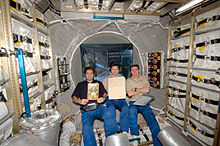
Экипаж МКС предоставляет возможности студентам на Земле, проводя разработанные студентами эксперименты, создавая образовательные демонстрации, позволяя студентам участвовать в классных версиях экспериментов МКС, а также напрямую привлекая студентов с помощью радио и электронной почты. [70] [71] ESA предлагает широкий спектр бесплатных учебных материалов, которые можно загрузить для использования в классах. [72] За один урок студенты смогут ориентироваться в 3D-модели интерьера и экстерьера МКС и решать спонтанные задачи, которые нужно решать в режиме реального времени. [73]
Японское агентство аэрокосмических исследований (JAXA) стремится вдохновить детей «заниматься мастерством» и повысить их «осведомленность о важности жизни и своих обязанностях в обществе». [74] С помощью серии образовательных руководств учащиеся приобретают более глубокое понимание прошлого и ближайшего будущего пилотируемых космических полетов, а также Земли и жизни. [75] [76] В экспериментах JAXA «Семена в космосе» мутационные эффекты космического полета на семена растений на борту МКС исследуются путем выращивания семян подсолнечника, которые летали на МКС около девяти месяцев. На первом этапе использования Кибо с 2008 по середину 2010 года исследователи из более чем десятка японских университетов проводили эксперименты в различных областях. [77]
Культурные мероприятия являются еще одной важной целью программы ISS. Тецуо Танака, директор Центра космической среды и использования JAXA, сказал: «В космосе есть что-то такое, что трогает даже людей, не интересующихся наукой». [78]
Любительское радио на МКС (ARISS) — это волонтерская программа, которая поощряет студентов со всего мира делать карьеру в области науки, технологий, инженерии и математики посредством возможностей любительской радиосвязи с экипажем МКС. ARISS — международная рабочая группа, состоящая из делегаций девяти стран, в том числе нескольких европейских, а также Японии, России, Канады и США. В районах, где невозможно использовать радиооборудование, громкоговорители соединяют студентов с наземными станциями, которые затем передают вызовы на космическую станцию. [79]
«Первая орбита» — полнометражный документальный фильм 2011 года о корабле «Восток-1» , первом пилотируемом космическом полете вокруг Земли. Максимально приблизив орбиту МКС к орбите «Востока-1» с точки зрения наземной траектории и времени суток, режиссер-документалист Кристофер Райли и астронавт ЕКА Паоло Несполи смогли заснять вид, который Юрий Гагарин увидел на своем новаторском орбитальном спутнике. космический полет. Эти новые кадры были объединены с оригинальными аудиозаписями миссии «Восток-1», полученными из Российского государственного архива. Несполи считается оператором- постановщиком этого документального фильма, поскольку он сам записал большую часть отснятого материала во экспедиции 26/27 время . [80] Мировая премьера фильма транслировалась на YouTube в 2011 году по бесплатной лицензии через сайт firstorbit.org . [81]
В мае 2013 года командир Крис Хэдфилд музыкальное видео на песню Дэвида Боуи « Space Oddity », которое было опубликовано на YouTube. снял на борту станции [82] [83] Это был первый музыкальный клип, снятый в космосе. [84]
В ноябре 2017 года, участвуя в экспедиции 52/53 на сделал МКС, Паоло Несполи две записи своего разговорного голоса (одну на английском, а другую на родном итальянском языке) для использования в Википедии статьях . Это был первый контент, созданный в космосе специально для Википедии. [85] [86]
В ноябре 2021 года было анонсировано проведение выставки виртуальной реальности «Бесконечность», посвященной жизни на борту МКС. [87]
Строительство
[ редактировать ]Производство
[ редактировать ]В этом разделе содержится подробный перефраз внешнего источника https://nara.getarchive.net/collections/building-iss-timeline ( отчет Copyvios ) . ( Июль 2024 г. ) |

Поскольку Международная космическая станция является совместным многонациональным проектом, компоненты для орбитальной сборки производились в разных странах мира. Начиная с середины 1990-х годов американские компоненты Destiny , Unity , интегрированная ферменная конструкция и солнечные батареи производились в Центре космических полетов Маршалла в Хантсвилле, штат Алабама, и на сборочном заводе Мишуда . Эти модули были доставлены в Оперативно-проверочный корпус и Технологический комплекс космической станции (SSPF) для окончательной сборки и подготовки к запуску. [88]
Российские модули, в том числе «Заря» и «Звезда» , были изготовлены в Государственном космическом научно-производственном центре имени Хруничева в Москве . Первоначально «Звезда» производилась в 1985 году как компонент Мир-2 , но «Мир-2» так и не был запущен и вместо этого стал служебным модулем МКС. [89]
Европейского космического агентства (ЕКА) Модуль Columbus был изготовлен на предприятии EADS Astrium Space Transportation в Бремене , Германия, вместе со многими другими подрядчиками по всей Европе. [90] Другие модули, построенные ЕКА — Harmony , Tranquility , Leonardo MPLM и Cupola — первоначально производились на заводе Thales Alenia Space в Турине, Италия. [91] Стальные корпуса модулей были доставлены самолетами в Космический центр Кеннеди SSPF для подготовки к запуску. [92]
Японский экспериментальный модуль Кибо был изготовлен на различных технологических предприятиях в Японии, в NASDA (ныне JAXA) Космическом центре Цукуба и Институте космических и астронавтических наук . Модуль «Кибо» был перевезен на корабле и доставлен самолетом на МОПС. [93]
Мобильная система обслуживания , состоящая из Canadarm2 и грейферного приспособления Dextre , производилась на различных заводах в Канаде (таких как Лаборатория Дэвида Флориды ) и США по контракту Канадского космического агентства . Мобильная базовая система, соединяющая каркас для Canadarm2, установленная на рельсах, была построена компанией Northrop Grumman .
Сборка
[ редактировать ]В этом разделе содержится подробный перефраз внешнего источника https://nara.getarchive.net/collections/building-iss-timeline ( отчет Copyvios ) . ( Июль 2024 г. ) |

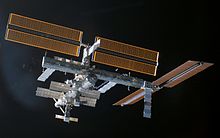

Сборка Международной космической станции, крупного проекта космической архитектуры , началась в ноябре 1998 года. [9] Российские модули запускались и стыковались роботизированно, за исключением «Рассвета» . Все остальные модули были доставлены с помощью космического корабля "Шаттл" , что потребовало установки членами экипажа МКС и шаттла с использованием Canadarm2 (SSRMS) и действий в открытом космосе (EVA); к 5 июня 2011 года они добавили 159 компонентов за более чем 1000 часов выхода в открытый космос. 127 из этих выходов в открытый космос произошли со станции, а остальные 32 были запущены из шлюзов пристыкованных космических кораблей. [94] Угол бета станции необходимо было учитывать на всех этапах строительства. [95]
Первый модуль МКС «Заря » был запущен 20 ноября 1998 года на автономной российской ракете «Протон» . Он обеспечивал движение, управление ориентацией , связь и электроэнергию, но не имел функций долгосрочного жизнеобеспечения. Пассивный модуль НАСА « Юнити » был запущен две недели спустя на борту космического корабля «Шаттл» STS-88 и прикреплен к «Заре» астронавтами во время выхода в открытый космос. Модуль Unity имеет два герметичных стыковочных адаптера (PMA): один постоянно подключается к «Заре» , а другой позволяет космическому шаттлу состыковаться с космической станцией. В то время российская (советская) станция «Мир» еще была обитаемой, а МКС два года оставалась без экипажа. 12 июля 2000 года модуль «Звезда» был выведен на орбиту. Бортовые заранее запрограммированные команды развернули солнечные батареи и антенну связи. Затем «Звезда» стала пассивной целью сближения с «Зарей» и «Юнити» , поддерживая постоянную орбиту, в то время как корабль «Заря - Юнити» выполнял сближение и стыковку с помощью наземного управления и российской автоматизированной системы сближения и стыковки. Компьютер «Зари » передал управление станцией компьютеру «Звезды » вскоре после стыковки. «Звезда» добавила спальные помещения, туалет, кухню, скрубберы CO 2 , осушитель, генераторы кислорода и тренажеры, а также передачу данных, голосовую и телевизионную связь с контролем полета, что позволило обеспечить постоянное проживание на станции. [96] [97]
Первый постоянный экипаж, Экспедиция-1 , прибыл в ноябре 2000 года на корабле «Союз ТМ-31» . В конце первого дня на станции астронавт Билл Шепард попросил использовать радиопозывной « Альфа », который он и космонавт Сергей Крикалев предпочли более громоздкой « Международной космической станции ». [98] Название « Альфа » ранее использовалось для станции в начале 1990-х годов. [99] и его использование было разрешено на протяжении всей Экспедиции 1. [100] Шепард уже некоторое время выступал за использование нового имени для менеджеров проектов. Ссылаясь на военно-морскую традицию , на пресс-конференции перед запуском он сказал: «На протяжении тысячелетий люди выходили в море на кораблях. Люди проектировали и строили эти суда, спускали их на воду с хорошим чувством, что имя принесет пользу». удачи команде и успеха их путешествию». [101] Юрий Семенов , в то время президент Российской космической корпорации «Энергия» , не одобрял название « Альфа », поскольку считал, что «Мир» были названы « Бета » или « Мир была первой модульной космической станцией, поэтому для МКС -2». было бы более уместно. [100] [102] [103]
Экспедиция 1 прибыла на полпути между полетами космических кораблей STS-92 и STS-97 . станции Каждый из этих двух полетов добавлял сегменты интегрированной ферменной конструкции , которая обеспечивала станцию связью в Ku-диапазоне для американского телевидения, дополнительную поддержку ориентации, необходимую для дополнительной массы USOS, и значительные солнечные батареи в дополнение к четырем существующим батареям станции. [104] В течение следующих двух лет станция продолжала расширяться. Ракета «Союз-У» доставила «Пирс» стыковочный отсек . Космические челноки «Дискавери» , «Атлантис» и «Индевор» доставили лабораторию «Дестини» и «Квест» шлюзовую камеру , а также главный роботизированный манипулятор станции «Канадарм2» и еще несколько сегментов интегрированной ферменной конструкции.
График расширения был прерван в 2003 году из-за космического корабля "Колумбия" катастрофы и, как следствие, перерыва в полетах. Использование космического корабля "Шаттл" было приостановлено до 2005 года, а STS-114 пилотировал "Дискавери" . [105] Сборка возобновилась в 2006 году с прибытием STS-115 с «Атлантисом» , который доставил на станцию второй комплект солнечных батарей. Еще несколько сегментов фермы и третий комплект массивов были поставлены на STS-116 , STS-117 и STS-118 . В результате значительного расширения энергетических возможностей станции можно было разместить больше герметичных модулей, а также узел «Гармония» и европейская лаборатория «Колумбус» были добавлены . Вскоре за ними последовали первые два компонента Кибо . В марте 2009 года STS-119 завершил строительство интегрированной ферменной конструкции с установкой четвертого и последнего комплекта солнечных батарей. Последняя секция « Кибо» была доставлена в июле 2009 года на STS-127 , за ней последовал модуль «Русский поиск» . Третий узел, «Спокойствие» , был доставлен в феврале 2010 года во время STS-130 космическим кораблем « Индевор» рядом с «Куполом» , за ним последовал предпоследний российский модуль «Рассвет » в мае 2010 года. «Рассвет» был доставлен космическим кораблем «Атлантис» на STS-132 в в обмен на поставку российского «Протона» финансируемого США Zarya module in 1998. [106] Последний гермомодуль USOS, «Леонардо» , был доставлен на станцию в феврале 2011 года на последнем полете «Дискавери» , STS-133 . [107] Альфа -магнитный спектрометр был доставлен компанией Endeavour на STS-134 в том же году. [108]
К июню 2011 года станция состояла из 15 герметичных модулей и интегрированной ферменной конструкции. Два силовых модуля под названием НЭМ-1 и НЭМ-2. [109] их еще предстояло запустить. Новый российский модуль первичных исследований «Наука» пришвартовался в июле 2021 года. [110] наряду с европейским роботизированным манипулятором, который может перемещаться в разные части российских модулей станции. [111] Последнее пополнение России, узловой модуль «Причал» , пристыковался в ноябре 2021 года. [112]
Полная масса станции меняется со временем. Общая стартовая масса модулей на орбите составила около 417 289 кг (919 965 фунтов) (по состоянию на 3 сентября 2011 г.). [update]). [94] Масса экспериментов, запасных частей, личных вещей, экипажа, продуктов питания, одежды, топлива, запасов воды, газа, пристыкованных космических кораблей и других предметов добавляется к общей массе станции. Водород постоянно выбрасывается за борт генераторами кислорода.
Структура
[ редактировать ]МКС функционирует как модульная космическая станция, позволяющая добавлять или удалять модули из ее структуры для повышения адаптируемости.
- Обзорная схема компонентов
- Внешний вид и стальные конструкции МКС, сделанные 8 ноября 2021 года из вылетающей SpaceX Crew-2. капсулы
- Схема строения Международной космической станции после установки солнечных батарей iROSA (по состоянию на 2023 год)
Ниже представлена схема основных компонентов станции. Синие области — это герметичные секции, доступные экипажу без использования скафандров. Негерметичная надстройка станции обозначена красным. Запланированные компоненты показаны белым цветом, неустановленные, временно вышедшие из строя или вышедшие из эксплуатации компоненты показаны коричневым, а бывшие - серым. Другие компоненты, не находящиеся под давлением, имеют желтый цвет. Узел Unity соединяется непосредственно с лабораторией Destiny . Для наглядности они показаны отдельно. Подобные случаи наблюдаются и в других частях конструкции.
Герметичные модули
[ редактировать ]Zarya
[ редактировать ]
Zarya ( Russian : Заря , lit. 'Dawn' [б] ), также известный как Функционально-грузовой блок или ФГБ (от русского «Функционально-грузовой блок» , букв. « Функционально-грузовой блок » или ФГБ ), является первым запущенным модулем МКС. [113] ФГБ обеспечивал электроэнергию, хранение, движение и управление МКС на начальном этапе сборки. С запуском и сборкой на орбите других модулей с более специализированным функционалом «Заря» по состоянию на август 2021 года в основном используется для хранения, как внутри гермоотсека, так и в выносных топливных баках. « Заря» является потомком космического корабля ТКС, разработанного для российской «Салют» программы . Название «Заря» («Рассвет») было присвоено ФГБ, поскольку оно означало начало новой эры международного сотрудничества в космосе. Хотя его построила российская компания, он принадлежит Соединенным Штатам. [114]
Единство
[ редактировать ]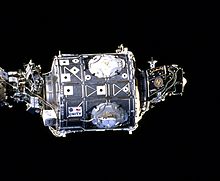
Соединительный модуль Unity , также известный как Node 1, является первым компонентом МКС, построенным в США. Он соединяет российский и американский сегменты станции, и здесь экипаж вместе обедает. [115] [116]
Модуль имеет цилиндрическую форму и имеет шесть мест для стоянки ( в носовой части , кормовой , части левом , правом борту , зените и надире ), облегчающих соединение с другими модулями. Unity имеет диаметр 4,57 метра (15 футов), длину 5,47 метра (17,9 фута), изготовлен из стали и был построен для НАСА компанией Boeing на производственном предприятии в Центре космических полетов Маршалла в Хантсвилле, штат Алабама . Unity — первый из трёх соединительных модулей; два других — Гармония и Спокойствие . [117]
Zvezda
[ редактировать ]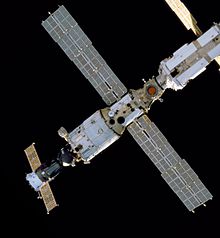
«Звезда» (русский: Звезда , что означает «звезда»), Салют ДОС-8 , также известен как служебный модуль «Звезда» . Это был третий модуль, запущенный на станцию, и он обеспечивает некоторые системы жизнеобеспечения станции , некоторые из которых дополнены в USOS, а также жилые помещения для двух членов экипажа. Это структурный и функциональный центр Российского орбитального сегмента , который является российской частью МКС. Здесь собирается команда для устранения чрезвычайных ситуаций на станции. [118] [119] [120]
Модуль изготовлен РКК «Энергия» , при основных субподрядных работах ГКНПЦ имени Хруничева. [121] «Звезда» была запущена на ракете «Протон» 12 июля 2000 года и состыковалась с модулем «Заря» 26 июля 2000 года.
Судьба
[ редактировать ]
Модуль «Дестини» , также известный как «Лаборатория США», является основным операционным комплексом для американских исследовательских грузов на борту МКС. [122] [123] Он был подключен к модулю Unity и активирован в течение пяти дней в феврале 2001 года. [124] Дестини - первая постоянно действующая орбитальная исследовательская станция НАСА с тех пор, как Скайлэб была освобождена в феврале 1974 года. Компания Boeing начала строительство 14,5-тонной (32 000 фунтов) исследовательской лаборатории в 1995 году на сборочном заводе Мишуда , а затем в Центре космических полетов Маршалла в Хантсвилле. Алабама. [122] Destiny был отправлен в Космический центр Кеннеди во Флориде в 1998 году и передан НАСА для предстартовой подготовки в августе 2000 года. Он был запущен 7 февраля 2001 года на борту космического корабля " Атлантис" на STS-98 . [124] В настоящее время здесь находится система генерации кислорода, которая вступила в эксплуатацию 12 июля 2007 года, а ранее здесь размещалась система рекуперации воды, когда она была временно установлена в ноябре 2008 года, прежде чем система была перенесена в модуль «Спокойствие» в феврале 2010 года. [125] [126] Астронавты работают внутри герметичного объекта и проводят исследования во многих научных областях. Ученые всего мира будут использовать результаты для улучшения своих исследований в области медицины, техники, биотехнологии, физики, материаловедения и наук о Земле. [123]
Квест
[ редактировать ]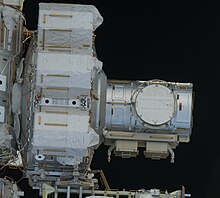
Объединенный шлюзовой шлюз (также известный как «Квест») предоставлен США и обеспечивает возможность выхода в открытый космос на базе МКС с использованием либо американского блока внекорабельной мобильности (EMU), либо российских костюмов «Орлан» для выхода в открытый космос. [127] Перед запуском этого шлюза выходы в открытый космос осуществлялись либо с американского космического корабля "Шаттл" (во время пристыковки), либо из переходной камеры служебного модуля. Из-за множества системных и конструктивных отличий с Шаттла можно было использовать только скафандры США, а со Служебного модуля - только российские скафандры. Joint Airlock решает эту краткосрочную проблему, позволяя использовать одну (или обе) системы скафандров. [128]
Объединенный шлюзовой шлюз был запущен на МКС-7А/STS-104 в июле 2001 года и прикреплен к правому стыковочному порту узла 1. [129] Общий шлюз имеет длину 20 футов, диаметр 13 футов и вес 6,5 тонн. Объединенный шлюзовой шлюз был построен компанией Boeing в Центре космических полетов имени Маршалла. Объединенный шлюзовой шлюз был запущен с помощью газовой сборки высокого давления. Газовая сборка высокого давления была установлена на внешней поверхности шлюзового шлюза и будет обеспечивать операции выхода в открытый космос дыхательными газами и дополнять систему пополнения запасов газа служебного модуля.Объединенный шлюзовой шлюз состоит из двух основных компонентов: шлюзового шлюза для экипажа, из которого астронавты и космонавты покидают МКС, и шлюзового шлюза для оборудования, предназначенного для хранения оборудования для выхода в открытый космос и для так называемых ночных «лагерей», где азот выводится из тел космонавтов в течение ночи по мере падения давления. подготовка к выходам в открытый космос на следующий день. Это облегчает изгибы, поскольку астронавты восстанавливают давление после выхода в открытый космос. [128]
Шлюз для экипажа был создан на основе внешнего шлюза космического корабля "Шаттл". Он оснащен освещением, внешними поручнями и узлом интерфейса шлангокабеля (UIA). МАУ расположен на одной из стенок шлюза экипажа и обеспечивает линию подачи воды, линию возврата сточных вод и линию подачи кислорода. МАУ также предоставляет средства связи и интерфейсы питания скафандров и может поддерживать два скафандра одновременно. Это могут быть как два американских скафандра EMU, два российских скафандра «ОРЛАН», так и по одному каждой конструкции.
Poisk
[ редактировать ]Поиск (русский: Поиск , букв. «Поиск») был запущен 10 ноября 2009 г. [130] [131] прикреплен к модифицированному космическому кораблю «Прогресс» под названием «Прогресс М-МИМ2» на ракете «Союз-У» со стартовой площадки 1 на космодроме Байконур в Казахстане . «Поиск» используется в качестве российского шлюзового модуля, содержащего два одинаковых люка для выхода в открытый космос. Открывающийся наружу люк на космической станции «Мир» вышел из строя после того, как он слишком быстро распахнулся после разблокировки из-за небольшого давления воздуха, оставшегося в шлюзовой камере. [132] Все люки для выхода в открытый космос на МКС открываются внутрь и являются герметичными. «Поиск» используется для хранения, обслуживания и ремонта российских скафандров «Орлан» и обеспечивает вход на случай непредвиденных обстоятельств для экипажа, использующего немного более громоздкие американские скафандры. Самый внешний стыковочный порт модуля позволяет стыковать космические корабли «Союз» и «Прогресс», а также автоматическую передачу топлива в хранилище Российского орбитального сегмента (РОС) и обратно. [133] С момента вылета идентичного модуля «Пирс» 26 июля 2021 года «Поиск» служил единственным шлюзом на ROS.
Гармония
[ редактировать ]
«Гармония» , также известная как «Узел 2» , является «служебным центром» МКС. Он соединяет лабораторные модули США, Европы и Японии, а также обеспечивает электроэнергию и электронные данные. Здесь расположены спальные каюты для четырех членов экипажа. [134]
«Гармония» была запущена в космос на борту космического корабля «Шаттл» STS-120 23 октября 2007 года. [135] [136] После временного подключения к порту узла Unity , [137] [138] он был перенесен на свое постоянное место в передней части лаборатории Destiny 14 ноября 2007 года. [139] Гармония прибавила 75,5 м 3 (2666 куб. футов) к жилому объему станции, увеличение почти на 20 процентов, с 424,8 до 500,2 м. 3 (от 15 000 до 17 666 куб. Футов). Успешная установка означала, что с точки зрения НАСА станция считалась «завершенным ядром США».
Спокойствие
[ редактировать ]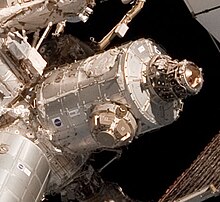
«Спокойствие» , также известное как «Узел 3», — модуль МКС. Он содержит системы экологического контроля, системы жизнеобеспечения , туалет, тренажеры и наблюдательный купол .
Европейское космическое агентство и Итальянское космическое агентство заказали Tranquility, произведенный Thales Alenia Space . На церемонии 20 ноября 2009 года право собственности на модуль было передано НАСА. [140] 8 февраля 2010 года НАСА запустило модуль космического корабля "Шаттл" STS-130 .
Колумбус
[ редактировать ]
«Колумбус» — это научная лаборатория, которая является частью МКС и представляет собой крупнейший вклад Европейского космического агентства в развитие станции.
Как и модули «Гармония» и «Спокойствие» , лаборатория «Колумбус» была построена в Турине , Италия, компанией Thales Alenia Space . Функциональное оборудование и программное обеспечение лаборатории разработано компанией EADS в Бремене , Германия. Он также был интегрирован в Бремене, а затем отправлен в Космический центр Кеннеди во Флориде на самолете Airbus Beluga . Он был запущен на борту космического корабля "Атлантис" 7 февраля 2008 года рейсом STS-122 . Он рассчитан на десять лет эксплуатации. Модуль управляется Центром управления «Колумбус» , расположенным в Немецком центре космических операций , входящем в состав Немецкого аэрокосмического центра в Оберпфаффенхофене недалеко от Мюнхена , Германия.
The European Space Agency has spent €1.4 billion (about US$1.6 billion) on building Columbus, including the experiments it carries and the ground control infrastructure necessary to operate them.[141]
Kibō
[edit]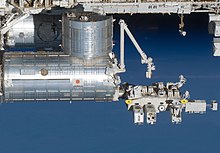
The Japanese Experiment Module (JEM), nicknamed Kibō (きぼう, Kibō, Hope), is a Japanese science module for the International Space Station (ISS) developed by JAXA. It is the largest single ISS module, and is attached to the Harmony module. The first two pieces of the module were launched on Space Shuttle missions STS-123 and STS-124. The third and final components were launched on STS-127.[142]
Cupola
[edit]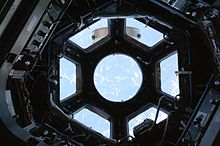
The Cupola is an ESA-built observatory module of the ISS. Its name derives from the Italian word cupola, which means "dome". Its seven windows are used to conduct experiments, dockings and observations of Earth. It was launched aboard Space Shuttle mission STS-130 on 8 February 2010 and attached to the Tranquility (Node 3) module. With the Cupola attached, ISS assembly reached 85 per cent completion. The Cupola's central window has a diameter of 80 cm (31 in).[143]
Rassvet
[edit]
Rassvet (Russian: Рассвет; lit. "dawn"), also known as the Mini-Research Module 1 (MRM-1) (Russian: Малый исследовательский модуль, МИМ 1) and formerly known as the Docking Cargo Module (DCM), is a component of the International Space Station (ISS). The module's design is similar to the Mir Docking Module launched on STS-74 in 1995. Rassvet is primarily used for cargo storage and as a docking port for visiting spacecraft. It was flown to the ISS aboard Space Shuttle Atlantis on the STS-132 mission on 14 May 2010,[144] and was connected to the ISS on 18 May 2010.[145] The hatch connecting Rassvet with the ISS was first opened on 20 May 2010.[146] On 28 June 2010, the Soyuz TMA-19 spacecraft performed the first docking with the module.[147]
Science (or Experiment) Airlock
[edit]
The airlock, ShK, is designed for a payload with dimensions up to 1,200 mm × 500 mm × 500 mm (47 in × 20 in × 20 in), has a volume of 2.1 m3, weight of 1050 kg and consumes 1.5 kW of power at the peak. Prior to berthing the MLM to the ISS, the airlock is stowed as part of MRM1.[148] On 4 May 2023, 01:00 UTC, the chamber was moved by the ERA manipulator and berthed to the forward active docking port of the pressurized docking hub of the Nauka module during VKD-57 spacewalk. It is intended to be used:
- for extracting payloads and from the MLM docking adapter and placing them on the outer surface of the station;
- enable science investigations to be removed, exposed to the external microgravity environment, then returned inside while being maneuvered with the European robotic arm.
- for receiving payloads from the ERA manipulator and moving them into the internal volume of the airlock and further into the MLM pressurized adapter;
- for conducting scientific experiments in the internal volume of the airlock;
- for conducting scientific experiments outside the airlock chamber on an extended table and in a special organized place.[148][149]
- for launching cubesats into space, with the aid of ERA – very similar to the Japanese airlock and Nanoracks Bishop Airlock on the U.S. segment of the station.[150]
Leonardo
[edit]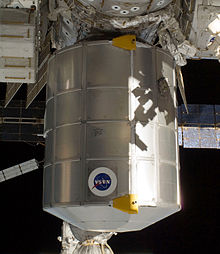
The Leonardo Permanent Multipurpose Module (PMM) is a module of the International Space Station. It was flown into space aboard the Space Shuttle on STS-133 on 24 February 2011 and installed on 1 March. Leonardo is primarily used for storage of spares, supplies and waste on the ISS, which was until then stored in many different places within the space station. It is also the personal hygiene area for the astronauts who live in the US Orbital Segment. The Leonardo PMM was a Multi-Purpose Logistics Module (MPLM) before 2011, but was modified into its current configuration. It was formerly one of two MPLM used for bringing cargo to and from the ISS with the Space Shuttle. The module was named for Italian polymath Leonardo da Vinci.
Bigelow Expandable Activity Module
[edit]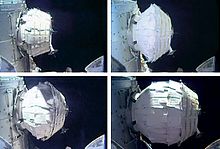
The Bigelow Expandable Activity Module (BEAM) is an experimental expandable space station module developed by Bigelow Aerospace, under contract to NASA, for testing as a temporary module on the International Space Station (ISS) from 2016 to at least 2020. It arrived at the ISS on 10 April 2016,[151] was berthed to the station on 16 April at Tranquility Node 3, and was expanded and pressurized on 28 May 2016. In December 2021, Bigelow Aerospace conveyed ownership of the module to NASA, as a result of Bigelow's cessation of activity.[152]
International Docking Adapters
[edit]
The International Docking Adapter (IDA) is a spacecraft docking system adapter developed to convert APAS-95 to the NASA Docking System (NDS). An IDA is placed on each of the ISS's two open Pressurized Mating Adapters (PMAs), both of which are connected to the Harmony module.
Two International Docking Adapters are currently installed aboard the Station. Originally, IDA-1 was planned to be installed on PMA-2, located at Harmony's forward port, and IDA-2 would be installed on PMA-3 at Harmony's zenith. After IDA 1 was destroyed in a launch incident, IDA-2 was installed on PMA-2 on 19 August 2016,[153] while IDA-3 was later installed on PMA-3 on 21 August 2019.[154]
Bishop Airlock Module
[edit]
The NanoRacks Bishop Airlock Module is a commercially funded airlock module launched to the ISS on SpaceX CRS-21 on 6 December 2020.[155][156] The module was built by NanoRacks, Thales Alenia Space, and Boeing.[157] It will be used to deploy CubeSats, small satellites, and other external payloads for NASA, CASIS, and other commercial and governmental customers.[158]
Nauka
[edit]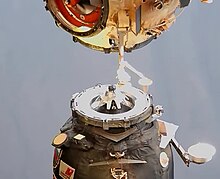
Nauka (Russian: Наука, lit. 'Science'), also known as the Multipurpose Laboratory Module-Upgrade (MLM-U), (Russian: Многоцелевой лабораторный модуль, усоверше́нствованный, or МЛМ-У), is a Roscosmos-funded component of the ISS that was launched on 21 July 2021, 14:58 UTC. In the original ISS plans, Nauka was to use the location of the Docking and Stowage Module (DSM), but the DSM was later replaced by the Rassvet module and moved to Zarya's nadir port. Nauka was successfully docked to Zvezda's nadir port on 29 July 2021, 13:29 UTC, replacing the Pirs module.
It had a temporary docking adapter on its nadir port for crewed and uncrewed missions until Prichal arrival, where just before its arrival it was removed by a departing Progress spacecraft.[159]
Prichal
[edit]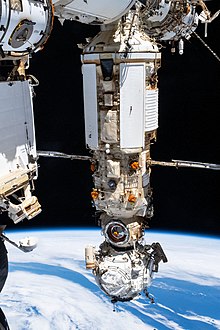
Prichal, also known as Uzlovoy Module or UM (Russian: Узловой Модуль Причал, lit. 'Nodal Module Berth'),[160] is a 4-tonne (8,800 lb)[161] ball-shaped module that will provide the Russian segment additional docking ports to receive Soyuz MS and Progress MS spacecraft. UM was launched in November 2021.[162] It was integrated with a special version of the Progress cargo spacecraft and launched by a standard Soyuz rocket, docking to the nadir port of the Nauka module. One port is equipped with an active hybrid docking port, which enables docking with the MLM module. The remaining five ports are passive hybrids, enabling docking of Soyuz and Progress vehicles, as well as heavier modules and future spacecraft with modified docking systems. The node module was intended to serve as the only permanent element of the cancelled Orbital Piloted Assembly and Experiment Complex (OPSEK).[162][163][164]
Unpressurised elements
[edit]The ISS has a large number of external components that do not require pressurisation. The largest of these is the Integrated Truss Structure (ITS), to which the station's main solar arrays and thermal radiators are mounted.[165] The ITS consists of ten separate segments forming a structure 108.5 metres (356 ft) long.[9]
The station was intended to have several smaller external components, such as six robotic arms, three External Stowage Platforms (ESPs) and four ExPRESS Logistics Carriers (ELCs).[166][167] While these platforms allow experiments (including MISSE, the STP-H3 and the Robotic Refueling Mission) to be deployed and conducted in the vacuum of space by providing electricity and processing experimental data locally, their primary function is to store spare Orbital Replacement Units (ORUs). ORUs are parts that can be replaced when they fail or pass their design life, including pumps, storage tanks, antennas, and battery units. Such units are replaced either by astronauts during EVA or by robotic arms.[168] Several shuttle missions were dedicated to the delivery of ORUs, including STS-129,[169] STS-133[170] and STS-134.[171] As of January 2011[update], only one other mode of transportation of ORUs had been used – the Japanese cargo vessel HTV-2 – which delivered an FHRC and CTC-2 via its Exposed Pallet (EP).[172][needs update]
There are also smaller exposure facilities mounted directly to laboratory modules; the Kibō Exposed Facility serves as an external "porch" for the Kibō complex,[173] and a facility on the European Columbus laboratory provides power and data connections for experiments such as the European Technology Exposure Facility[174][175] and the Atomic Clock Ensemble in Space.[176] A remote sensing instrument, SAGE III-ISS, was delivered to the station in February 2017 aboard CRS-10,[177] and the NICER experiment was delivered aboard CRS-11 in June 2017.[178] The largest scientific payload externally mounted to the ISS is the Alpha Magnetic Spectrometer (AMS), a particle physics experiment launched on STS-134 in May 2011, and mounted externally on the ITS. The AMS measures cosmic rays to look for evidence of dark matter and antimatter.[179][180]
The commercial Bartolomeo External Payload Hosting Platform, manufactured by Airbus, was launched on 6 March 2020 aboard CRS-20 and attached to the European Columbus module. It will provide an additional 12 external payload slots, supplementing the eight on the ExPRESS Logistics Carriers, ten on Kibō, and four on Columbus. The system is designed to be robotically serviced and will require no astronaut intervention. It is named after Christopher Columbus's younger brother.[181][182][183]
MLM outfittings
[edit]In May 2010, equipment for Nauka was launched on STS-132 (as part of an agreement with NASA) and delivered by Space Shuttle Atlantis. Weighing 1.4 metric tons, the equipment was attached to the outside of Rassvet (MRM-1). It included a spare elbow joint for the European Robotic Arm (ERA) (which was launched with Nauka) and an ERA-portable workpost used during EVAs, as well as RTOd add-on heat radiator and internal hardware alongside the pressurized experiment airlock.[150]
The RTOd radiator adds additional cooling capability to Nauka, which enables the module to host more scientific experiments.[150]
The ERA was used to remove the RTOd radiator from Rassvet and transferred over to Nauka during VKD-56 spacewalk. Later it was activated and fully deployed on VKD-58 spacewalk.[184] This process took several months. A portable work platform was also transferred over in August 2023 during VKD-60 spacewalk, which can attach to the end of the ERA to allow cosmonauts to "ride" on the end of the arm during spacewalks.[185][186] However, even after several months of outfitting EVAs and RTOd heat radiator installation, six months later, the RTOd radiator malfunctioned before active use of Nauka (the purpose of RTOd installation is to radiate heat from Nauka experiments). The malfunction, a leak, rendered the RTOd radiator unusable for Nauka. This is the third ISS radiator leak after Soyuz MS-22 and Progress MS-21 radiator leaks. If a spare RTOd is not available, Nauka experiments will have to rely on Nauka's main launch radiator and the module could never be used to its full capacity.[187][188]
Another MLM outfitting is a 4 segment external payload interface called means of attachment of large payloads (Sredstva Krepleniya Krupnogabaritnykh Obyektov, SKKO).[189] Delivered in two parts to Nauka by Progress MS-18 (LCCS part) and Progress MS-21 (SCCCS part) as part of the module activation outfitting process.[190][191][192][193] It was taken outside and installed on the ERA aft facing base point on Nauka during the VKD-55 spacewalk.[194][195][196][197]
Robotic arms and cargo cranes
[edit]Strela crane (which is holding photographer Oleg Kononenko)
The Integrated Truss Structure (ITS) serves as a base for the station's primary remote manipulator system, the Mobile Servicing System (MSS), which is composed of three main components:
- Canadarm2, the largest robotic arm on the ISS, has a mass of 1,800 kilograms (4,000 lb) and is used to: dock and manipulate spacecraft and modules on the USOS; hold crew members and equipment in place during EVAs; and move Dextre to perform tasks.[198]
- Dextre is a 1,560 kg (3,440 lb) robotic manipulator that has two arms and a rotating torso, with power tools, lights, and video for replacing orbital replacement units (ORUs) and performing other tasks requiring fine control.[199]
- The Mobile Base System (MBS) is a platform that rides on rails along the length of the station's main truss, which serves as a mobile base for Canadarm2 and Dextre, allowing the robotic arms to reach all parts of the USOS.[200]
A grapple fixture was added to Zarya on STS-134 to enable Canadarm2 to inchworm itself onto the ROS.[171] Also installed during STS-134 was the 15 m (50 ft) Orbiter Boom Sensor System (OBSS), which had been used to inspect heat shield tiles on Space Shuttle missions and which can be used on the station to increase the reach of the MSS.[171] Staff on Earth or the ISS can operate the MSS components using remote control, performing work outside the station without the need for space walks.
Japan's Remote Manipulator System, which services the Kibō Exposed Facility,[201] was launched on STS-124 and is attached to the Kibō Pressurised Module.[202] The arm is similar to the Space Shuttle arm as it is permanently attached at one end and has a latching end effector for standard grapple fixtures at the other.
The European Robotic Arm, which will service the ROS, was launched alongside the Nauka module.[203] The ROS does not require spacecraft or modules to be manipulated, as all spacecraft and modules dock automatically and may be discarded the same way. Crew use the two Strela (Russian: Стрела́, lit. 'Arrow') cargo cranes during EVAs for moving crew and equipment around the ROS. Each Strela crane has a mass of 45 kg (99 lb).
Former module
[edit]Pirs
[edit]Pirs (Russian: Пирс, lit. 'Pier') was launched on 14 September 2001, as ISS Assembly Mission 4R, on a Russian Soyuz-U rocket, using a modified Progress spacecraft, Progress M-SO1, as an upper stage. Pirs was undocked by Progress MS-16 on 26 July 2021, 10:56 UTC, and deorbited on the same day at 14:51 UTC to make room for Nauka module to be attached to the space station. Prior to its departure, Pirs served as the primary Russian airlock on the station, being used to store and refurbish the Russian Orlan spacesuits.
Planned components
[edit]Axiom segment
[edit]
In January 2020, NASA awarded Axiom Space a contract to build a commercial module for the ISS. The contract is under the NextSTEP2 program. NASA negotiated with Axiom on a firm fixed-price contract basis to build and deliver the module, which will attach to the forward port of the space station's Harmony (Node 2) module. Although NASA has only commissioned one module, Axiom plans to build an entire segment consisting of five modules, including a node module, an orbital research and manufacturing facility, a crew habitat, and a "large-windowed Earth observatory". The Axiom segment is expected to greatly increase the capabilities and value of the space station, allowing for larger crews and private spaceflight by other organisations. Axiom plans to convert the segment into a stand-alone space station once the ISS is decommissioned, with the intention that this would act as a successor to the ISS.[204][205][206] Canadarm 2 will also help to berth the Axiom Space Station modules to the ISS and will continue its operations on the Axiom Space Station after the retirement of ISS in late 2020s.[207]
As of December 2023, Axiom Space expects to launch the first module, Hab One, at the end of 2026.[208]
US Deorbit Vehicle
[edit]The US Deorbit Vehicle is a NASA-provided spacecraft intended to perform a controlled de-orbit and demise of the station after the end of its operational life in 2030. In June 2024, NASA awarded SpaceX a contract to build the Deorbit Vehicle.[2]
Proposed components
[edit]Independence-1
[edit]Nanoracks, after finalizing its contract with NASA, and after winning NextSTEPs Phase II award, is now developing its concept Independence-1 (previously known as Ixion), which would turn spent rocket tanks into a habitable living area to be tested in space. In Spring 2018, Nanoracks announced that Ixion is now known as the Independence-1, the first 'outpost' in Nanoracks' Space Outpost Program.
Cancelled components
[edit]Several modules developed or planned for the station were cancelled over the course of the ISS programme. Reasons include budgetary constraints, the modules becoming unnecessary, and station redesigns after the 2003 Columbia disaster. The US Centrifuge Accommodations Module would have hosted science experiments in varying levels of artificial gravity.[209] The US Habitation Module would have served as the station's living quarters. Instead, the living quarters are now spread throughout the station.[210] The US Interim Control Module and ISS Propulsion Module would have replaced the functions of Zvezda in case of a launch failure.[211] Two Russian Research Modules were planned for scientific research.[212] They would have docked to a Russian Universal Docking Module.[213] The Russian Science Power Platform would have supplied power to the Russian Orbital Segment independent of the ITS solar arrays.
Science Power Modules 1 and 2 (Repurposed Components)
[edit]Science Power Module 1 (SPM-1, also known as NEM-1) and Science Power Module 2 (SPM-2, also known as NEM-2) are modules that were originally planned to arrive at the ISS no earlier than 2024, and dock to the Prichal module, which is docked to the Nauka module.[164][214] In April 2021, Roscosmos announced that NEM-1 would be repurposed to function as the core module of the proposed Russian Orbital Service Station (ROSS), launching no earlier than 2027[215] and docking to the free-flying Nauka module.[216][217] NEM-2 may be converted into another core "base" module, which would be launched in 2028.[218]
Xbase
[edit]Designed by Bigelow Aerospace. In August 2016, Bigelow negotiated an agreement with NASA to develop a full-size ground prototype Deep Space Habitation based on the B330 under the second phase of Next Space Technologies for Exploration Partnerships. The module was called the Expandable Bigelow Advanced Station Enhancement (XBASE), as Bigelow hoped to test the module by attaching it to the International Space Station. However, in March 2020, Bigelow laid off all 88 of its employees, and as of February 2024[update] the company remains dormant and is considered defunct,[219][220] making it appear unlikely that the XBASE module will ever be launched.
Nautilus-X Centrifuge Demonstration
[edit]A proposal was put forward in 2011 for a first in-space demonstration of a sufficiently scaled centrifuge for artificial partial-g gravity effects. It was designed to become a sleep module for the ISS crew. The project was cancelled in favour of other projects due to budget constraints.[221]
Onboard systems
[edit]Life support
[edit]The critical systems are the atmosphere control system, the water supply system, the food supply facilities, the sanitation and hygiene equipment, and fire detection and suppression equipment. The Russian Orbital Segment's life support systems are contained in the Zvezda service module. Some of these systems are supplemented by equipment in the USOS. The Nauka laboratory has a complete set of life support systems.
Atmospheric control systems
[edit]
The atmosphere on board the ISS is similar to that of Earth.[222] Normal air pressure on the ISS is 101.3 kPa (14.69 psi);[223] the same as at sea level on Earth. An Earth-like atmosphere offers benefits for crew comfort, and is much safer than a pure oxygen atmosphere, because of the increased risk of a fire such as that responsible for the deaths of the Apollo 1 crew.[224][better source needed] Earth-like atmospheric conditions have been maintained on all Russian and Soviet spacecraft.[225]
The Elektron system aboard Zvezda and a similar system in Destiny generate oxygen aboard the station.[226] The crew has a backup option in the form of bottled oxygen and Solid Fuel Oxygen Generation (SFOG) canisters, a chemical oxygen generator system.[227] Carbon dioxide is removed from the air by the Vozdukh system in Zvezda. Other by-products of human metabolism, such as methane from the intestines and ammonia from sweat, are removed by activated charcoal filters.[227]
Part of the ROS atmosphere control system is the oxygen supply. Triple-redundancy is provided by the Elektron unit, solid fuel generators, and stored oxygen. The primary supply of oxygen is the Elektron unit which produces O2 and H2 by electrolysis of water and vents H2 overboard. The 1 kW (1.3 hp) system uses approximately one litre of water per crew member per day. This water is either brought from Earth or recycled from other systems. Mir was the first spacecraft to use recycled water for oxygen production. The secondary oxygen supply is provided by burning oxygen-producing Vika cartridges (see also ISS ECLSS). Each 'candle' takes 5–20 minutes to decompose at 450–500 °C (842–932 °F), producing 600 litres (130 imp gal; 160 US gal) of O2. This unit is manually operated.[228]
The US Orbital Segment (USOS) has redundant supplies of oxygen, from a pressurised storage tank on the Quest airlock module delivered in 2001, supplemented ten years later by ESA-built Advanced Closed-Loop System (ACLS) in the Tranquility module (Node 3), which produces O2 by electrolysis.[229] Hydrogen produced is combined with carbon dioxide from the cabin atmosphere and converted to water and methane.
Power and thermal control
[edit]Double-sided solar arrays provide electrical power to the ISS. These bifacial cells collect direct sunlight on one side and light reflected off from the Earth on the other, and are more efficient and operate at a lower temperature than single-sided cells commonly used on Earth.[230]
The Russian segment of the station, like most spacecraft, uses 28 V low voltage DC from two rotating solar arrays mounted on Zvezda. The USOS uses 130–180 V DC from the USOS PV array. Power is stabilised and distributed at 160 V DC and converted to the user-required 124 V DC. The higher distribution voltage allows smaller, lighter conductors, at the expense of crew safety. The two station segments share power with converters.
The USOS solar arrays are arranged as four wing pairs, for a total production of 75 to 90 kilowatts.[4] These arrays normally track the Sun to maximise power generation. Each array is about 375 m2 (4,036 sq ft) in area and 58 m (190 ft) long. In the complete configuration, the solar arrays track the Sun by rotating the alpha gimbal once per orbit; the beta gimbal follows slower changes in the angle of the Sun to the orbital plane. The Night Glider mode aligns the solar arrays parallel to the ground at night to reduce the significant aerodynamic drag at the station's relatively low orbital altitude.[231]
The station originally used rechargeable nickel–hydrogen batteries (NiH2) for continuous power during the 45 minutes of every 90-minute orbit that it is eclipsed by the Earth. The batteries are recharged on the day side of the orbit. They had a 6.5-year lifetime (over 37,000 charge/discharge cycles) and were regularly replaced over the anticipated 20-year life of the station.[232] Starting in 2016, the nickel–hydrogen batteries were replaced by lithium-ion batteries, which are expected to last until the end of the ISS program.[233]
The station's large solar panels generate a high potential voltage difference between the station and the ionosphere. This could cause arcing through insulating surfaces and sputtering of conductive surfaces as ions are accelerated by the spacecraft plasma sheath. To mitigate this, plasma contactor units create current paths between the station and the ambient space plasma.[234]

The station's systems and experiments consume a large amount of electrical power, almost all of which is converted to heat. To keep the internal temperature within workable limits, a passive thermal control system (PTCS) is made of external surface materials, insulation such as MLI, and heat pipes. If the PTCS cannot keep up with the heat load, an External Active Thermal Control System (EATCS) maintains the temperature. The EATCS consists of an internal, non-toxic, water coolant loop used to cool and dehumidify the atmosphere, which transfers collected heat into an external liquid ammonia loop. From the heat exchangers, ammonia is pumped into external radiators that emit heat as infrared radiation, then the ammonia is cycled back to the station.[235] The EATCS provides cooling for all the US pressurised modules, including Kibō and Columbus, as well as the main power distribution electronics of the S0, S1 and P1 trusses. It can reject up to 70 kW. This is much more than the 14 kW of the Early External Active Thermal Control System (EEATCS) via the Early Ammonia Servicer (EAS), which was launched on STS-105 and installed onto the P6 Truss.[236]
Communications and computers
[edit]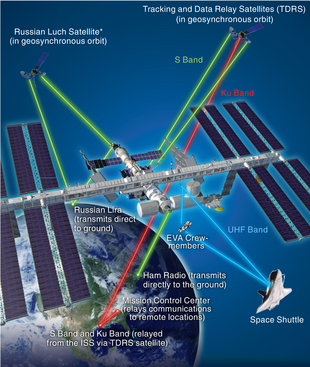
* Luch and the Space Shuttle are not in use as of 2020.
Radio communications provide telemetry and scientific data links between the station and mission control centres. Radio links are also used during rendezvous and docking procedures and for audio and video communication between crew members, flight controllers and family members. As a result, the ISS is equipped with internal and external communication systems used for different purposes.[237]
The Russian Orbital Segment communicates directly with the ground via the Lira antenna mounted to Zvezda.[70][238] The Lira antenna also has the capability to use the Luch data relay satellite system.[70] This system fell into disrepair during the 1990s, and so was not used during the early years of the ISS,[70][239][240] although two new Luch satellites – Luch-5A and Luch-5B – were launched in 2011 and 2012 respectively to restore the operational capability of the system.[241] Another Russian communications system is the Voskhod-M, which enables internal telephone communications between Zvezda, Zarya, Pirs, Poisk, and the USOS and provides a VHF radio link to ground control centres via antennas on Zvezda's exterior.[242]
The US Orbital Segment (USOS) makes use of two separate radio links: S band (audio, telemetry, commanding – located on the P1/S1 truss) and Ku band (audio, video and data – located on the Z1 truss) systems. These transmissions are routed via the United States Tracking and Data Relay Satellite System (TDRSS) in geostationary orbit, allowing for almost continuous real-time communications with Christopher C. Kraft Jr. Mission Control Center (MCC-H) in Houston, Texas.[70][243][237] Data channels for the Canadarm2, European Columbus laboratory and Japanese Kibō modules were originally also routed via the S band and Ku band systems, with the European Data Relay System and a similar Japanese system intended to eventually complement the TDRSS in this role.[243][244] Communications between modules are carried on an internal wireless network.[245]
UHF radio is used by astronauts and cosmonauts conducting EVAs and other spacecraft that dock to or undock from the station.[70] Automated spacecraft are fitted with their own communications equipment; the ATV used a laser attached to the spacecraft and the Proximity Communications Equipment attached to Zvezda to accurately dock with the station.[246][247]
The ISS is equipped with about 100 IBM/Lenovo ThinkPad and HP ZBook 15 laptop computers. The laptops have run Windows 95, Windows 2000, Windows XP, Windows 7, Windows 10 and Linux operating systems.[248] Each computer is a commercial off-the-shelf purchase which is then modified for safety and operation including updates to connectors, cooling and power to accommodate the station's 28V DC power system and weightless environment. Heat generated by the laptops does not rise but stagnates around the laptop, so additional forced ventilation is required. Portable Computer System (PCS) laptops connect to the Primary Command & Control computer (C&C MDM) as remote terminals via a USB to 1553 adapter.[249] Station Support Computer (SSC) laptops aboard the ISS are connected to the station's wireless LAN via Wi-Fi and ethernet, which connects to the ground via Ku band. While originally this provided speeds of 10 Mbit/s download and 3 Mbit/s upload from the station,[250][251] NASA upgraded the system in late August 2019 and increased the speeds to 600 Mbit/s.[252] Laptop hard drives occasionally fail and must be replaced.[253] Other computer hardware failures include instances in 2001, 2007 and 2017; some of these failures have required EVAs to replace computer modules in externally mounted devices.[254][255][256][257]
The operating system used for key station functions is the Debian Linux distribution.[258] The migration from Microsoft Windows to Linux was made in May 2013 for reasons of reliability, stability and flexibility.[259]
In 2017, an SG100 Cloud Computer was launched to the ISS as part of OA-7 mission.[260] It was manufactured by NCSIST of Taiwan and designed in collaboration with Academia Sinica, and National Central University under contract for NASA.[261]
ISS crew members have access to the Internet, and thus the World Wide Web.[262][263] This was first enabled in 2010,[262] allowing NASA astronaut T. J. Creamer to make the first tweet from space.[264] Access is achieved via an Internet-enabled computer in Houston, Texas, using remote desktop mode, thereby protecting the ISS from virus infection and hacking attempts.[262]
Operations
[edit]Expeditions
[edit]Each permanent crew is given an expedition number. Expeditions run up to six months, from launch until undocking, an 'increment' covers the same time period, but includes cargo spacecraft and all activities. Expeditions 1 to 6 consisted of three-person crews. Expeditions 7 to 12 were reduced to the safe minimum of two following the destruction of the NASA Shuttle Columbia. From Expedition 13 the crew gradually increased to six around 2010.[265][266] With the arrival of crew on US commercial vehicles beginning in 2020,[267] NASA has indicated that expedition size may be increased to seven crew members, the number for which ISS was originally designed.[268][269]
Gennady Padalka, member of Expeditions 9, 19/20, 31/32, and 43/44, and Commander of Expedition 11, has spent more time in space than anyone else, a total of 878 days, 11 hours, and 29 minutes.[270] Peggy Whitson has spent the most time in space of any American, totalling 675 days, 3 hours and 48 minutes during her time on Expeditions 5, 16, and 50/51/52 and Axiom Mission 2.[271][272]
Private flights
[edit]Travellers who pay for their own passage into space are termed spaceflight participants by Roscosmos and NASA, and are sometimes referred to as "space tourists", a term they generally dislike.[e] As of June 2023[update], thirteen space tourists have visited the ISS; nine were transported to the ISS on Russian Soyuz spacecraft, and four were transported on American SpaceX Dragon 2 spacecraft. For one-tourist missions, when professional crews change over in numbers not divisible by the three seats in a Soyuz, and a short-stay crewmember is not sent, the spare seat is sold by MirCorp through Space Adventures. Space tourism was halted in 2011 when the Space Shuttle was retired and the station's crew size was reduced to six, as the partners relied on Russian transport seats for access to the station. Soyuz flight schedules increased after 2013, allowing five Soyuz flights (15 seats) with only two expeditions (12 seats) required.[280] The remaining seats were to be sold for around US$40 million each to members of the public who could pass a medical exam. ESA and NASA criticised private spaceflight at the beginning of the ISS, and NASA initially resisted training Dennis Tito, the first person to pay for his own passage to the ISS.[f]
Anousheh Ansari became the first self-funded woman to fly to the ISS as well as the first Iranian in space. Officials reported that her education and experience made her much more than a tourist, and her performance in training had been "excellent."[281] She did Russian and European studies involving medicine and microbiology during her 10-day stay. The 2009 documentary Space Tourists follows her journey to the station, where she fulfilled "an age-old dream of man: to leave our planet as a 'normal person' and travel into outer space."[282]
In 2008, spaceflight participant Richard Garriott placed a geocache aboard the ISS during his flight.[283] This is currently the only non-terrestrial geocache in existence.[284] At the same time, the Immortality Drive, an electronic record of eight digitised human DNA sequences, was placed aboard the ISS.[285]
After a 12-year hiatus, the first two wholly space tourism-dedicated private spaceflights to the ISS were undertaken. Soyuz MS-20 launched in December 2021, carrying visiting Roscosmos cosmonaut Alexander Misurkin and two Japanese space tourists under the aegis of the private company Space Adventures;[286][287] in April 2022, the company Axiom Space chartered a SpaceX Dragon 2 spacecraft and sent its own employee astronaut Michael Lopez-Alegria and three space tourists to the ISS for Axiom Mission 1,[288][289][290] followed in May 2023 by one more tourist, John Shoffner, alongside employee astronaut Peggy Whitson and two Saudi astronauts for the Axiom Mission 2.[291][292]
Fleet operations
[edit]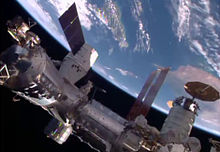
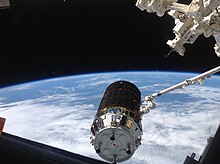
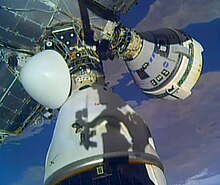
A wide variety of crewed and uncrewed spacecraft have supported the station's activities. Flights to the ISS include 37 Space Shuttle missions, 83 Progress resupply spacecraft (including the modified M-MIM2, DC-1 and M-UM module transports), 63 crewed Soyuz spacecraft, 5 European ATVs, 9 Japanese HTVs, 1 Boeing Starliner, 30 SpaceX Dragon (both crewed and uncrewed) and 18 Cygnus missions.[293]
There are currently eleven available docking ports for visiting spacecraft:[294]
- Harmony forward (with IDA 2)
- Harmony zenith (with IDA 3)
- Harmony nadir
- Unity nadir
- Prichal nadir
- Prichal aft
- Prichal forward
- Prichal starboard
- Prichal port
- Poisk zenith
- Rassvet nadir
- Zvezda aft
Crewed
[edit]As of 22 May 2023[ref], 269 people from 21 countries had visited the space station, many of them multiple times. The United States sent 163 people, Russia sent 57, Japan sent 11, Canada sent nine, Italy sent five, France and Germany each sent four, the United Arab Emirates, Saudi Arabia and Sweden each sent two, and there were one each from Belgium, Brazil, Denmark, the United Kingdom, Kazakhstan, Malaysia, the Netherlands, South Africa, South Korea, Spain, and Israel.[295]
Uncrewed
[edit]Uncrewed spaceflights to the ISS are made primarily to deliver cargo, however several Russian modules have also docked to the outpost following uncrewed launches. Resupply missions typically use the Russian Progress spacecraft, former European ATVs, Japanese Kounotori vehicles, and the American Dragon and Cygnus spacecraft. The primary docking system for Progress spacecraft is the automated Kurs system, with the manual TORU system as a backup. ATVs also used Kurs, however they were not equipped with TORU. Progress and former ATV can remain docked for up to six months.[296][297] The other spacecraft – the Japanese HTV, the SpaceX Dragon (under CRS phase 1), and the Northrop Grumman[298] Cygnus – rendezvous with the station before being grappled using Canadarm2 and berthed at the nadir port of the Harmony or Unity module for one to two months. Under CRS phase 2, Cargo Dragon docks autonomously at IDA-2 or IDA-3. As of December 2020[update], Progress spacecraft have flown most of the uncrewed missions to the ISS.
Soyuz MS-22 was launched in 2022. A possible micro-meteoroid impact in December 2022 caused a coolant leak in its external radiator and it was considered risky for human landing. Thus MS-22 reentered uncrewed on 28 March 2023 and Soyuz MS-23 was launched uncrewed on 24 February 2023, and it returned the MS-22 crew.[299][300][301][1]
Currently docked/berthed
[edit]
| Spacecraft | Type | Mission | Location | Arrival (UTC) | Departure (planned) | |
|---|---|---|---|---|---|---|
| Progress MS No. 456 | Uncrewed | Progress MS-26 | Zvezda aft | 17 February 2024[302][303] | NET 13 August 2024 | |
| Crew Dragon Endeavour | Crewed | Crew-8 | Harmony zenith | 5 March 2024[304] | NET August 2024 | |
| Soyuz MS No. 756 Kazbek | Crewed | Soyuz MS-25 | Prichal nadir | 25 March 2024 | NET 24 September 2024 | |
| Progress MS No. 457 | Uncrewed | Progress MS-27 | Poisk zenith | 1 June 2024[302][303] | NET 19 November 2024 | |
| Boeing Starliner Calypso | Crewed | Boe-CFT | Harmony forward | 6 June 2024 | TBD | |
Scheduled missions
[edit]- All dates are UTC. Dates are the earliest possible dates and may change.
- Forward ports are at the front of the station according to its normal direction of travel and orientation (attitude). Aft is at the rear of the station, used by spacecraft boosting the station's orbit. Nadir is closest the Earth, zenith is on top. Port is to the left if pointing one's feet towards the Earth and looking in the direction of travel; starboard to the right.
Docking
[edit]

All Russian spacecraft and self-propelled modules are able to rendezvous and dock to the space station without human intervention using the Kurs radar docking system from over 200 kilometres away. The European ATV uses star sensors and GPS to determine its intercept course. When it catches up it uses laser equipment to optically recognise Zvezda, along with the Kurs system for redundancy. Crew supervise these craft, but do not intervene except to send abort commands in emergencies. Progress and ATV supply craft can remain at the ISS for six months,[296][297] allowing great flexibility in crew time for loading and unloading of supplies and trash.
From the initial station programs, the Russians pursued an automated docking methodology that used the crew in override or monitoring roles. Although the initial development costs were high, the system has become very reliable with standardisations that provide significant cost benefits in repetitive operations.[307]
Soyuz spacecraft used for crew rotation also serve as lifeboats for emergency evacuation; they are replaced every six months and were used after the Columbia disaster to return stranded crew from the ISS.[308] The average expedition requires 2,722 kg of supplies, and by 9 March 2011, crews had consumed a total of around 22,000 meals.[94] Soyuz crew rotation flights and Progress resupply flights visit the station on average two and three times respectively each year.[309]
Other vehicles berth instead of docking. The Japanese H-II Transfer Vehicle parked itself in progressively closer orbits to the station, and then awaited 'approach' commands from the crew, until it was close enough for a robotic arm to grapple and berth the vehicle to the USOS. Berthed craft can transfer International Standard Payload Racks. Japanese spacecraft berth for one to two months.[310] The berthing Cygnus and SpaceX Dragon were contracted to fly cargo to the station under phase 1 of the Commercial Resupply Services program.[311][312]
From 26 February 2011 to 7 March 2011 four of the governmental partners (United States, ESA, Japan and Russia) had their spacecraft (NASA Shuttle, ATV, HTV, Progress and Soyuz) docked at the ISS, the only time this has happened to date.[313] On 25 May 2012, SpaceX delivered the first commercial cargo with a Dragon spacecraft.[314]
Launch and docking windows
[edit]Prior to a spacecraft's docking to the ISS, navigation and attitude control (GNC) is handed over to the ground control of the spacecraft's country of origin. GNC is set to allow the station to drift in space, rather than fire its thrusters or turn using gyroscopes. The solar panels of the station are turned edge-on to the incoming spacecraft, so residue from its thrusters does not damage the cells. Before its retirement, Shuttle launches were often given priority over Soyuz, with occasional priority given to Soyuz arrivals carrying crew and time-critical cargoes, such as biological experiment materials.[315]
Repairs
[edit]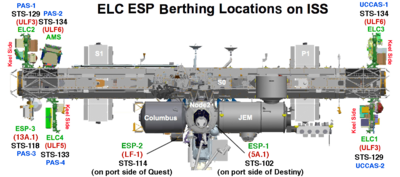
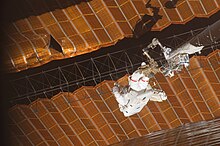

Orbital Replacement Units (ORUs) are spare parts that can be readily replaced when a unit either passes its design life or fails. Examples of ORUs are pumps, storage tanks, controller boxes, antennas, and battery units. Some units can be replaced using robotic arms. Most are stored outside the station, either on small pallets called ExPRESS Logistics Carriers (ELCs) or share larger platforms called External Stowage Platforms (ESPs) which also hold science experiments. Both kinds of pallets provide electricity for many parts that could be damaged by the cold of space and require heating. The larger logistics carriers also have local area network (LAN) connections for telemetry to connect experiments. A heavy emphasis on stocking the USOS with ORU's occurred around 2011, before the end of the NASA shuttle programme, as its commercial replacements, Cygnus and Dragon, carry one tenth to one quarter the payload.
Unexpected problems and failures have impacted the station's assembly time-line and work schedules leading to periods of reduced capabilities and, in some cases, could have forced abandonment of the station for safety reasons. Serious problems include an air leak from the USOS in 2004,[316] the venting of fumes from an Elektron oxygen generator in 2006,[317] and the failure of the computers in the ROS in 2007 during STS-117 that left the station without thruster, Elektron, Vozdukh and other environmental control system operations. In the latter case, the root cause was found to be condensation inside electrical connectors leading to a short circuit.[318]
During STS-120 in 2007 and following the relocation of the P6 truss and solar arrays, it was noted during unfurling that the solar array had torn and was not deploying properly.[319] An EVA was carried out by Scott Parazynski, assisted by Douglas Wheelock. Extra precautions were taken to reduce the risk of electric shock, as the repairs were carried out with the solar array exposed to sunlight.[320] The issues with the array were followed in the same year by problems with the starboard Solar Alpha Rotary Joint (SARJ), which rotates the arrays on the starboard side of the station. Excessive vibration and high-current spikes in the array drive motor were noted, resulting in a decision to substantially curtail motion of the starboard SARJ until the cause was understood. Inspections during EVAs on STS-120 and STS-123 showed extensive contamination from metallic shavings and debris in the large drive gear and confirmed damage to the large metallic bearing surfaces, so the joint was locked to prevent further damage.[321][322] Repairs to the joints were carried out during STS-126 with lubrication and the replacement of 11 out of 12 trundle bearings on the joint.[323][324]
In September 2008, damage to the S1 radiator was first noticed in Soyuz imagery. The problem was initially not thought to be serious.[325] The imagery showed that the surface of one sub-panel had peeled back from the underlying central structure, possibly because of micro-meteoroid or debris impact. On 15 May 2009, the damaged radiator panel's ammonia tubing was mechanically shut off from the rest of the cooling system by the computer-controlled closure of a valve. The same valve was then used to vent the ammonia from the damaged panel, eliminating the possibility of an ammonia leak.[325] It is also known that a Service Module thruster cover struck the S1 radiator after being jettisoned during an EVA in 2008, but its effect, if any, has not been determined.
In the early hours of 1 August 2010, a failure in cooling Loop A (starboard side), one of two external cooling loops, left the station with only half of its normal cooling capacity and zero redundancy in some systems.[326][327][328] The problem appeared to be in the ammonia pump module that circulates the ammonia cooling fluid. Several subsystems, including two of the four CMGs, were shut down.
Planned operations on the ISS were interrupted through a series of EVAs to address the cooling system issue. A first EVA on 7 August 2010, to replace the failed pump module, was not fully completed because of an ammonia leak in one of four quick-disconnects. A second EVA on 11 August removed the failed pump module.[329][330] A third EVA was required to restore Loop A to normal functionality.[331][332]
The USOS's cooling system is largely built by the US company Boeing,[333] which is also the manufacturer of the failed pump.[326]
The four Main Bus Switching Units (MBSUs, located in the S0 truss), control the routing of power from the four solar array wings to the rest of the ISS. Each MBSU has two power channels that feed 160V DC from the arrays to two DC-to-DC power converters (DDCUs) that supply the 124V power used in the station. In late 2011, MBSU-1 ceased responding to commands or sending data confirming its health. While still routing power correctly, it was scheduled to be swapped out at the next available EVA. A spare MBSU was already on board, but a 30 August 2012 EVA failed to be completed when a bolt being tightened to finish installation of the spare unit jammed before the electrical connection was secured.[334] The loss of MBSU-1 limited the station to 75% of its normal power capacity, requiring minor limitations in normal operations until the problem could be addressed.
On 5 September 2012, in a second six-hour EVA, astronauts Sunita Williams and Akihiko Hoshide successfully replaced MBSU-1 and restored the ISS to 100% power.[335]
On 24 December 2013, astronauts installed a new ammonia pump for the station's cooling system. The faulty cooling system had failed earlier in the month, halting many of the station's science experiments. Astronauts had to brave a "mini blizzard" of ammonia while installing the new pump. It was only the second Christmas Eve spacewalk in NASA history.[336]
Mission control centres
[edit]The components of the ISS are operated and monitored by their respective space agencies at mission control centres across the globe, including RKA Mission Control Center, ATV Control Centre, JEM Control Center and HTV Control Center at Tsukuba Space Center, Christopher C. Kraft Jr. Mission Control Center, Payload Operations and Integration Center, Columbus Control Center and Mobile Servicing System Control.
Life aboard
[edit]Living quarters
[edit]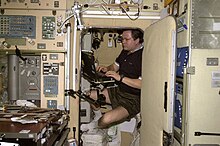
The living and working space on the International Space Station is larger than a six-bedroom house (complete with seven sleeping quarters, two bathrooms, a gym, and a 360-degree view bay window).[337]
Crew activities
[edit]
A typical day for the crew begins with a wake-up at 06:00, followed by post-sleep activities and a morning inspection of the station. The crew then eats breakfast and takes part in a daily planning conference with Mission Control before starting work at around 08:10. The first scheduled exercise of the day follows, after which the crew continues work until 13:05. Following a one-hour lunch break, the afternoon consists of more exercise and work before the crew carries out its pre-sleep activities beginning at 19:30, including dinner and a crew conference. The scheduled sleep period begins at 21:30. In general, the crew works ten hours per day on a weekday, and five hours on Saturdays, with the rest of the time their own for relaxation or work catch-up.[338]
The time zone used aboard the ISS is Coordinated Universal Time (UTC).[339] The windows are covered during night hours to give the impression of darkness because the station experiences 16 sunrises and sunsets per day. During visiting Space Shuttle missions, the ISS crew mostly followed the shuttle's Mission Elapsed Time (MET), which was a flexible time zone based on the launch time of the Space Shuttle mission.[340][341][342]
The station provides crew quarters for each member of the expedition's crew, with two "sleep stations" in the Zvezda, one in Nauka and four more installed in Harmony.[343][344][345][346] The USOS quarters are private, approximately person-sized soundproof booths. The ROS crew quarters in Zvezda include a small window, but provide less ventilation and sound proofing. A crew member can sleep in a crew quarter in a tethered sleeping bag, listen to music, use a laptop, and store personal items in a large drawer or in nets attached to the module's walls. The module also provides a reading lamp, a shelf and a desktop.[347][348][349] Visiting crews have no allocated sleep module, and attach a sleeping bag to an available space on a wall. It is possible to sleep floating freely through the station, but this is generally avoided because of the possibility of bumping into sensitive equipment.[350] It is important that crew accommodations be well ventilated; otherwise, astronauts can wake up oxygen-deprived and gasping for air, because a bubble of their own exhaled carbon dioxide has formed around their heads.[347] During various station activities and crew rest times, the lights in the ISS can be dimmed, switched off, and colour temperatures adjusted.[351][352]
Reflection and material culture
[edit]Reflection of individual and crew characteristics are found particularly in the decoration of the station and expressions in general, such as religion.[353] The latter has produced a certain material economy between the station and Russia in particular.[354]
The micro-society of the station, as well as wider society, and possibly the emergence of distinct station cultures,[355] is being studied by analyzing many aspects, from art to dust accumulation, as well as archaeologically how material of the ISS has been discarded.[356]
Food and personal hygiene
[edit]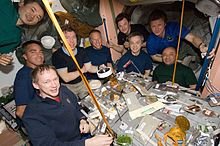
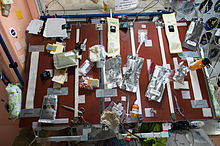
On the USOS, most of the food aboard is vacuum sealed in plastic bags; cans are rare because they are heavy and expensive to transport. Preserved food is not highly regarded by the crew and taste is reduced in microgravity,[347] so efforts are taken to make the food more palatable, including using more spices than in regular cooking. The crew looks forward to the arrival of any spacecraft from Earth as they bring fresh fruit and vegetables. Care is taken that foods do not create crumbs, and liquid condiments are preferred over solid to avoid contaminating station equipment. Each crew member has individual food packages and cooks them in the galley, which has two food warmers, a refrigerator (added in November 2008), and a water dispenser that provides heated and unheated water.[348] Drinks are provided as dehydrated powder that is mixed with water before consumption.[348][349] Drinks and soups are sipped from plastic bags with straws, while solid food is eaten with a knife and fork attached to a tray with magnets to prevent them from floating away. Any food that floats away, including crumbs, must be collected to prevent it from clogging the station's air filters and other equipment.[349]
Showers on space stations were introduced in the early 1970s on Skylab and Salyut 3.[357]: 139 By Salyut 6, in the early 1980s, the crew complained of the complexity of showering in space, which was a monthly activity.[358] The ISS does not feature a shower; instead, crewmembers wash using a water jet and wet wipes, with soap dispensed from a toothpaste tube-like container. Crews are also provided with rinseless shampoo and edible toothpaste to save water.[350][359]
There are two space toilets on the ISS, both of Russian design, located in Zvezda and Tranquility.[348] These Waste and Hygiene Compartments use a fan-driven suction system similar to the Space Shuttle Waste Collection System. Astronauts first fasten themselves to the toilet seat, which is equipped with spring-loaded restraining bars to ensure a good seal.[347] A lever operates a powerful fan and a suction hole slides open: the air stream carries the waste away. Solid waste is collected in individual bags which are stored in an aluminium container. Full containers are transferred to Progress spacecraft for disposal.[348][360] Liquid waste is evacuated by a hose connected to the front of the toilet, with anatomically correct "urine funnel adapters" attached to the tube so that men and women can use the same toilet. The diverted urine is collected and transferred to the Water Recovery System, where it is recycled into drinking water.[349] In 2021, the arrival of the Nauka module also brought a third toilet to the ISS.[361]
Crew health and safety
[edit]Overall
[edit]On 12 April 2019, NASA reported medical results from the Astronaut Twin Study. Astronaut Scott Kelly spent a year in space on the ISS, while his twin spent the year on Earth. Several long-lasting changes were observed, including those related to alterations in DNA and cognition, when one twin was compared with the other.[362][363]
In November 2019, researchers reported that astronauts experienced serious blood flow and clot problems while on board the ISS, based on a six-month study of 11 healthy astronauts. The results may influence long-term spaceflight, including a mission to the planet Mars, according to the researchers.[364][365]
Radiation
[edit]The ISS is partially protected from the space environment by Earth's magnetic field. From an average distance of about 70,000 km (43,000 mi) from the Earth's surface, depending on Solar activity, the magnetosphere begins to deflect solar wind around Earth and the space station. Solar flares are still a hazard to the crew, who may receive only a few minutes warning. In 2005, during the initial "proton storm" of an X-3 class solar flare, the crew of Expedition 10 took shelter in a more heavily shielded part of the ROS designed for this purpose.[366][367]
Subatomic charged particles, primarily protons from cosmic rays and solar wind, are normally absorbed by Earth's atmosphere. When they interact in sufficient quantity, their effect is visible to the naked eye in a phenomenon called an aurora. Outside Earth's atmosphere, ISS crews are exposed to approximately one millisievert each day (about a year's worth of natural exposure on Earth), resulting in a higher risk of cancer. Radiation can penetrate living tissue and damage the DNA and chromosomes of lymphocytes; being central to the immune system, any damage to these cells could contribute to the lower immunity experienced by astronauts. Radiation has also been linked to a higher incidence of cataracts in astronauts. Protective shielding and medications may lower the risks to an acceptable level.[52]
Radiation levels on the ISS are between 12 and 28.8 milli rads per day,[368] about five times greater than those experienced by airline passengers and crew, as Earth's electromagnetic field provides almost the same level of protection against solar and other types of radiation in low Earth orbit as in the stratosphere. For example, on a 12-hour flight, an airline passenger would experience 0.1 millisieverts of radiation, or a rate of 0.2 millisieverts per day; this is one fifth the rate experienced by an astronaut in LEO. Additionally, airline passengers experience this level of radiation for a few hours of flight, while the ISS crew are exposed for their whole stay on board the station.[369]
Stress
[edit]There is considerable evidence that psychosocial stressors are among the most important impediments to optimal crew morale and performance.[370] Cosmonaut Valery Ryumin wrote in his journal during a particularly difficult period on board the Salyut 6 space station: "All the conditions necessary for murder are met if you shut two men in a cabin measuring 18 feet by 20 [5.5 m × 6 m] and leave them together for two months."
NASA's interest in psychological stress caused by space travel, initially studied when their crewed missions began, was rekindled when astronauts joined cosmonauts on the Russian space station Mir. Common sources of stress in early US missions included maintaining high performance under public scrutiny and isolation from peers and family. The latter is still often a cause of stress on the ISS, such as when the mother of NASA astronaut Daniel Tani died in a car accident, and when Michael Fincke was forced to miss the birth of his second child.
A study of the longest spaceflight concluded that the first three weeks are a critical period where attention is adversely affected because of the demand to adjust to the extreme change of environment.[371] ISS crew flights typically last about five to six months.
The ISS working environment includes further stress caused by living and working in cramped conditions with people from very different cultures who speak a different language. First-generation space stations had crews who spoke a single language; second- and third-generation stations have crew from many cultures who speak many languages. Astronauts must speak English and Russian, and knowing additional languages is even better.[372]
Due to the lack of gravity, confusion often occurs. Even though there is no up and down in space, some crew members feel like they are oriented upside down. They may also have difficulty measuring distances. This can cause problems like getting lost inside the space station, pulling switches in the wrong direction or misjudging the speed of an approaching vehicle during docking.[373]
Medical
[edit]
The physiological effects of long-term weightlessness include muscle atrophy, deterioration of the skeleton (osteopenia), fluid redistribution, a slowing of the cardiovascular system, decreased production of red blood cells, balance disorders, and a weakening of the immune system. Lesser symptoms include loss of body mass, and puffiness of the face.[52]
Sleep is regularly disturbed on the ISS because of mission demands, such as incoming or departing spacecraft. Sound levels in the station are unavoidably high. The atmosphere is unable to thermosiphon naturally, so fans are required at all times to process the air which would stagnate in the freefall (zero-G) environment.
To prevent some of the adverse effects on the body, the station is equipped with: two TVIS treadmills (including the COLBERT); the ARED (Advanced Resistive Exercise Device), which enables various weightlifting exercises that add muscle without raising (or compensating for) the astronauts' reduced bone density;[374] and a stationary bicycle. Each astronaut spends at least two hours per day exercising on the equipment.[347][348] Astronauts use bungee cords to strap themselves to the treadmill.[375][376]
Microbiological environmental hazards
[edit]Hazardous molds that can foul air and water filters may develop aboard space stations. They can produce acids that degrade metal, glass, and rubber. They can also be harmful to the crew's health. Microbiological hazards have led to a development of the LOCAD-PTS (a portable test system) which identifies common bacteria and molds faster than standard methods of culturing, which may require a sample to be sent back to Earth.[377] Researchers in 2018 reported, after detecting the presence of five Enterobacter bugandensis bacterial strains on the ISS (none of which are pathogenic to humans), that microorganisms on the ISS should be carefully monitored to continue assuring a medically healthy environment for astronauts.[378][379]
Contamination on space stations can be prevented by reduced humidity, and by using paint that contains mold-killing chemicals, as well as the use of antiseptic solutions. All materials used in the ISS are tested for resistance against fungi.[380] Since 2016, a series of ESA-sponsored experiments have been conducted to test the anti-bacterial properties of various materials, with the goal of developing "smart surfaces" that mitigate bacterial growth in multiple ways, using the best method for a particular circumstance. Dubbed "Microbial Aerosol Tethering on Innovative Surfaces" (MATISS), the programme involves deployment of small plaques containing an array of glass squares covered with different test coatings. They remain on the station for six months before being returned to earth for analysis.[381] The most recent and final experiment of the series was launched on 5 June 2023 aboard the SpaceX CRS-28 cargo mission to ISS, comprising four plaques. Whereas previous experiments in the series were limited to analysis by light microsocopy, this experiment uses quartz glass made of pure silica, which will allow spectrographic analysis. Two of the plaques were returned after eight months and the remaining two after 16 months.[382]
In April 2019, NASA reported that a comprehensive study had been conducted into the microorganisms and fungi present on the ISS. The experiment was performed over a period of 14 months on three different flight missions, and involved taking samples from 8 predefined locations inside the station, then returning them to earth for analysis. In prior experiments, analysis was limited to culture-based methods, thus overlooking microbes which cannot be grown in culture. The present study used molecular-based methods in addition to culturing, resulting in a more complete catalog. The results may be useful in improving the health and safety conditions for astronauts, as well as better understanding other closed-in environments on Earth such as clean rooms used by the pharmaceutical and medical industries.[383][384]
Noise
[edit]Space flight is not inherently quiet, with noise levels exceeding acoustic standards as far back as the Apollo missions.[385][386] For this reason, NASA and the International Space Station international partners have developed noise control and hearing loss prevention goals as part of the health program for crew members. Specifically, these goals have been the primary focus of the ISS Multilateral Medical Operations Panel (MMOP) Acoustics Subgroup since the first days of ISS assembly and operations.[387][388] The effort includes contributions from acoustical engineers, audiologists, industrial hygienists, and physicians who comprise the subgroup's membership from NASA, Roscosmos, the European Space Agency (ESA), the Japanese Aerospace Exploration Agency (JAXA), and the Canadian Space Agency (CSA).
When compared to terrestrial environments, the noise levels incurred by astronauts and cosmonauts on the ISS may seem insignificant and typically occur at levels that would not be of major concern to the Occupational Safety and Health Administration – rarely reaching 85 dBA. But crew members are exposed to these levels 24 hours a day, seven days a week, with current missions averaging six months in duration. These levels of noise also impose risks to crew health and performance in the form of sleep interference and communication, as well as reduced alarm audibility.
Over the 19 plus year history of the ISS, significant efforts have been put forth to limit and reduce noise levels on the ISS. During design and pre-flight activities, members of the Acoustic Subgroup have written acoustic limits and verification requirements, consulted to design and choose the quietest available payloads, and then conducted acoustic verification tests prior to launch.[387]: 5.7.3 During spaceflights, the Acoustics Subgroup has assessed each ISS module's in flight sound levels, produced by a large number of vehicle and science experiment noise sources, to assure compliance with strict acoustic standards. The acoustic environment on ISS changed when additional modules were added during its construction, and as additional spacecraft arrive at the ISS. The Acoustics Subgroup has responded to this dynamic operations schedule by successfully designing and employing acoustic covers, absorptive materials, noise barriers, and vibration isolators to reduce noise levels. Moreover, when pumps, fans, and ventilation systems age and show increased noise levels, this Acoustics Subgroup has guided ISS managers to replace the older, noisier instruments with quiet fan and pump technologies, significantly reducing ambient noise levels.
NASA has adopted most-conservative damage risk criteria (based on recommendations from the National Institute for Occupational Safety and Health and the World Health Organization), in order to protect all crew members. The MMOP Acoustics Subgroup has adjusted its approach to managing noise risks in this unique environment by applying, or modifying, terrestrial approaches for hearing loss prevention to set these conservative limits. One innovative approach has been NASA's Noise Exposure Estimation Tool (NEET), in which noise exposures are calculated in a task-based approach to determine the need for hearing protection devices (HPDs). Guidance for use of HPDs, either mandatory use or recommended, is then documented in the Noise Hazard Inventory, and posted for crew reference during their missions. The Acoustics Subgroup also tracks spacecraft noise exceedances, applies engineering controls, and recommends hearing protective devices to reduce crew noise exposures. Finally, hearing thresholds are monitored on-orbit, during missions.
There have been no persistent mission-related hearing threshold shifts among US Orbital Segment crewmembers (JAXA, CSA, ESA, NASA) during what is approaching 20 years of ISS mission operations, or nearly 175,000 work hours. In 2020, the MMOP Acoustics Subgroup received the Safe-In-Sound Award for Innovation for their combined efforts to mitigate any health effects of noise.[389]
Fire and toxic gases
[edit]An onboard fire or a toxic gas leak are other potential hazards. Ammonia is used in the external radiators of the station and could potentially leak into the pressurised modules.[390]
Orbit, environment, debris and visibility
[edit]Altitude and orbital inclination
[edit]The ISS is currently maintained in a nearly circular orbit with a minimum mean altitude of 370 km (230 mi) and a maximum of 460 km (290 mi),[391] in the centre of the thermosphere, at an inclination of 51.6 degrees to Earth's equator with an eccentricity of 0.007.[citation needed] This orbit was selected because it is the lowest inclination that can be directly reached by Russian Soyuz and Progress spacecraft launched from Baikonur Cosmodrome at 46° N latitude without overflying China or dropping spent rocket stages in inhabited areas.[392][393] It travels at an average speed of 28,000 kilometres per hour (17,000 mph), and completes 15.5 orbits per day (93 minutes per orbit).[5][394] The station's altitude was allowed to fall around the time of each NASA shuttle flight to permit heavier loads to be transferred to the station. After the retirement of the shuttle, the nominal orbit of the space station was raised in altitude (from about 350 km to about 400 km).[395][396] Other, more frequent supply spacecraft do not require this adjustment as they are substantially higher performance vehicles.[35][397]
Atmospheric drag reduces the altitude by about 2 km a month on average. Orbital boosting can be performed by the station's two main engines on the Zvezda service module, or Russian or European spacecraft docked to Zvezda's aft port. The Automated Transfer Vehicle is constructed with the possibility of adding a second docking port to its aft end, allowing other craft to dock and boost the station. It takes approximately two orbits (three hours) for the boost to a higher altitude to be completed.[397] Maintaining ISS altitude uses about 7.5 tonnes of chemical fuel per annum[398] at an annual cost of about $210 million.[399]
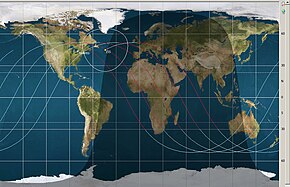
The Russian Orbital Segment contains the Data Management System, which handles Guidance, Navigation and Control (ROS GNC) for the entire station.[400] Initially, Zarya, the first module of the station, controlled the station until a short time after the Russian service module Zvezda docked and was transferred control. Zvezda contains the ESA built DMS-R Data Management System.[401] Using two fault-tolerant computers (FTC), Zvezda computes the station's position and orbital trajectory using redundant Earth horizon sensors, Solar horizon sensors as well as Sun and star trackers. The FTCs each contain three identical processing units working in parallel and provide advanced fault-masking by majority voting.
Orientation
[edit]Zvezda uses gyroscopes (reaction wheels) and thrusters to turn itself. Gyroscopes do not require propellant; instead they use electricity to 'store' momentum in flywheels by turning in the opposite direction to the station's movement. The USOS has its own computer-controlled gyroscopes to handle its extra mass. When gyroscopes 'saturate', thrusters are used to cancel out the stored momentum. In February 2005, during Expedition 10, an incorrect command was sent to the station's computer, using about 14 kilograms of propellant before the fault was noticed and fixed. When attitude control computers in the ROS and USOS fail to communicate properly, this can result in a rare 'force fight' where the ROS GNC computer must ignore the USOS counterpart, which itself has no thrusters.[402][403][404]
Docked spacecraft can also be used to maintain station attitude, such as for troubleshooting or during the installation of the S3/S4 truss, which provides electrical power and data interfaces for the station's electronics.[405]
Orbital debris threats
[edit]The low altitudes at which the ISS orbits are also home to a variety of space debris,[406] including spent rocket stages, defunct satellites, explosion fragments (including materials from anti-satellite weapon tests), paint flakes, slag from solid rocket motors, and coolant released by US-A nuclear-powered satellites. These objects, in addition to natural micrometeoroids,[407] are a significant threat. Objects large enough to destroy the station can be tracked, and therefore are not as dangerous as smaller debris.[408][409] Objects too small to be detected by optical and radar instruments, from approximately 1 cm down to microscopic size, number in the trillions. Despite their small size, some of these objects are a threat because of their kinetic energy and direction in relation to the station. Spacewalking crew in spacesuits are also at risk of suit damage and consequent exposure to vacuum.[410]
Ballistic panels, also called micrometeorite shielding, are incorporated into the station to protect pressurised sections and critical systems. The type and thickness of these panels depend on their predicted exposure to damage. The station's shields and structure have different designs on the ROS and the USOS. On the USOS, Whipple Shields are used. The US segment modules consist of an inner layer made from 1.5–5.0 cm-thick (0.59–1.97 in) aluminium, a 10 cm-thick (3.9 in) intermediate layers of Kevlar and Nextel (a ceramic fabric),[411] and an outer layer of stainless steel, which causes objects to shatter into a cloud before hitting the hull, thereby spreading the energy of impact. On the ROS, a carbon fibre reinforced polymer honeycomb screen is spaced from the hull, an aluminium honeycomb screen is spaced from that, with a screen-vacuum thermal insulation covering, and glass cloth over the top.[412]
Space debris is tracked remotely from the ground, and the station crew can be notified.[413] If necessary, thrusters on the Russian Orbital Segment can alter the station's orbital altitude, avoiding the debris. These Debris Avoidance Manoeuvres (DAMs) are not uncommon, taking place if computational models show the debris will approach within a certain threat distance. Ten DAMs had been performed by the end of 2009.[414][415][416] Usually, an increase in orbital velocity of the order of 1 m/s is used to raise the orbit by one or two kilometres. If necessary, the altitude can also be lowered, although such a manoeuvre wastes propellant.[415][417] If a threat from orbital debris is identified too late for a DAM to be safely conducted, the station crew close all the hatches aboard the station and retreat into their spacecraft in order to be able to evacuate in the event the station was seriously damaged by the debris. This partial station evacuation has occurred on 13 March 2009, 28 June 2011, 24 March 2012, 16 June 2015,[418][419] November 2021,[420] and June 2024 (Resurs-P No.1).[421]
In November 2021, a debris cloud from the destruction of Kosmos 1408 by an anti-satellite weapons test threatened the ISS, leading to the announcement of a yellow alert, leading to crew sheltering in the crew capsules.[422] A couple of weeks later, it had to perform an unscheduled maneuver to drop the station by 310 meters to avoid a collision with hazardous space debris.[420]
- A 7-gram object (shown in centre) shot at 7 km/s (23,000 ft/s), the orbital velocity of the ISS, made this 15 cm (5.9 in) crater in a solid block of aluminium
- Radar-trackable objects, including debris, with distinct ring of geostationary satellites
- Example of risk management: A NASA model showing areas at high risk from impact for the International Space Station
Visibility from Earth
[edit]The ISS is visible in the sky to the naked eye as a visibly moving, bright white dot, when crossing the sky and being illuminated by the Sun, during twilight, the hours after sunset and before sunrise, when the station remains sunlit, outside of Earth's shadow, but the ground and sky are dark.[423] It crosses the skies at latitudes between the polar regions.[424] Depending on the path it takes across the sky, the time it takes the station to move across the horizon or from one to the other may be short or up to 10 minutes, while likely being only visible part of that time because of it moving into or out of Earth's shadow. It then returns around every 90 minutes, with the time of the day that it crosses the sky shifting over the course of some weeks, and therefore before returning to twilight and visible illumination.
Because of the size of its reflective surface area, the ISS is the brightest artificial object in the sky (excluding other satellite flares), with an approximate maximum magnitude of −4 when in sunlight and overhead (similar to Venus), and a maximum angular size of 63 arcseconds.[425]
Tools are provided by a number of websites such as Heavens-Above (see Live viewing below) as well as smartphone applications that use orbital data and the observer's longitude and latitude to indicate when the ISS will be visible (weather permitting), where the station will appear to rise, the altitude above the horizon it will reach and the duration of the pass before the station disappears either by setting below the horizon or entering into Earth's shadow.[426][427][428][429]
In November 2012 NASA launched its "Spot the Station" service, which sends people text and email alerts when the station is due to fly above their town.[430] The station is visible from 95% of the inhabited land on Earth, but is not visible from extreme northern or southern latitudes.[392]
Under specific conditions, the ISS can be observed at night on five consecutive orbits. Those conditions are 1) a mid-latitude observer location, 2) near the time of the solstice with 3) the ISS passing in the direction of the pole from the observer near midnight local time. The three photos show the first, middle and last of the five passes on 5–6 June 2014.
- Skytrack long duration exposure of the ISS
- The ISS on its first pass of the night passing nearly overhead shortly after sunset in June 2014
- The ISS passing north on its third pass of the night near local midnight in June 2014
- The ISS passing west on its fifth pass of the night before sunrise in June 2014
Astrophotography
[edit]
Using a telescope-mounted camera to photograph the station is a popular hobby for astronomers,[431] while using a mounted camera to photograph the Earth and stars is a popular hobby for crew.[432] The use of a telescope or binoculars allows viewing of the ISS during daylight hours.[433]
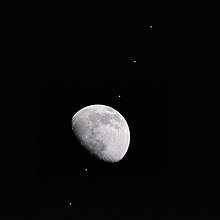
Transits of the ISS in front of the Sun, particularly during an eclipse (and so the Earth, Sun, Moon, and ISS are all positioned approximately in a single line) are of particular interest for amateur astronomers.[434][435]
International co-operation
[edit]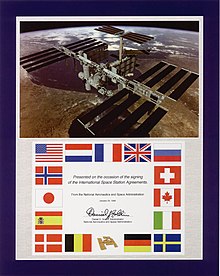
Involving five space programs and fifteen countries,[436] the International Space Station is the most politically and legally complex space exploration programme in history.[436] The 1998 Space Station Intergovernmental Agreement sets forth the primary framework for international cooperation among the parties. A series of subsequent agreements govern other aspects of the station, ranging from jurisdictional issues to a code of conduct among visiting astronauts.[437]
Following the 2022 Russian invasion of Ukraine, continued cooperation between Russia and other countries on the International Space Station has been put into question. Roscosmos Director General Dmitry Rogozin insinuated that Russian withdrawal could cause the International Space Station to de-orbit due to lack of reboost capabilities, writing in a series of tweets, "If you block cooperation with us, who will save the ISS from an unguided de-orbit to impact on the territory of the US or Europe? There's also the chance of impact of the 500-ton construction in India or China. Do you want to threaten them with such a prospect? The ISS doesn't fly over Russia, so all the risk is yours. Are you ready for it?"[438] (This latter claim is untrue: the ISS flies over all parts of the Earth between 51.6 degrees latitude north and south, approximately the latitude of Saratov.) Rogozin later tweeted that normal relations between ISS partners could only be restored once sanctions have been lifted, and indicated that Roscosmos would submit proposals to the Russian government on ending cooperation.[439] NASA stated that, if necessary, US corporation Northrop Grumman has offered a reboost capability that would keep the ISS in orbit.[440]
On 26 July 2022, Yury Borisov, Rogozin's successor as head of Roscosmos, submitted to Russian President Putin plans for withdrawal from the programme after 2024.[441] However, Robyn Gatens, the NASA official in charge of the space station, responded that NASA had not received any formal notices from Roscosmos concerning withdrawal plans.[442]
Participating countries
[edit] Brazil (1997–2007)
Brazil (1997–2007) Canada
Canada European Space Agency
European Space Agency Japan
Japan Russia
Russia United States
United States
End of mission
[edit]Originally the ISS was planned to be a 15 year mission.[443]Therefore an end of mission had been worked on,[444] but was several times postponed due to the success and support for the operation of the station.[445] As a result the oldest modules of the ISS have been in orbit for more than 20 years, with their reliability having decreased.[444] It has been proposed to use funds instead elsewhere, for example for a return to the Moon.[445] According to the Outer Space Treaty, the parties are legally responsible for all spacecrafts or modules they launch.[446] An unmaintained station would pose an orbital and re-entry hazard.
Russia has stated that it plans to pull out of the ISS program after 2025.[447] However, Russian modules will provide orbital station-keeping until 2028.[444]
The US planned in 2009 to deorbit the ISS in 2016.[445] But on 30 September 2015, Boeing's contract with NASA as prime contractor for the ISS was extended to 30 September 2020. Part of Boeing's services under the contract related to extending the station's primary structural hardware past 2020 to the end of 2028.[448] In July 2018, the Space Frontier Act of 2018 was intended to extend operations of the ISS to 2030. This bill was unanimously approved in the Senate, but failed to pass in the U.S. House.[449][450] In September 2018, the Leading Human Spaceflight Act was introduced with the intent to extend operations of the ISS to 2030, and was confirmed in December 2018.[451][452][453] Congress later passed similar provisions in its CHIPS and Science Act, signed into law by U.S. President Joe Biden on 9 August 2022.[454][455]
If until 2031 Commercial LEO Destinations providers are not sufficient to accommodate NASA's projects, NASA is suggesting to extend ISS operations beyond 2031.[456]
NASA's disposal plans
[edit]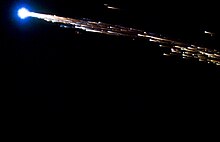
NASA considered originally several possible disposal options: Natural orbital decay with random reentry (as with Skylab), boosting the station to a higher altitude (which would delay reentry), and a controlled targeted de-orbit to a remote ocean area.[457] In late 2010, the preferred plan was to use a slightly modified Progress spacecraft to de-orbit the ISS. NASA concluded this would not be adequate for the job, and decided on a spacecraft specifically designed for the job.[458] Raising the orbit to a stable orbit or deorbiting uncontrolled was identified by NASA as both too risky, producing hazardous debris from the ISS by possibly being hit by space debris (beside being costly) or by entering the atmosphere uncontrolled.[456]
In January 2022, NASA announced a planned date of January 2031 to de-orbit the ISS using a deorbit vehicle and direct any remnants into a remote area of the South Pacific Ocean that has come to be known as the spacecraft cemetery.[459] NASA plans to launch the deorbit vehicle in 2030, docking at the Harmony forward port either through a CBM or to PMA 2/IDA 2 after the removal of Axiom Orbital Segment. The deorbit vehicle will remain attached, dormant, for about a year as the station's orbit naturally decays to 220 km (140 mi). The spacecraft would then conduct one or more orientation burns to lower the perigee to 150 km (93 mi), followed by a final deorbiting burn.[460]
After being wary of Russia pulling out of the program abruptly, special funding was asked for, providing for the development of an own deorbiting module, instead of relying on Russian modules for deorbiting.[461]
In June 2024, NASA awarded a contract worth up to $843 million to SpaceX to build the ISS Deorbit Vehicle. The vehicle will consist of an existing Cargo Dragon spacecraft which will be paired with a significantly lengthened trunk module which will be equipped with 46 Draco thrusters (instead of the normal 18) and will carry 30,000 kg (66,000 lb) of propellant, nearly six times the normal load. NASA is still working to secure all the nessary funding to build and operate the deorbit vehicle.[16][461]
Post mission proposals and plans
[edit]The follow on NASA program is the Commercial LEO Destinations Program, meant to allow private industry to build and maintain their own stations, and NASA procuring access as a customer, starting in 2028.[462] Similarly ESA has been looking for new private space stations orbital services, as well as retrieve material from the ISS.[463][464] Currently Axiom Station is being planed to be assembled docked to the ISS, as a segment of the ISS, starting sometime after 2024.[444] Additionally there even have been suggestions in the commercial space industry that the ISS could be converted to commercial operations after it is retired by government entities,[465] including turning it into a space hotel.[445]
Russia previously has planned to use its orbital segment for the construction of its OPSEK station after the ISS is decommissioned. The modules under consideration for removal from the current ISS included the Multipurpose Laboratory Module (Nauka), launched in July 2021, and the other new Russian modules that are proposed to be attached to Nauka. These newly launched modules would still be well within their useful lives in 2024.[466] At the end of 2011, the Exploration Gateway Platform concept also proposed using leftover USOS hardware and Zvezda 2 as a refuelling depot and service station located at one of the Earth–Moon Lagrange points. However, the entire USOS was not designed for disassembly and will be discarded.[467]
Western space industry has suggested in 2022 using the ISS as a platform to develop orbital salvage capacities, by companies such as CisLunar Industries working on using space debris as fuel,[468] instead of plunging it into the ocean.[447]
NASA has stated that by July 2024 it has not seen any viable proposals for reuse of the ISS or parts of it.[456]
Cost
[edit]The ISS has been described as the most expensive single item ever constructed.[469] As of 2010, the total cost was US$150 billion. This includes NASA's budget of $58.7 billion ($89.73 billion in 2021 dollars) for the station from 1985 to 2015, Russia's $12 billion, Europe's $5 billion, Japan's $5 billion, Canada's $2 billion, and the cost of 36 shuttle flights to build the station, estimated at $1.4 billion each, or $50.4 billion in total. Assuming 20,000 person-days of use from 2000 to 2015 by two- to six-person crews, each person-day would cost $7.5 million, less than half the inflation-adjusted $19.6 million ($5.5 million before inflation) per person-day of Skylab.[470]
In culture
[edit]The ISS has become an international symbol of human capabilities, particularly human cooperation and science,[471] defining a cooperative international approach and period, instead of a looming commercialized and militarized interplanetary world.[472]
In film
[edit]Beside numerous documentaries such as the IMAX documentaries Space Station 3D from 2002,[473] or A Beautiful Planet from 2016,[474] and films like Apogee of Fear (2012)[475] and Yolki 5 (2016)[476][477] the ISS is the subject of feature films such as The Day After Tomorrow (2004),[478] Love (2011),[479] together with the Chinese station Tiangong 1 in Gravity (2013),[480] Life (2017),[481] and I.S.S. (2023).[482]
In 2022, the movie The Challenge (Doctor's House Call) was filmed aboard the ISS, and was notable for being the first feature film in which both professional actors and director worked together in space.[483]
See also
[edit]- A Beautiful Planet (2016) – IMAX documentary film showing scenes of Earth, as well as astronaut life aboard the ISS
- Center for the Advancement of Science in Space – operates the US National Laboratory on the ISS
- List of accidents and incidents involving the International Space Station
- List of commanders of the International Space Station
- List of human spaceflights to the International Space Station
- List of International Space Station expeditions
- List of International Space Station spacewalks
- List of space stations
- List of spacecraft deployed from the International Space Station
- Politics of outer space
- Science diplomacy
- Space Station 3D (2002) – Canadian documentary
Notes
[edit]- ^ Temporary docking adapter used until Prichal module arrival
- ^ "Zarya" can have a lot of meanings: "daybreak", "dawn" (in the morning) or "afterglow", "evening glow", "sunset" (in the evening). But usually it means "dawn".
- ^ The temporary docking adapter is the grey ring surrounding the docking probe of Progress MS 17.
- ^ The port had the temporary docking adapter before the SSVP-M or "Hybrid" standard, consisting of the traditional SSVP-G probe‑and‑drogue soft-dock mechanism and an APAS-95 hard-dock collar before Prichal arrival.
- ^ Privately funded travellers who have objected to the term include Dennis Tito, the first such traveller,[273] Mark Shuttleworth, founder of Ubuntu,[274] Gregory Olsen and Richard Garriott.[275][276] Canadian astronaut Bob Thirsk said the term does not seem appropriate, referring to his crewmate, Guy Laliberté, founder of Cirque du Soleil.[277] Anousheh Ansari denied being a tourist[278] and took offence at the term.[279]
- ^ ESA director Jörg Feustel-Büechl said in 2001 that Russia had no right to send 'amateurs' to the ISS. A 'stand-off' occurred at the Johnson Space Center between Commander Talgat Musabayev and NASA manager Robert Cabana who refused to train Dennis Tito, a member of Musabayev's crew along with Yuri Baturin. Musabayev argued that Tito had trained 700 hours in the last year and was as qualified as any NASA astronaut, and refused to allow his crew to be trained on the USOS without Tito. Cabana would not allow training to begin, and the commander returned with his crew to their hotel.
References
[edit]- ^ Jump up to: a b c d e Graf, Abby (27 September 2023). "Crewed Soyuz Spacecraft Undocking Live on NASA TV". NASA Blogs. Archived from the original on 15 October 2023. Retrieved 27 September 2023.
- ^ Jump up to: a b "Russia's Soyuz MS-24 launches crew for up to yearlong stay on space station". collectSPACE.com. Archived from the original on 6 October 2023. Retrieved 15 September 2023.
- ^ "ISS: International Space Station". Archived from the original on 10 August 2023.
- ^ Jump up to: a b c d e Garcia, Mark (5 January 2023). "About the Space Station: Facts and Figures". NASA. Archived from the original on 6 February 2023. Retrieved 13 January 2023.
- ^ Jump up to: a b c d e f Peat, Chris (21 May 2021). "ISS – Orbit". Heavens-Above. Archived from the original on 25 December 2018. Retrieved 21 May 2021.
- ^ "Live Space Station Tracking Map". NASA. Archived from the original on 10 May 2024. Retrieved 2 May 2024.
- ^ Holman, Joseph (12 October 2022). "ISS (ZARYA)". Satellite Tracking. Archived from the original on 12 October 2022. Retrieved 12 October 2022.
- ^ Jump up to: a b "ARISS TLE". ARISS TLE. 16 August 2023. Archived from the original on 2 April 2023. Retrieved 16 August 2023.
- ^ Jump up to: a b c NASA (18 February 2010). "On-Orbit Elements" (PDF). NASA. Archived from the original (PDF) on 29 October 2009. Retrieved 19 June 2010.
- ^ "STS-132 Press Kit" (PDF). NASA. 7 May 2010. Archived (PDF) from the original on 12 October 2023. Retrieved 19 June 2010.
- ^ "STS-133 FD 04 Execute Package" (PDF). NASA. 27 February 2011. Archived from the original (PDF) on 27 November 2020. Retrieved 27 February 2011.
- ^ NASA (23 May 2023). "ISS". NASA. Archived from the original on 16 May 2024. Retrieved 9 May 2024.
- ^ "NASA – Higher Altitude Improves Station's Fuel Economy". nasa.gov. 14 February 2019. Archived from the original on 25 December 2021. Retrieved 29 May 2019.
- ^ "Current ISS Tracking data". NASA. 15 December 2008. Archived from the original on 25 December 2015. Retrieved 28 January 2009.
 This article incorporates text from this source, which is in the public domain.
This article incorporates text from this source, which is in the public domain. - ^ "International Space Station Visitors by Country – NASA". Archived from the original on 23 January 2024. Retrieved 19 March 2023.
- ^ Jump up to: a b "NASA Selects International Space Station US Deorbit Vehicle - NASA". Retrieved 26 June 2024.
- ^ Frieling, Thomas. "Skylab B:Unflown Missions, Lost Opportunities". Quest. 5 (4): 12–21.
- ^ Portree, David S. F. (26 March 2012). "Skylab-Salyut Space Laboratory (1972)". WIRED. Archived from the original on 10 August 2023.
- ^ ESA – Columbus
- ^ "International Space Station". Astronautix.com. Archived from the original on 9 April 2002. Retrieved 1 May 2012.
- ^ Leary, Warren E. (8 June 1993). "Fate of Space Station Is in Doubt As All Options Exceed Cost Goals". The New York Times. Archived from the original on 26 May 2015.
- ^ "Mir-2". Astronautix. Archived from the original on 20 August 2016. Retrieved 12 February 2011.
- ^ "U.S. Proposes Space Station Merger with Russia". The Washington Post. 5 November 1993.
- ^ Heivilin, Donna (21 June 1994). "Space Station: Impact of the Expanded Russian Role on Funding and Research" (PDF). Government Accountability Office. Retrieved 3 November 2006.
- ^ Dismukes, Kim (4 April 2004). "Shuttle–Mir History/Background/How "Phase 1" Started". NASA. Archived from the original on 16 November 2001. Retrieved 12 April 2007.
- ^ Jump up to: a b "Russia to decide on pullout from ISS since 2025 after technical inspection". TASS. 18 April 2021. Retrieved 18 April 2021.
- ^ Dobrovidova, Olga (20 April 2021). "Russia mulls withdrawing from the International Space Station after 2024". Science. American Association for the Advancement of Science (AAAS). doi:10.1126/science.abj1005. ISSN 0036-8075. S2CID 235542488.
- ^ Harwood, William (26 July 2022). "Russia says it will withdraw from the International Space Station after 2024". CBS News. ViacomCBS. Retrieved 26 July 2022.
- ^ Roulette, Joey (26 July 2022). "Russia signals space station pullout, but NASA says it's not official yet". Reuters. Retrieved 26 July 2022.
- ^ "Russia is likely to take part in International Space Station until 2028 – RIA". Reuters. 21 September 2022. Retrieved 2 November 2022.
- ^ "Memorandum of Understanding Between the National Aeronautics and Space Administration of the United States of America and the Russian Space Agency Concerning Cooperation on the Civil International Space Station". NASA. Archived from the original on 15 December 2015. Retrieved 19 April 2009.
 This article incorporates text from this source, which is in the public domain.
This article incorporates text from this source, which is in the public domain. - ^ Payette, Julie (10 December 2012). "Research and Diplomacy 350 Kilometers above the Earth: Lessons from the International Space Station". Science & Diplomacy. 1 (4). Archived from the original on 6 March 2013.
- ^ "National Space Policy of the United States of America" (PDF). White House. 28 June 2010. Archived (PDF) from the original on 27 October 2023. Retrieved 20 July 2011.
 This article incorporates text from this source, which is in the public domain.
This article incorporates text from this source, which is in the public domain. - ^ Trinidad, Katherine; Humphries, Kelly (17 November 2008). "Nations Around the World Mark 10th Anniversary of International Space Station" (Press release). NASA. 08-296. Archived from the original on 21 May 2022. Retrieved 6 March 2009.
 This article incorporates text from this source, which is in the public domain.
This article incorporates text from this source, which is in the public domain. - ^ Jump up to: a b c Oberg, James (2005). "International Space Station". World Book Online Reference Center. Retrieved 3 April 2016.[permanent dead link]
- ^ Jump up to: a b c d e "Fields of Research". NASA. 26 June 2007. Archived from the original on 23 January 2008.
- ^ "Getting on Board". NASA. 26 June 2007. Archived from the original on 8 December 2007.
 This article incorporates text from this source, which is in the public domain.
This article incorporates text from this source, which is in the public domain. - ^ "Monitor of All-sky X-ray Image (MAXI)". JAXA. 2008. Archived from the original on 22 July 2011. Retrieved 12 March 2011.
- ^ "SOLAR: three years observing and ready for solar maximum". esa.int. ESA. 11 March 2011. Archived from the original on 10 August 2023. Retrieved 4 June 2023.
- ^ Hartevelt-Velani, Shamim; Walker, Carl; Elmann-Larsen, Benny (23 November 2009). "The International Space Station: life in space". Science in School (10). Archived from the original on 3 February 2023. Retrieved 17 February 2009.
- ^ "AMS to Focus on Invisible Universe". NASA. 18 March 2011. Archived from the original on 5 March 2023. Retrieved 8 October 2011.
 This article incorporates text from this source, which is in the public domain.
This article incorporates text from this source, which is in the public domain. - ^ "In Search of Antimatter Galaxies". NASA. 14 August 2009. Archived from the original on 14 January 2023. Retrieved 8 October 2011.
 This article incorporates text from this source, which is in the public domain.
This article incorporates text from this source, which is in the public domain. - ^ Aguilar, M. et al. (AMS Collaboration) (3 April 2013). "First Result from the Alpha Magnetic Spectrometer on the International Space Station: Precision Measurement of the Positron Fraction in Primary Cosmic Rays of 0.5–350 GeV" (PDF). Physical Review Letters. 110 (14): 141102. Bibcode:2013PhRvL.110n1102A. doi:10.1103/PhysRevLett.110.141102. ISSN 0031-9007. PMID 25166975. Archived (PDF) from the original on 10 August 2023.
- ^ Staff (3 April 2013). "First Result from the Alpha Magnetic Spectrometer Experiment". AMS Collaboration. Archived from the original on 8 April 2013. Retrieved 3 April 2013.
- ^ Heilprin, John; Borenstein, Seth (3 April 2013). "Scientists find hint of dark matter from cosmos". Associated Press. Archived from the original on 10 May 2013. Retrieved 3 April 2013.
- ^ Amos, Jonathan (3 April 2013). "Alpha Magnetic Spectrometer zeroes in on dark matter". BBC News. Archived from the original on 12 August 2023. Retrieved 3 April 2013.
- ^ Perrotto, Trent J.; Byerly, Josh. "NASA TV Briefing Discusses Alpha Magnetic Spectrometer Results" (Press release). NASA. M13-054. Archived from the original on 9 November 2023. Retrieved 3 April 2013.
 This article incorporates text from this source, which is in the public domain.
This article incorporates text from this source, which is in the public domain. - ^ Overbye, Dennis (3 April 2013). "Tantalizing New Clues Into the Mysteries of Dark Matter". The New York Times. Archived from the original on 20 August 2017. Retrieved 3 April 2013.
- ^ Horneck, Gerda; Klaus, David M.; Mancinelli, Rocco L. (March 2010). "Space Microbiology" (PDF). Microbiology and Molecular Biology Reviews. 74 (1). American Society for Microbiology: 121–156. Bibcode:2010MMBR...74..121H. doi:10.1128/MMBR.00016-09. PMC 2832349. PMID 20197502. Archived from the original (PDF) on 30 August 2011. Retrieved 4 June 2011. See Space Environment on p. 122.
- ^ Amos, Jonathan (23 August 2010). "Beer microbes live 553 days outside ISS". BBC News. Archived from the original on 11 August 2023. Retrieved 4 June 2011.
- ^ Ledford, Heidi (8 September 2008). "Spacesuits optional for 'water bears'". Nature. doi:10.1038/news.2008.1087.
- ^ Jump up to: a b c Buckey, Jay (23 February 2006). Space Physiology. Oxford University Press USA. ISBN 978-0-19-513725-5.
- ^ Grossman, List (22 July 2009). "Ion engine could one day power 39-day trips to Mars". New Scientist. Archived from the original on 15 October 2023. Retrieved 8 January 2010.
- ^ Boen, Brooke (1 May 2009). "Advanced Diagnostic Ultrasound in Microgravity (ADUM)". NASA. Archived from the original on 29 October 2009. Retrieved 1 October 2009.
 This article incorporates text from this source, which is in the public domain.
This article incorporates text from this source, which is in the public domain. - ^ Rao, Sishir; et al. (May 2008). "A Pilot Study of Comprehensive Ultrasound Education at the Wayne State University School of Medicine". Journal of Ultrasound in Medicine. 27 (5): 745–749. doi:10.7863/jum.2008.27.5.745. PMID 18424650. S2CID 30566494.
- ^ Fincke, E. Michael; et al. (February 2005). "Evaluation of Shoulder Integrity in Space: First Report of Musculoskeletal US on the International Space Station". Radiology. 234 (2): 319–322. doi:10.1148/radiol.2342041680. PMID 15533948.
- ^ Strickland, Ashley (26 August 2020). "Bacteria from Earth can survive in space and could endure the trip to Mars, according to new study". CNN News. Archived from the original on 11 August 2023. Retrieved 26 August 2020.
- ^ Kawaguchi, Yuko; et al. (26 August 2020). "DNA Damage and Survival Time Course of Deinococcal Cell Pellets During 3 Years of Exposure to Outer Space". Frontiers in Microbiology. 11: 2050. doi:10.3389/fmicb.2020.02050. PMC 7479814. PMID 32983036. S2CID 221300151.
- ^ "Earth Science & Remote Sensing Missions on ISS". NASA. Archived from the original on 10 August 2023. Retrieved 9 December 2020.
- ^ May, Sandra (15 February 2012). "What Is Microgravity?". NASA Knows! (Grades 5–8). NASA. Archived from the original on 7 November 2023. Retrieved 3 September 2018.
 This article incorporates text from this source, which is in the public domain.
This article incorporates text from this source, which is in the public domain. - ^ "European Users Guide to Low Gravity Platforms". European Space Agency. 6 December 2005. Archived from the original on 2 April 2013. Retrieved 22 March 2013.
- ^ "Materials Science 101". NASA. 15 September 1999. Archived from the original on 14 June 2009. Retrieved 18 June 2009.
 This article incorporates text from this source, which is in the public domain.
This article incorporates text from this source, which is in the public domain. - ^ "ISS Research Program". NASA. Archived from the original on 13 February 2009. Retrieved 27 February 2009.
- ^ "Mars500: study overview". European Space Agency. 4 June 2011. Archived from the original on 19 August 2023.
- ^ "Space station may be site for next mock Mars mission". New Scientist. 4 November 2011. Archived from the original on 11 July 2017. Retrieved 1 September 2017.
- ^ "The Sustainable Utilisation of the ISS Beyond 2015" (PDF). International Astronautical Congress. Archived from the original (PDF) on 26 April 2012. Retrieved 15 December 2011.
- ^ de Selding, Peter B. (3 February 2010). "ESA Chief Lauds Renewed U.S. Commitment to Space Station, Earth Science". Space News.
- ^ Chow, Denise (8 April 2011). "Space Station Crucial for Going to Mars, NASA Chief Says". Space.com. Archived from the original on 11 August 2023.
- ^ Seitz, Virginia A. (19 September 2011). "Memorandum Opinion for the General Counsel, Office of Science and Technology Policy" (PDF). justice.gov. US Justice Department. p. 3. Archived from the original (PDF) on 13 July 2012. Retrieved 23 May 2012.
- ^ Jump up to: a b c d e f Kitmacher, Gary (2006). Reference Guide to the International Space Station. Apogee Books Space Series. Canada: Apogee Books. pp. 71–80. ISBN 978-1-894959-34-6. ISSN 1496-6921.
- ^ Sandal, Gro M.; Manzey, Dietrich (December 2009). "Cross-cultural issues in space operations: A survey study among ground personnel of the European Space Agency". Acta Astronautica. 65 (11–12): 1520–1529. Bibcode:2009AcAau..65.1520S. doi:10.1016/j.actaastro.2009.03.074. ISSN 0094-5765.
- ^ "Online Materials". European Space Agency. Archived from the original on 11 August 2023. Retrieved 3 April 2016.
- ^ "ISS 3-D Teaching Tool: Spaceflight Challenge I". European Space Agency. 24 May 2011. Archived from the original on 11 August 2023. Retrieved 8 October 2011.
- ^ Building Peace in Young Minds through Space Education (PDF). Committee on the Peaceful Uses of Outer Space. Vol. 53. Vienna, Austria: JAXA. June 2010. Archived (PDF) from the original on 11 August 2023.
- ^ "JAXA Spaceflight Seeds Kids I : Spaceflight Sunflower seeds – Let's make them flower! and learn freshly the Earth environment just by contrast with the Space one". JAXA. 2006. Archived from the original on 18 March 2012.
- ^ "JAXA Seeds in Space I : Let's Cultivate Spaceflight Asagao (Japanese morning glory), Miyako-gusa (Japanese bird's foot trefoil) Seeds and Identify the Mutants!". JAXA. 2006. Archived from the original on 18 March 2012.
- ^ Murakami, Keiji (14 October 2009). "JEM Utilization Overview" (PDF). JAXA. Steering Committee for the Decadal Survey on Biological and Physical Sciences in Space. Archived from the original (PDF) on 29 November 2011. Retrieved 27 September 2011.
- ^ Tanaka, Tetsuo. "Kibo: Japan's First Human Space Facility". JAXA. Archived from the original on 29 November 2011. Retrieved 8 October 2011.
- ^ "Amateur Radio on the International Space Station". 6 June 2011. Archived from the original on 27 May 2011. Retrieved 10 June 2011.
- ^ Riley, Christopher (11 April 2011). "What Yuri Gagarin saw: First Orbit film to reveal the view from Vostok 1". The Guardian. Archived from the original on 10 August 2023.
- ^ "Yuri Gagarin's First Orbit – FAQs". firstorbit.org. The Attic Room Ltd. Archived from the original on 10 August 2023. Retrieved 1 May 2012.
- ^ Warr, Philippa (13 May 2013). "Commander Hadfield bids farewell to ISS with Reddit-inspired Bowie cover". wired.co.uk. Archived from the original on 12 October 2013. Retrieved 22 October 2013.
- ^ "Astronaut bids farewell with Bowie cover version (inc. video)". BBC News. 13 May 2013. Archived from the original on 11 August 2023. Retrieved 24 September 2020.
- ^ Davis, Lauren (12 May 2013). "Chris Hadfield sings "Space Oddity" in the first music video in space". Gizmodo. Archived from the original on 11 August 2023.
- ^ Mabbett, Andy (29 November 2017). "Close encounters of the Wikipedia kind: Astronaut is first to specifically contribute to Wikipedia from space". Diff. Wikimedia foundation. Archived from the original on 4 June 2023. Retrieved 4 December 2017.
- ^ Petris, Antonella (1 December 2017). "Primo contributo 'extraterrestre' su Wikipedia: è di Nespoli" [First 'Extraterrestrial' Contribution on Wikipedia: It's by Nespoli.]. Meteo Web (in Italian). Archived from the original on 11 August 2023. Retrieved 4 December 2017.
- ^ Pearlman, Robert Z. (23 November 2021). "'The Infinite' VR space station tour to premiere spacewalk in Houston". Space.com. Archived from the original on 10 August 2023. Retrieved 27 November 2021.
- ^ Harbaugh, Jennifer, ed. (19 February 2016). "Manufacturing Key Parts of the International Space Station: Unity and Destiny". NASA. Archived from the original on 24 November 2023. Retrieved 15 February 2019.
- ^ "ISS Zvezda". Archived from the original on 20 August 2016. Retrieved 5 July 2019.
- ^ "Europe's Airbus-built Columbus orbital outpost: 10 years in space" (Press release). Airbus. 6 February 2018. Archived from the original on 11 August 2022. Retrieved 6 May 2020.
- ^ "Ten years in perfect "Harmony"!" (Press release). Thales Group. 23 October 2017. Archived from the original on 10 August 2023.
- ^ "Building ISS". U.S. National Archives & DVIDS. Archived from the original on 28 October 2021. Retrieved 28 October 2021.
- ^ Shiflett, Kim (22 April 2008). "KSC-08pd0991". NASA Image and Video Library. Cape Canaveral, Florida. Archived from the original on 24 November 2023. Retrieved 5 July 2019.
In the Space Station Processing Facility at NASA's Kennedy Space Center, an overhead crane moves the Kibo Japanese Experiment Module – Pressurized Module toward the payload canister (lower right). The canister will deliver the module, part of the payload for space shuttle Discovery's STS-124 mission, to Launch Pad 39A. On the mission, the STS-124 crew will transport the Kibo module as well as the Japanese Remote Manipulator System to the International Space Station to complete the Kibo laboratory. The launch of Discovery is targeted for May 31.
- ^ Jump up to: a b c "The ISS to Date". NASA. 9 March 2011. Archived from the original on 11 June 2015. Retrieved 21 March 2011.
- ^ Dismukes, Kim (1 December 2002). "Mission Control Answers Your Questions: STS-113 Q17". spaceflight.nasa.gov. NASA. Archived from the original on 24 July 2020. Retrieved 14 June 2009.
- ^ "NASA Facts. The Service Module: A Cornerstone of Russian International Space Station Modules" (PDF). spaceflight.nasa.gov. NASA. January 1999. IS-1999-09-ISS019JSC. Archived from the original (PDF) on 23 August 2020.
- ^ "STS-88". Science.ksc.nasa.gov. Archived from the original on 6 June 2011. Retrieved 19 April 2011.
- ^ Liston, Brad (2 November 2000). "Upward Bound: Tales of Space Station Alpha". Time. Archived from the original on 2 April 2008. Retrieved 5 August 2010.
- ^ "Space Station – Impact on the expanded Russian role of funding and research" (PDF). Government Accountability Office. 21 June 1994. Archived (PDF) from the original on 12 October 2023. Retrieved 9 August 2010.
- ^ Jump up to: a b Ladwig, Alan (3 November 2000). "Call Bill Shepherd the Alpha Male of the International Space Station". Space.com. Archived from the original on 23 May 2009. Retrieved 9 August 2010.
- ^ Halvorson, Todd (2 November 2000). "Expedition One Crew Wins Bid To Name Space Station Alpha". Space.com. Archived from the original on 23 May 2009. Retrieved 9 August 2010.
- ^ "Interview with RSC Energia's Yuri Semenov". Space.com. 3 September 2001. Archived from the original on 5 March 2021. Retrieved 22 August 2010.
- ^ "Interview with Yuri Semenov, general designer of Space Rocket corporation Energy". Voice of Russia. 21 March 2001. Archived from the original on 18 March 2012. Retrieved 5 October 2010.
- ^ "STS-92". Science.ksc.nasa.gov. Archived from the original on 5 March 2011. Retrieved 19 April 2011.
- ^ Bergin, Chris (26 July 2005). "Discovery launches – The Shuttle is back". NASASpaceFlight.com. Archived from the original on 11 August 2023. Retrieved 6 March 2009.
- ^ "Mini-Research Module 1 (MIM1) Rassvet (MRM-1)". RussianSpaceWeb. Archived from the original on 25 August 2011. Retrieved 12 July 2011.
- ^ "STS-133". NASA. Archived from the original on 20 November 2023. Retrieved 1 September 2014.
- ^ "STS-134". NASA. Archived from the original on 20 November 2023. Retrieved 1 September 2014.
- ^ "Russia works on a new-generation space module". RussianSpaceWeb. Archived from the original on 8 April 2016. Retrieved 29 November 2015.
- ^ "Crewed spacecraft docked to ISS's module Nauka first time". TASS. 28 September 2011. Archived from the original on 10 August 2023. Retrieved 11 October 2021.
- ^ "Рогозин подтвердил, что на модуль "Наука" поставят баки от разгонного блока "Фрегат"" [Rogozin confirmed that the module 'Science' placed the tanks from the upper stage 'Frigate'] (in Russian). TASS. 25 March 2019. Archived from the original on 10 August 2023. Retrieved 31 March 2019.
- ^ "Новый модуль вошел в состав российского сегмента МКС" [A new module has entered the composition of the Russian segment of the ISS] (Press release) (in Russian). Roscosmos. 26 November 2021. Archived from the original on 27 November 2021. Retrieved 6 May 2022.
- ^ "Zarya Module". NASA. Archived from the original on 18 November 2023. Retrieved 19 April 2014.
- ^ Zak, Anatoly (15 October 2008). "Russian Segment: Enterprise". RussianSpaceWeb. Archived from the original on 11 August 2023. Retrieved 4 August 2012.
- ^ "NASA – NSSDCA – Spacecraft – Details". nssdc.gsfc.nasa.gov. NASA. 1998-069F. Archived from the original on 23 April 2023. Retrieved 6 May 2022.
- ^ Loff, Sarah (15 November 2018). "Unity". NASA. Archived from the original on 5 June 2022. Retrieved 6 May 2022.
- ^ Roy, Steve (20 October 2009). "ET-134's Mission,STS-130: Launching Tranquility". NASA. Archived from the original on 22 March 2023. Retrieved 23 November 2023.
- ^ Williams, Suni (presenter) (3 July 2015). Departing Space Station Commander Provides Tour of Orbital Laboratory (video). NASA. Event occurs at 17.46–18.26. Archived from the original on 14 August 2021. Retrieved 1 September 2019.
- ^ Roylance, Frank D. (11 November 2000). "Space station astronauts take shelter from solar radiation". The Baltimore Sun. Tribune Publishing. Archived from the original on 1 September 2019. Retrieved 1 September 2019.
- ^ Stofer, Kathryn (29 October 2013). "Tuesday/Wednesday Solar Punch". NASA. Archived from the original on 2 December 2020. Retrieved 1 September 2019.
- ^ "Service Module | RuSpace". suzymchale.com. Archived from the original on 21 September 2020. Retrieved 10 November 2020.
- ^ Jump up to: a b Boeing (2008). "Destiny Laboratory Module". Boeing. Archived from the original on 11 October 2008. Retrieved 7 October 2008.
- ^ Jump up to: a b NASA (2003). "U.S. Destiny Laboratory". NASA. Archived from the original on 9 July 2007. Retrieved 7 October 2008.
- ^ Jump up to: a b NASA (2001). "STS-98". NASA. Archived from the original on 30 August 2013. Retrieved 7 October 2008.
- ^ Chris Bergin (12 July 2007). "Oxygen Generating System activated onboard ISS". NASASpaceflight.com. Retrieved 25 January 2010.
- ^ Layne Carter (2010). Status of the Regenerative ECLS Water Recovery System (PDF) (Report). NASA. Retrieved 17 September 2014.
- ^ "Quest Airlock". NASA. Archived from the original on 24 October 2023. Retrieved 24 November 2023.
- ^ Jump up to: a b Stockman, Bill; Boyle, Joe; Bacon, John (2010). International Space Station Systems Engineering Case Study (PDF) (Technical report). United States Air Force. pp. 36–38. Archived (PDF) from the original on 24 November 2023. Retrieved 24 November 2023.
- ^ Uri, John (14 July 2021). "Space Station 20th: STS-104 Brings Quest Joint Airlock to the Space Station". NASA. Archived from the original on 24 November 2023. Retrieved 24 November 2023.
- ^ "August 28, 2009. S. P. Korolev RSC Energia, Korolev, Moscow region". RSC Energia. 28 August 2009. Archived from the original on 21 September 2020. Retrieved 3 September 2009.
- ^ Clark, Stephen (10 November 2009). "Poisk launches to add new room for space station". Spaceflight Now. Archived from the original on 10 August 2023. Retrieved 11 November 2009.
- ^ Zak, Anatoly. "Mir close calls". RussianSpaceWeb. Archived from the original on 11 August 2023. Retrieved 1 May 2012.
- ^ "Pirs Docking Compartment". NASA. 10 May 2006. Archived from the original on 25 October 2005. Retrieved 28 March 2009.
- ^ Williams, Suni (presenter) (19 May 2013). Station Tour: Harmony, Tranquility, Unity (video). NASA. Event occurs at 0.06–0.35. Archived from the original on 11 December 2021. Retrieved 31 August 2019.
So this is Node 2 ... this is where four out of six of us sleep.
- ^ NASA (23 October 2007). "STS-120 MCC Status Report #01". NASA. Archived from the original on 28 October 2007. Retrieved 22 September 2019.
- ^ Johnson, Jr., John (24 October 2007). "Shuttle embarks on busy mission". Los Angeles Times. Archived from the original on 12 August 2023. Retrieved 23 October 2007.
- ^ Harwood, William (26 October 2007). "Harmony module pulled from cargo bay". CBS News. Archived from the original on 17 September 2021. Retrieved 26 October 2007.
- ^ Schwartz, John (26 October 2007). "New Room Added to Space Station". The New York Times. Archived from the original on 11 August 2023. Retrieved 26 October 2007.
- ^ NASA (2007). "PMA-3 Relocation". NASA. Archived from the original on 12 October 2007. Retrieved 28 September 2007.
- ^ "NASA – NASA Receives Tranquility". Nasa.gov. 23 October 2010. Archived from the original on 11 August 2023. Retrieved 12 August 2013.
- ^ Harwood, William (11 February 2008). "Station arm pulls Columbus module from cargo bay". Spaceflight Now. Archived from the original on 7 May 2016. Retrieved 7 August 2009.
- ^ Kamiya, Setsuko (30 June 2009). "Japan a low-key player in space race". Japan Times. p. 3. Archived from the original on 13 August 2013.
- ^ "Thales Alenia Space and ISS modules – Cupola: a window over the Earth". 26 July 2010. Archived from the original on 26 July 2010.
- ^ Gebhardt, Chris (9 April 2009). "STS-132: PRCB baselines Atlantis' mission to deliver Russia's MRM-1". NASASpaceFlight.com. Archived from the original on 12 April 2023. Retrieved 12 November 2009.
- ^ "STS-132 MCC Status Report #09". NASA. 18 May 2010. Archived from the original on 8 April 2013. Retrieved 7 July 2010.
 This article incorporates text from this source, which is in the public domain.
This article incorporates text from this source, which is in the public domain. - ^ "STS-132 MCC Status Report #13". NASA. 20 May 2010. Archived from the original on 7 July 2010. Retrieved 7 July 2010.
 This article incorporates text from this source, which is in the public domain.
This article incorporates text from this source, which is in the public domain. - ^ Ray, Justin (28 June 2010). "Station crew takes Soyuz for 'spin around the block'". Spaceflight Now. Archived from the original on 11 August 2023. Retrieved 7 July 2010.
- ^ Jump up to: a b "Mini-Research Module 1 (MRM1) Rassvet (Dawn)". Reference Guide to the International Space Station (PDF). National Aeronautics and Space Administration. November 2010. p. 62. ISBN 978-0-16-086517-6. LCCN 2010040473. Archived (PDF) from the original on 26 November 2023. Retrieved 18 December 2022.
- ^ "Выход российских космонавтов в открытый космос перенесли на лето" [The spacewalk of Russian cosmonauts has been rescheduled for the summer] (in Russian). RIA Novosti. 17 May 2022. Archived from the original on 10 August 2023. Retrieved 25 November 2022.
- ^ Jump up to: a b c "Многоцелевой лабораторный модуль "Наука"" [Multipurpose Laboratory Module 'Nauka'] (in Russian). Roscosmos. Archived from the original on 14 July 2021. Retrieved 14 July 2021.
- ^ Pearlman, Robert (10 April 2016). "SpaceX Dragon Arrives at Space Station, Delivers Inflatable Room Prototype". Space.com. Archived from the original on 11 June 2023. Retrieved 11 April 2016.
- ^ Foust, Jeff (21 January 2022). "Bigelow Aerospace transfers BEAM space station module to NASA". SpaceNews. Retrieved 13 February 2024.
- ^ Harwood, William (19 August 2016). "Spacewalkers attach docking adapter to space station for commercial vehicles". Spaceflight Now. Archived from the original on 10 August 2023. Retrieved 24 January 2021.
- ^ Garcia, Mark (21 August 2019). "Spacewalkers Complete Installation of Second Commercial Docking Port". NASA Space Station. Archived from the original on 2 June 2020. Retrieved 24 January 2021.
- ^ "Thales Alenia Space reaches key milestone for NanoRacks' airlock module" (Press release). Turin, Italy: Thales Alenia Space. 20 March 2019. Archived from the original on 10 August 2023. Retrieved 22 August 2019.
- ^ Clark, Stephen (2 August 2019). "SpaceX to begin flights under new cargo resupply contract next year". Spaceflight Now. Archived from the original on 2 June 2023. Retrieved 22 August 2019.
- ^ "NanoRacks, Boeing to Build First Commercial ISS Airlock Module" (Press release). NanoRacks. 6 February 2017. Archived from the original on 11 August 2023. Retrieved 22 August 2019.
- ^ Garcia, Mark (6 February 2017). "Progress Underway for First Commercial Airlock on Space Station". NASA. Archived from the original on 12 November 2020. Retrieved 22 August 2019.
- ^ Zak, Anatoly (9 February 2021). "Progress MS-17 lifts off to prepare Prichal module arrival". RussianSpaceWeb. Archived from the original on 11 August 2023. Retrieved 21 October 2021.
- ^ "В РКК "Энергия" утвердили эскиз нового узлового модуля МКС". Roskosmos. Archived from the original on 19 June 2013. Retrieved 30 December 2012.
- ^ Clark, Stephen (25 July 2019). "New docking port, spacesuit and supplies en route to space station". Spaceflight Now. Archived from the original on 10 August 2023. Retrieved 17 August 2019.
- ^ Jump up to: a b Zak, Anatoly (22 June 2020). "Prichal Node Module, UM". RussianSpaceWeb. Archived from the original on 20 November 2023. Retrieved 23 June 2020.
- ^ "News January 13, 2011" (Press release). Energia. 13 January 2011. Archived from the original on 2 July 2017. Retrieved 8 October 2011.
- ^ Jump up to: a b Atkinson, Ian (19 August 2020). "Russia's Nauka ISS module arrives at Baikonur for final launch preparations". NASASpaceFlight.com. Archived from the original on 10 August 2023. Retrieved 20 August 2020.
- ^ "Spread Your Wings, It's Time to Fly". NASA. 26 July 2006. Archived from the original on 11 January 2023. Retrieved 21 September 2006.
 This article incorporates text from this source, which is in the public domain.
This article incorporates text from this source, which is in the public domain. - ^ "Consolidated Launch Manifest". NASA. 2008. Archived from the original on 7 March 2009. Retrieved 8 July 2008.
 This article incorporates text from this source, which is in the public domain.
This article incorporates text from this source, which is in the public domain. - ^ "EXPRESS Racks 1 and 2 fact sheet". 1 February 2001. FS-2001-02-34-MSFC. Archived from the original on 29 August 2008. Retrieved 4 October 2009.
 This article incorporates text from this source, which is in the public domain.
This article incorporates text from this source, which is in the public domain. - ^ "Soyuz TMA-03M docks to ISS, returns station to six crewmembers for future ops". NASASpaceFlight.com. 23 December 2011. Archived from the original on 11 August 2023. Retrieved 1 May 2012.
- ^ Welsch, L. D. (30 October 2009). "EVA Checklist: STS-129 Flight Supplement" (PDF). NASA. Archived from the original (PDF) on 29 November 2011. Retrieved 9 July 2011.
 This article incorporates text from this source, which is in the public domain.
This article incorporates text from this source, which is in the public domain. - ^ "Space Shuttle Mission: STS-133 Press Kit" (PDF). NASA. February 2011. Archived (PDF) from the original on 12 October 2023. Retrieved 9 July 2011.
 This article incorporates text from this source, which is in the public domain.
This article incorporates text from this source, which is in the public domain. - ^ Jump up to: a b c "Space Shuttle Mission: STS-134" (PDF). NASA. April 2011. Archived from the original (PDF) on 26 December 2018. Retrieved 9 July 2011.
 This article incorporates text from this source, which is in the public domain.
This article incorporates text from this source, which is in the public domain. - ^ "HTV2: Mission Press Kit" (PDF). Japan Aerospace Exploration Agency. 20 January 2011. Archived (PDF) from the original on 11 August 2023.
- ^ "Exposed Facility:About Kibo". JAXA. 29 August 2008. Archived from the original on 3 August 2009. Retrieved 9 October 2009.
- ^ "NASA–European Technology Exposure Facility (EuTEF)". NASA. 6 October 2008. Archived from the original on 19 October 2008. Retrieved 28 February 2009.
 This article incorporates text from this source, which is in the public domain.
This article incorporates text from this source, which is in the public domain. - ^ "European Technology Exposure Facility (EuTEF)". European Space Agency. 13 January 2009. Archived from the original on 12 August 2023. Retrieved 28 February 2009.
- ^ "Atomic Clock Ensemble in Space (ACES)". ESA. Archived from the original on 9 June 2009. Retrieved 9 October 2009.
- ^ Gebhardt, Chris (10 March 2017). "SpaceX science – Dragon delivers experiments for busy science period". NASASpaceFlight.com. Archived from the original on 10 August 2023. Retrieved 11 January 2019.
- ^ Graham, William (3 June 2017). "Falcon 9 launches with CRS-11 Dragon on 100th 39A launch". NASASpaceFlight.com. Archived from the original on 10 August 2023. Retrieved 11 January 2019.
- ^ "The Alpha Magnetic Spectrometer Experiment". CERN. 21 January 2009. Archived from the original on 11 August 2023. Retrieved 6 March 2009.
- ^ Bergin, Chris (4 April 2013). "Endeavour's ongoing legacy: AMS-02 proving its value". NASASpaceFlight.com. Archived from the original on 10 August 2023. Retrieved 11 January 2019.
- ^ "ESA and Airbus sign partnership agreement for new ISS commercial payload platform Bartolomeo". SpaceDaily. 9 February 2018. Archived from the original on 11 August 2023. Retrieved 10 February 2018.
- ^ "Airbus and ESA to partner on Bartolomeo platform". Aerospace Technology. 8 February 2018. Archived from the original on 10 August 2023. Retrieved 10 February 2018.
- ^ "ISS: Bartolomeo". eoPortal. European Space Agency. 26 October 2016. Archived from the original on 12 August 2023. Retrieved 10 February 2018.
- ^ Garcia, Mark (12 May 2023). "Cosmonauts Deploy Radiator and Complete Spacewalk". NASA Blogs. NASA. Archived from the original on 31 July 2023. Retrieved 12 May 2023.
- ^ "European Robotic Arm Brochure" (PDF). European Space Agency. p. 9. Archived (PDF) from the original on 10 August 2023.
- ^ Harwood, William (9 August 2023). "Russian cosmonauts make spacewalk at International Space Station". Spaceflight Now. Archived from the original on 12 August 2023. Retrieved 10 August 2023.
- ^ "Russian space station laboratory module appears to spring coolant leak – Spaceflight Now". Spaceflight Now. 9 October 2023. Archived from the original on 14 October 2023. Retrieved 10 October 2023.
- ^ "Госкорпорация "Роскосмос"". Telegram (in Russian). Archived from the original on 11 November 2023. Retrieved 10 October 2023.
- ^ "Sredstva Krepleniya Krupnogabaritnykh Obyektov, SKKO" (in Russian). Archived from the original on 6 July 2022. Retrieved 4 April 2022.
- ^ "The Russian Nauka/Multipurpose Laboratory Module (MLM) General Thread". forum.nasaspaceflight.com. Archived from the original on 15 October 2022. Retrieved 15 October 2022.
- ^ "Schedule of ISS flight events (part 2)". forum.nasaspaceflight.com. Archived from the original on 31 July 2022. Retrieved 31 July 2022.
- ^ "The Russian Nauka/Multipurpose Laboratory Module (MLM) General Thread". forum.nasaspaceflight.com. Archived from the original on 4 April 2022. Retrieved 25 March 2022.
- ^ Zak, Anatoly. "Russia to bump its ISS crew back to three". RussianSpaceWeb. Archived from the original on 11 August 2023. Retrieved 25 March 2022.
- ^ Garcia, Mark (16 November 2022). "Cosmonauts Prep for Thursday Spacewalk, Dragon Targets Monday Launch". NASA Blogs. NASA. Archived from the original on 10 August 2023. Retrieved 16 November 2022.
- ^ Lavelle, Heidi (17 November 2022). "Cosmonauts Begin First in a Series of Spacewalks for Station Maintenance". NASA Blogs. NASA. Archived from the original on 10 August 2023. Retrieved 17 November 2022.
- ^ Garcia, Mark (17 November 2022). "Cosmonauts Finish Spacewalk for Work on Science Module". NASA Blogs. NASA. Archived from the original on 29 March 2023. Retrieved 17 November 2022.
- ^ Pearlman, Robert Z. (17 November 2022). "Russian cosmonauts complete station spacewalk to ready radiator for move". Space.com. Archived from the original on 24 November 2023. Retrieved 23 November 2022.
- ^ "Canadarm2 and the Mobile Servicing System". NASA. 8 January 2013. Archived from the original on 23 March 2009. Retrieved 22 June 2015.
- ^ "Dextre, the International Space Station's Robotic Handyman". Canadian Space Agency. 18 April 2011. Archived from the original on 5 April 2023. Retrieved 22 June 2015.
- ^ "Mobile Base System". Canadian Space Agency. Archived from the original on 27 March 2023. Retrieved 22 June 2015.
- ^ "Remote Manipulator System: About Kibo". JAXA. 29 August 2008. Archived from the original on 20 March 2008. Retrieved 4 October 2009.
- ^ "International Space Station Status Report #02-03". NASA. 14 January 2002. Archived from the original on 11 March 2010. Retrieved 4 October 2009.
- ^ «Россия переносит запуск исследовательского модуля «Наука» на орбитальную станцию на 2021 год» . ТАСС . 2 апреля 2020 года. Архивировано из оригинала 10 августа 2023 года . Проверено 1 марта 2021 г.
- ^ Кларк, Стивен (28 января 2020 г.). «Аксиома» получила одобрение НАСА на присоединение коммерческой среды обитания к космической станции . Космический полет сейчас . Архивировано из оригинала 21 ноября 2023 года . Проверено 29 января 2020 г.
- ^ Этерингтон, Даррелл (27 января 2020 г.). «НАСА использует стартап Axiom Space для создания первого обитаемого коммерческого модуля для космической станции» . ТехКранч . Архивировано из оригинала 28 января 2020 года . Проверено 29 января 2020 г.
- ^ Бойл, Алан (27 января 2020 г.). «НАСА разрешило Axiom Space разместить коммерческую среду обитания на космической станции вместе с Боингом» . GeekWire . Архивировано из оригинала 6 апреля 2023 года . Проверено 29 января 2020 г.
- ^ «Последовательность сборки станции Axiom – Пространство аксиом» . Пространство аксиом . Архивировано из оригинала 10 августа 2023 года . Проверено 9 августа 2021 г.
- ^ Фауст, Джефф (13 декабря 2023 г.). «SpaceX еще не выбрала стартовую площадку для следующей миссии частных астронавтов Axiom Space» . Космические новости . Архивировано из оригинала 24 февраля 2024 года . Проверено 13 декабря 2023 г.
Ондлер сообщил на брифинге, что первый из этих модулей теперь планируется запустить на МКС в конце 2026 года, примерно на год позже, чем компания объявляла ранее.
- ^ «CAM – местоположение?» . Форумы НАСА по космическим полетам . Архивировано из оригинала 11 октября 2012 года . Проверено 12 октября 2009 г.
- ^ Малик, Тарик (14 февраля 2006 г.). «НАСА перерабатывает бывший модуль МКС для исследований в области жизнеобеспечения» . Space.com . Архивировано из оригинала 12 августа 2023 года . Проверено 11 марта 2009 г.
- ^ «Российские исследовательские модули» . Боинг . Архивировано из оригинала 8 февраля 2010 года . Проверено 21 июня 2009 г.
- ^ Зак, Анатолий. «Российский сегмент МКС» . Русская космическая паутина . Архивировано из оригинала 6 апреля 2023 года . Проверено 3 октября 2009 г.
- ^ Зак, Анатолий (22 июня 2020 г.). «Российская космическая программа в 2024 году» . Русская космическая паутина . Архивировано из оригинала 2 ноября 2023 года . Проверено 23 июня 2020 г.
- ^ «Россия создаст национальную орбитальную станцию в 2027 году – Роскосмос» . ТАСС . 24 января 2023 года. Архивировано из оригинала 9 июня 2023 года . Проверено 31 января 2023 г.
- ^ "Роскосмос примет решение о пути развития российской орбитальной станции до конца июля" [Roscosmos to decide development path of Russian orbital station by end of July] (in Russian). TASS . 19 July 2021. Archived from the original on 10 August 2023 . Retrieved 20 July 2021 .
- ^ Зак, Анатолий (16 апреля 2021 г.). «Российская орбитальная станция обслуживания РОСС» . Русская космическая паутина . Архивировано из оригинала 14 августа 2023 года . Проверено 26 апреля 2021 г.
- ^ "Научно-энергетический модуль запустят на "Ангаре" с Восточного" [The Science Power Module will be launched on an Angara from Vostochny] (in Russian). Roscosmos . 24 April 2021. Archived from the original on 22 August 2022 . Retrieved 26 April 2021 .
- ^ Фауст, Джефф (23 марта 2020 г.). «Bigelow Aerospace увольняет весь персонал» . Космические новости . Архивировано из оригинала 24 марта 2020 года . Проверено 2 декабря 2023 г.
- ^ Кларк, Стивен (4 августа 2023 г.). «Трансатлантическое совместное предприятие стремится построить новую «международную» космическую станцию» . Арс Техника . Архивировано из оригинала 27 февраля 2024 года . Проверено 15 февраля 2024 г.
- ^ Холлингем, Ричард (18 ноября 2014 г.). «Взлет и падение искусственной гравитации» . Дом Би-би-си . Проверено 22 июля 2024 г.
- ^ Фрейденрих, Крейг (20 ноября 2000 г.). «Как работают космические станции» . Как все работает. Архивировано из оригинала 12 декабря 2008 года . Проверено 23 ноября 2008 г.
- ^ «5–8: Воздух там наверху» . НАСА исследует . НАСА. Архивировано из оригинала 18 декабря 2004 года . Проверено 31 октября 2008 г.
- ^ Андерсон, Клинтон П.; и др. (30 января 1968 г.). Авария Аполлона-204: отчет Комитета по аэронавтике и космическим наукам Сената США (PDF) (Отчет). Вашингтон, округ Колумбия: Типография правительства США. п. 8. Отчет № 956. Архивировано (PDF) из оригинала 10 августа 2023 г.
- ^ Дэвис, Джеффри Р.; Джонсон, Роберт и Степанек, январь (2008). Основы аэрокосмической медицины . Том. XII. Филадельфия, Пенсильвания, США: Липпинкотт Уильямс и Уилкинс. стр. 261–264.
- ^ Малик, Тарик (15 февраля 2006 г.). «Air Apparent: новые кислородные системы для МКС» . Space.com . Архивировано из оригинала 14 августа 2023 года . Проверено 21 ноября 2008 г.
- ^ Перейти обратно: а б Барри, Патрик Л. (13 ноября 2000 г.). «Дышать легко на космической станции» . НАСА. Архивировано из оригинала 21 сентября 2008 года . Проверено 21 ноября 2008 г.
- ^ "RuSpace | Система жизнеобеспечения российского сегмента МКС" . Сузимчале.com . Архивировано из оригинала 9 августа 2011 года . Проверено 8 октября 2011 г.
- ^ «Дышать легко на космической станции» . НАСА . 13 ноября 2000 г. Архивировано из оригинала 11 марта 2019 г. Проверено 8 октября 2011 г.
- ^ Куэвас, Андрес (январь 2005 г.). Ранняя история двустороннего солнечного элемента . Европейская конференция по фотоэлектрической солнечной энергии. Том. 20. Незавершенное производство по возобновляемым источникам энергии. hdl : 1885/84487 . Архивировано из оригинала 5 апреля 2023 года . Проверено 14 августа 2012 г.
- ^ Г. Лэндис; КИ. Лу (1991). «Варианты ориентации солнечных батарей для космической станции на низкой околоземной орбите». Журнал движения и мощности . 7 (1): 123–125. дои : 10.2514/3.23302 .
- ^ Миллер, Томас Б. (24 апреля 2000 г.). «Обновление программы испытаний на срок службы никель-водородных аккумуляторов для Международной космической станции» . grc.nasa.gov . Исследования и технологии. НАСА/Исследовательский центр Гленна. Архивировано из оригинала 25 августа 2009 года . Проверено 27 ноября 2009 г.
- ^ Кларк, Стивен (13 декабря 2016 г.). «Японская компания HTV осуществила доставку аккумуляторов на Международную космическую станцию» . Космический полет сейчас . Архивировано из оригинала 10 августа 2023 года . Проверено 29 января 2017 г.
- ^ Паттерсон, Майкл Дж. (18 июня 1999 г.). «Поставлены катоды для плазменной контакторной системы космической станции» . grc.nasa.gov . Исследования и технологии. НАСА/Исследовательский центр Льюиса. Архивировано из оригинала 5 июля 2011 года.
- ^ Прайс, Стив; Филлипс, Тони; Книер, Гил (21 марта 2001 г.). «Сохраняем хладнокровие на МКС» . НАСА . Архивировано из оригинала 3 февраля 2023 года . Проверено 22 июля 2016 г.
- ^ Обзор системы активного термоконтроля (ATCS) (PDF) (Технический отчет). Боинг . Архивировано (PDF) из оригинала 16 октября 2023 года . Проверено 8 октября 2011 г.
- ^ Перейти обратно: а б «Связь и отслеживание» . Интегрированные системы обороны . Боинг . Архивировано из оригинала 11 июня 2008 года . Проверено 30 ноября 2009 г.
- ^ Мэтьюз, Мелисса; Хартсфилд, Джеймс (25 марта 2005 г.). «Отчет о состоянии Международной космической станции: SS05-015» . Новости НАСА . НАСА. Архивировано из оригинала 11 января 2012 года . Проверено 11 января 2010 г.
- ^ Харланд, Дэвид (2004). История космической станции «Мир» . Нью-Йорк: Springer-Verlag New York Incorporated. ISBN 978-0-387-23011-5 .
- ^ Харви, Брайан (2007). Возрождение российской космической программы: 50 лет после «Спутника», новые рубежи . Книги Спрингера Праксиса. п. 263. ИСБН 978-0-387-71354-0 .
- ^ Зак, Анатолий (4 января 2010 г.). «Освоение космоса в 2011 году» . Русская космическая паутина . Архивировано из оригинала 26 июня 2010 года . Проверено 12 января 2010 г.
- ^ «Состояние МКС на орбите 02.05.10» . НАСА. 2 мая 2010 г. Архивировано из оригинала 19 января 2012 г. . Проверено 7 июля 2010 г.
- ^ Перейти обратно: а б Кэтчпол, Джон Э. (2008). Международная космическая станция: строительство будущего . Спрингер-Праксис. ISBN 978-0-387-78144-0 .
- ^ «Меморандум о взаимопонимании между Национальным управлением по аэронавтике и исследованию космического пространства Соединенных Штатов Америки и правительством Японии относительно сотрудничества по гражданской международной космической станции» . НАСА. 24 февраля 1998 года. Архивировано из оригинала 11 января 2012 года . Проверено 19 апреля 2009 г.
- ^ «Документ управления интерфейсом операционной локальной сети (OPS LAN)» (PDF) . НАСА. Февраль 2000 года . Проверено 30 ноября 2009 г. [ постоянная мертвая ссылка ]
- ^ «Полет системы связи МКС/АТВ на корабле «Союз»» . EADS Астриум . 28 февраля 2005 г. Проверено 30 ноября 2009 г.
- ^ Бергин, Крис (10 ноября 2009 г.). «STS-129 готов поддержать демонстрацию связи Dragon с МКС» . NASASpaceFlight.com . Архивировано из оригинала 11 августа 2023 года . Проверено 30 ноября 2009 г.
- ^ Хит, Ник (23 мая 2016 г.). «От Windows 10, Linux, iPad, iPhone до HoloLens: технологии, которые астронавты используют на МКС» . Техреспублика . Архивировано из оригинала 26 мая 2016 года . Проверено 29 июня 2018 г.
- ^ Китер, Билл (30 апреля 2019 г.). «Апрель 2019 года – Отчет о состоянии на орбите МКС» . blogs.nasa.gov . НАСА . Архивировано из оригинала 10 августа 2023 года . Проверено 5 ноября 2021 г.
- ^ Билтон, Ник (22 января 2010 г.). «Первый твит из космоса» . Нью-Йорк Таймс . Архивировано из оригинала 2 ноября 2010 года . Проверено 29 апреля 2014 г.
- ^ Смит, Уилл (19 октября 2012 г.). «Насколько быстр Интернет на МКС? (и ответы на другие космические вопросы)» . Tested.com . Архивировано из оригинала 29 апреля 2014 года . Проверено 29 апреля 2014 г.
- ^ Уильямс, Мэтт (25 августа 2019 г.). «Модернизированная МКС теперь имеет подключение к Интернету со скоростью 600 Мегабит в секунду» . Вселенная сегодня . Архивировано из оригинала 6 сентября 2023 года . Проверено 23 июня 2020 г.
- ^ Зелл, Мартин; Суенсон, Розита (13 августа 2013 г.). «Наука и система ЕКА МКС - Отчет о состоянии операций № 150, шаг 36: 13–26 июля 2013 г.» . Европейское космическое агентство . Архивировано из оригинала 12 августа 2023 года . Проверено 11 июля 2018 г.
- ^ Берт, Джули (1 июня 2001 г.). «Проблемы с компьютером, преодоленные во время STS-100» (PDF) . Обзор космического центра . НАСА. Архивировано из оригинала (PDF) 23 декабря 2016 года . Проверено 11 июля 2018 г.
- ^ Малик, Тарик (14 июня 2007 г.). «НАСА: Компьютерный сбой на космической станции может продлить миссию шаттла» . Space.com . Архивировано из оригинала 10 августа 2023 года . Проверено 11 июля 2018 г.
- ^ Клотц, Ирен (13 июня 2007 г.). «НАСА борется с отказом компьютера космической станции» . Рейтер . Архивировано из оригинала 10 августа 2023 года . Проверено 11 июля 2018 г.
- ^ Клотц, Ирен (22 мая 2017 г.). «НАСА планирует экстренный выход в открытый космос, чтобы заменить ключевой компьютер на Международной космической станции» . Хаффпост . Рейтер . Архивировано из оригинала 11 августа 2023 года . Проверено 11 июля 2018 г.
- ^ Томсон, Иэн (10 мая 2013 г.). «Пингвины в спа-аа-се! ISS сбрасывает Windows для Linux на ноутбуки» . Регистр . Архивировано из оригинала 11 августа 2023 года . Проверено 15 мая 2013 г.
- ^ Гюнтер, Джоэл (10 мая 2013 г.). «Международная космическая станция смело переходит на Linux вместо Windows» . «Дейли телеграф» . Архивировано из оригинала 10 января 2022 года . Проверено 15 мая 2013 г.
- ^ Ан, Дэвид (5 июня 2019 г.). «Космическое сотрудничество США и Тайваня: Формосат, AMS и компьютер МКС» . Глобальный обзор Тайваня (11). Глобальный Тайваньский институт. Архивировано из оригинала 30 марта 2023 года . Проверено 17 июня 2019 г.
- ^ Чин, Джонатан; Тьен-пин, Ло (12 июня 2017 г.). «Компьютер, разработанный в Тайване, теперь является частью миссии МКС» . Тайбэй Таймс . Архивировано из оригинала 5 апреля 2023 года . Проверено 17 июня 2019 г.
- ^ Перейти обратно: а б с Куксов Игорь (13 сентября 2019 г.). «Интернет в космосе: есть ли Сеть на Марсе?» . Касперский Ежедневно . Лаборатория Касперского . Архивировано из оригинала 31 августа 2023 года . Проверено 5 декабря 2022 г.
- ^ «После последней модернизации на МКС теперь Интернет лучше, чем у большинства из нас» . НаукаАлерт . 26 августа 2019 г. Архивировано из оригинала 2 ноября 2023 г. . Проверено 5 декабря 2022 г.
- ^ Кример, Ти Джей [@Astro_TJ] (22 января 2010 г.). «Привет, Twitterverse! Теперь мы пишем в прямом эфире твиты с Международной космической станции – первый живой твит из космоса! 🙂 Скорее присылайте свои «?» ( твит ). Земная орбита. Архивировано из оригинала 25 января 2010 года . Проверено 5 декабря 2022 г. - через Twitter .
- ^ «Международные экспедиции на космические станции» . НАСА. 10 апреля 2009 г. Архивировано из оригинала 14 августа 2011 г. . Проверено 13 апреля 2009 г.
- ^ НАСА (2008). «Международная космическая станция» . НАСА. Архивировано из оригинала 7 сентября 2005 года . Проверено 22 октября 2008 г.
- ^ «SpaceX завершает маневр по эвакуации аварийного экипажа» . Новости Би-би-си . 19 января 2020 года. Архивировано из оригинала 11 августа 2023 года.
- ^ Морринг, Фрэнк (27 июля 2012 г.). «Исследования МКС затруднены из-за наличия экипажа» . Авиационная неделя . Архивировано из оригинала 1 мая 2013 года . Проверено 30 июля 2012 г.
Коммерческий потенциал позволит увеличить экипаж станции с шести до семи человек за счет предоставления четырехместного корабля для экстренных вылетов в дополнение к трехместным российским капсулам «Союз», которые используются сегодня.
- ^ Ховерстен, Пол (апрель 2011 г.). «Сборка (почти) завершена» . Воздух и космос . Смитсоновский институт . Архивировано из оригинала 7 июня 2023 года . Проверено 8 мая 2011 г.
Фактически, мы рассчитаны на американскую сторону на четыре экипажа. Конструкция МКС вообще-то рассчитана на семь человек. Мы работаем с шестью, потому что, во-первых, мы можем выполнить всю работу в шесть человек, а во-вторых, у нас нет машины, которая позволяла бы нам летать с седьмым членом экипажа. Наши требования к разрабатываемым новым автомобилям — четырехместные. Поэтому я не ожидаю, что мы уменьшим численность экипажа. Я ожидаю, что мы увеличим его.
- ^ «Биографии космонавтов СССР/России: Падалка» . Космические факты. Архивировано из оригинала 6 сентября 2017 года . Проверено 28 января 2018 г.
- ^ «Биографии астронавтов США: Уитсон» . Космические факты. Архивировано из оригинала 18 июня 2023 года . Проверено 18 июня 2023 г.
- ^ «Астронавт-рекордсмен Пегги Уитсон и пилот миссии Джон Шоффнер возглавят миссию Ax-2 компании Axiom Space, которая позволит провести новые исследования в космосе» (пресс-релиз). Пространство аксиом . 25 мая 2021 г. Архивировано из оригинала 11 ноября 2023 г.
- ↑ Ассошиэйтед Пресс , 8 мая 2001 г.
- ^ Associated Press, The Spokesman Review , 6 января 2002 г., стр. А4
- ^ Шварц, Джон (10 октября 2008 г.). «Россия лидирует в космическом туризме благодаря платным полетам на орбиту» . Нью-Йорк Таймс . Архивировано из оригинала 22 июля 2016 года.
- ^ Бойл, Алан (13 сентября 2005 г.). «Космический пассажир Олсен тянет свой вес» . Новости Эн-Би-Си . Архивировано из оригинала 12 августа 2023 года.
- ^ «Полет в космос разжег мечты | Стандарт Сент-Катаринс» . Stcatharinesstandard.ca. Архивировано из оригинала 12 сентября 2012 года . Проверено 1 мая 2012 г.
- ^ " "Я НЕ турист" " . Европейское космическое агентство . 16 февраля 2007 г. Архивировано из оригинала 26 ноября 2023 г. Проверено 1 мая 2012 г.
- ^ Гударзи, Сара (15 сентября 2006 г.). «Интервью с Ануше Ансари, первой женщиной-космической туристкой» . Space.com . Архивировано из оригинала 11 августа 2023 года . Проверено 1 мая 2012 г.
- ^ Харвуд, Уильям (12 января 2011 г.). «Объявлено о возобновлении туристических полетов «Союзов»» . «Космический полет сейчас» для CBS News . Архивировано из оригинала 10 августа 2023 года . Проверено 1 мая 2012 г.
- ^ Махер, Хизер (15 сентября 2006 г.). «США: американка иранского происхождения станет первой женщиной-гражданином в космосе» . Радио Свободная Европа/Радио Свобода. Архивировано из оригинала 6 сентября 2023 года . Проверено 1 мая 2012 г.
- ^ «Космические туристы – фильм Кристиана Фрея» . Космические туристы-film.com. Архивировано из оригинала 10 августа 2023 года . Проверено 1 мая 2012 г.
- ^ «Геокешинг — официальный сайт глобальной охоты за кэшем GPS» . www.geocaching.com . Архивировано из оригинала 2 декабря 2014 года . Проверено 27 февраля 2013 г.
- ^ Кук, Джон (29 августа 2011 г.). «От космоса до дна океана Geocaching.com теперь может похвастаться более чем 1,5 миллионами спрятанных сокровищ» . Geekwire.com . Архивировано из оригинала 11 августа 2023 года . Проверено 27 февраля 2013 г.
- ^ «Американский геймдизайнер следует за отцом на орбиту» . Новости АВС . 12 октября 2008 г. Архивировано из оригинала 10 августа 2023 г. Проверено 16 мая 2016 г.
- ^ Джефферсон, Марк (9 января 2018 г.). «Опыт космической станции» . Космические приключения . Архивировано из оригинала 25 сентября 2018 года.
- ^ "Роскосмос подписывает новый контракт на полет двух космических туристов на МКС" . ТАСС . 19 февраля 2019 г. Архивировано из оригинала 10 августа 2023 г.
- ^ Ральф, Эрик (9 марта 2020 г.). «Амбиции SpaceX в области космического туризма стали реальностью благодаря первому частному контракту Crew Dragon» . Тесларати . Архивировано из оригинала 10 августа 2023 года.
- ^ «Axiom Space планирует первый в истории полностью частный полет человека в космос на Международную космическую станцию» (пресс-релиз). Пространство аксиом . 5 марта 2020 г. Архивировано из оригинала 12 августа 2023 г.
- ^ «Знакомьтесь, Axe-1, начало новой эры» . Пространство аксиом . Архивировано из оригинала 24 ноября 2023 года . Проверено 18 июня 2023 г.
- ^ Шитц, Майкл (2 июня 2021 г.). «Axiom Space расширяет сделку по запуску частного экипажа SpaceX, включив в общей сложности четыре миссии на космическую станцию» . CNBC . Архивировано из оригинала 29 мая 2023 года . Проверено 2 августа 2022 г.
- ^ «Акс-2: Вторая частная миссия на Международную космическую станцию» . Пространство аксиом . Архивировано из оригинала 24 ноября 2023 года . Проверено 18 июня 2023 г.
- ^ Томпсон, Эми (10 августа 2021 г.). «Ракета Антарес запустила на космическую станцию НАСА самый тяжелый грузовой корабль Лебедь, когда-либо существовавший» . Space.com . Архивировано из оригинала 5 апреля 2023 года . Проверено 11 августа 2021 г.
- ^ Кук, Джон; Аксаментов Валерий; Хоффман, Томас; Брунер, Уэс (сентябрь 2011 г.). Механизмы интерфейса МКС и их наследие (PDF) . АИАА Космос. Хьюстон, Техас: Боинг . Архивировано (PDF) из оригинала 10 августа 2023 года . Проверено 31 марта 2015 г.
Стыковка — это когда один приближающийся космический корабль встречается с другим космическим кораблем и летит по контролируемой траектории столкновения таким образом, чтобы выровнять и связать механизмы интерфейса. Механизмы стыковки космического корабля обычно входят в так называемый «мягкий захват», за которым следует фаза ослабления нагрузки, а затем в положение жесткой стыковки, которое устанавливает герметичное структурное соединение между космическими кораблями. Причаливание, напротив, происходит, когда приближающийся космический корабль захватывается роботизированной рукой, а его интерфейсный механизм размещается в непосредственной близости от стационарного интерфейсного механизма. Затем обычно следует процесс захвата, грубое выравнивание и точное выравнивание, а затем структурное прикрепление.
- ^ Гарсия, Марк (22 мая 2023 г.). «Посетители вокзала по странам» . НАСА . Архивировано из оригинала 17 июня 2023 года . Проверено 18 июня 2023 г.
- ^ Перейти обратно: а б «Роль космонавта в управлении полетом» . Европейское космическое агентство . 2 марта 2011 г. Архивировано из оригинала 7 июля 2022 г. Проверено 23 мая 2011 г.
- ^ Перейти обратно: а б «Автоматизированное транспортное средство» . Европейское космическое агентство . 16 января 2009 г. Архивировано из оригинала 17 октября 2023 г. Проверено 23 мая 2011 г.
- ^ Эрвин, Сандра (10 июня 2018 г.). «Приобретение Orbital ATK одобрено, компания переименована в Northrop Grumman Innovation Systems» . Space.com . Архивировано из оригинала 3 июня 2023 года.
- ^ Гарсия, Марк (15 декабря 2022 г.). «НАСА предоставляет обновленную информацию о работе Международной космической станции» . Блоги НАСА . НАСА . Архивировано из оригинала 7 ноября 2023 года . Проверено 15 декабря 2022 г.
- ^ Фауст, Джефф (22 декабря 2022 г.). «Расследование утечки на корабле «Союз» продолжается» . Космические новости . Проверено 1 января 2023 г.
- ^ «Россия запустит новую капсулу для возвращения экипажа космической станции» . WJXT . Ассошиэйтед Пресс. 11 января 2023 года. Архивировано из оригинала 1 апреля 2023 года . Проверено 11 января 2023 г.
- ^ Перейти обратно: а б с д и «Полные полетные мероприятия МКС» . Форум NasaSpaceFlight.com . 15 апреля 2023 года. Архивировано из оригинала 15 апреля 2023 года . Проверено 10 ноября 2020 г.
- ^ Перейти обратно: а б с д и «Исследовательские полеты в условиях микрогравитации» . Исследовательский центр Гленна . НАСА . 10 ноября 2020 года. Архивировано из оригинала 18 июля 2023 года . Проверено 10 ноября 2020 г.
- ^ «Экипаж SpaceX НАСА-8» . НАСА. Архивировано из оригинала 15 февраля 2024 года . Проверено 13 февраля 2024 г.
- ^ Бергин, Крис (14 августа 2019 г.). «Cargo Dream Chaser укрепляет сделку с ULA, обеспечив шесть рейсов Vulcan Centaur» . NASASpaceFlight.com . Архивировано из оригинала 10 августа 2023 года . Проверено 23 июня 2020 г.
- ^ Перейти обратно: а б «НАСА выбирает американский спускной аппарат для Международной космической станции - НАСА» . Проверено 27 июня 2024 г.
- ^ Воффинден, Дэвид К.; Геллер, Дэвид К. (июль 2007 г.). «На пути к автономному орбитальному сближению». Журнал космических кораблей и ракет . 44 (4): 898–909. Бибкод : 2007JSpRo..44..898W . дои : 10.2514/1.30734 .
- ^ «МКС ЭО-6» . Astronautix.com. Архивировано из оригинала 18 июня 2012 года . Проверено 1 мая 2012 г.
- ^ «Живой список операций космических кораблей» . НАСА. 1 декабря 2009 года. Архивировано из оригинала 3 августа 2008 года . Проверено 8 декабря 2009 г.
- ^ Меми, Эд. «Модернизация космического корабля «Шаттл» позволит астронавтам МКС дольше оставаться в космосе» . Боинг . Архивировано из оригинала 2 июля 2016 года . Проверено 17 сентября 2011 г.
- ^ «План перехода к пилотируемым космическим полетам» (PDF) . НАСА.gov . Управление космических операций. 30 августа 2006 г. Архивировано из оригинала (PDF) 25 ноября 2010 г. . Проверено 20 ноября 2010 г.
- ^ «Демонстрация услуг коммерческой орбитальной транспортировки» (пресс-релиз). НАСА . 18 января 2006 г. COTS-01-05. Архивировано из оригинала 29 сентября 2006 года . Проверено 21 ноября 2006 г.
- ^ Харвуд, Уильям. «НАСА предлагает фотооперацию «Союза»; проверка готовности к запуску шаттла (ОБНОВЛЕНО)» . Новости CBS . Архивировано из оригинала 10 августа 2023 года . Проверено 11 февраля 2011 г.
- ^ Чанг, Кеннет (25 мая 2012 г.). «Первые частные доки с космической станцией» . Нью-Йорк Таймс . Архивировано из оригинала 3 июня 2015 года . Проверено 25 мая 2012 г.
- ^ Тринидад, Кэтрин; Томас, Кандреа (22 мая 2009 г.). «Приземление космического корабля НАСА задержано из-за погоды» . НАСА. Архивировано из оригинала 7 марта 2016 года . Проверено 26 июня 2015 г.
- ^ Оберг, Джеймс (6 января 2004 г.). «Экипаж нашел «виновника» утечки на космической станции» . Новости Эн-Би-Си . Архивировано из оригинала 12 августа 2023 года . Проверено 22 августа 2010 г.
- ^ Харвуд, Уильям (18 сентября 2006 г.). «Проблема с генератором кислорода вызывает тревогу на станции» . «Космический полет сейчас» для CBS News . Архивировано из оригинала 11 августа 2023 года . Проверено 24 ноября 2008 г.
- ^ Рейндл, Дж.К. (4 октября 2008 г.). «Выпускник Университета Толедо сыграл роль в спасении космической станции» . Толедо Блейд . Толедо, Огайо. Архивировано из оригинала 11 августа 2023 года . Проверено 31 июля 2019 г.
- ^ Сэвидж, Сэм (30 октября 2007 г.). «Астронавты заметили разрыв солнечной панели» . redOrbit.com . Ассошиэйтед Пресс . Архивировано из оригинала 13 августа 2023 года . Проверено 30 октября 2007 г.
- ^ Штейн, Роб (4 ноября 2007 г.). «Поврежденная панель космической станции восстановлена» . Вашингтон Пост . Архивировано из оригинала 29 июня 2011 года . Проверено 4 ноября 2007 г.
- ^ Харвуд, Уильям (25 марта 2008 г.). «Начальник станции дает подробную информацию о совместной проблеме» . «Космический полет сейчас» для CBS News . Архивировано из оригинала 11 августа 2023 года . Проверено 5 ноября 2008 г.
- ^ Харик, Эллиот П.; и др. (2010). Совместное исследование вращающихся аномалий Международной космической станции «Солнечная альфа» (PDF) . 40-й симпозиум по аэрокосмическим механизмам. 12–14 мая 2010 г. Какао-Бич, Флорида. АО-CN-19606. Архивировано (PDF) из оригинала 6 апреля 2023 года.
- ^ «Подготовка к расширению экипажа, ремонтный фокус SARJ STS-126» . НАСА. 30 октября 2008 г. Архивировано из оригинала 28 ноября 2008 г. Проверено 5 ноября 2008 г.
- ^ Харвуд, Уильям (18 ноября 2008 г.). «Астронавты готовятся к первому выходу в открытый космос шаттла» . «Космический полет сейчас» для CBS News . Архивировано из оригинала 10 августа 2023 года . Проверено 22 ноября 2008 г.
- ^ Перейти обратно: а б Бергин, Крис (1 апреля 2009 г.). «Обеспокоенность МКС по поводу радиатора S1 - может потребоваться замена в рамках миссии шаттла» . NASASpaceFlight.com . Архивировано из оригинала 11 августа 2023 года . Проверено 3 апреля 2009 г.
- ^ Перейти обратно: а б Харвуд, Уильям (31 июля 2010 г.). «Выходы в открытый космос необходимы, чтобы решить проблему с охлаждением станции» . «Космический полет сейчас» для CBS News . Архивировано из оригинала 11 августа 2023 года . Проверено 16 ноября 2010 г.
- ^ «Состояние МКС на орбите 01.08.10» (Пресс-релиз). НАСА . Июнь 2023 г. Архивировано из оригинала 17 сентября 2023 г. Проверено 16 ноября 2010 г.
- ^ «Система активного терморегулирования Международной космической станции» . boeing.com . 21 ноября 2006 г. Архивировано из оригинала 30 марта 2010 г. Проверено 16 ноября 2010 г.
- ^ Харвуд, Уильям (10 августа 2010 г.). «Выход в открытый космос в среду для удаления вышедшего из строя насоса охлаждающей жидкости» . «Космический полет сейчас» для CBS News . Архивировано из оригинала 10 августа 2023 года.
- ^ Гебхардт, Крис (11 августа 2010 г.). «Большой успех во втором выходе в открытый космос, поскольку неисправный насосный модуль удален» . NASASpaceFlight.com . Архивировано из оригинала 10 августа 2023 года.
- ^ Харвуд, Уильям (11 августа 2010 г.). «Плохой насос станции удален; впереди новые выходы в открытый космос» . «Космический полет сейчас» для CBS News . Архивировано из оригинала 10 августа 2023 года.
- ^ Бергин, Крис (18 августа 2010 г.). «Конфигурация охлаждения МКС возвращается в нормальное состояние, что подтверждает успех ETCS PM» . NASASpaceFlight.com . Архивировано из оригинала 24 октября 2010 года.
- ^ Чоу, Дениз (2 августа 2010 г.). «Неисправность системы охлаждения подчеркивает сложность космической станции» . Space.com . Архивировано из оригинала 11 августа 2023 года.
- ^ Хардинг, Пит (30 августа 2012 г.). «Дуэт астронавтов завершил первый сложный выход в открытый космос США после Шаттла на МКС» . NASASpaceFlight.com . Архивировано из оригинала 11 августа 2023 года . Проверено 22 октября 2013 г.
- ^ Буше, Марк (5 сентября 2012 г.). «Успешный выход в открытый космос критической космической станции» . КосмическаяСсылка .
- ^ «Астронавты совершили редкий выход в открытый космос в канун Рождества» . Ликер . Ассошиэйтед Пресс. 24 декабря 2013 года. Архивировано из оригинала 26 декабря 2013 года . Проверено 24 декабря 2013 г.
- ^ обновлено, последнее Элизабет Хауэлл (24 августа 2022 г.). «Международная космическая станция: факты, история и отслеживание» . Space.com . Архивировано из оригинала 1 апреля 2019 года . Проверено 27 апреля 2024 г.
- ^ «Хронология экипажа МКС» (PDF) . НАСА. 5 ноября 2008 г. Архивировано из оригинала (PDF) 30 июля 2016 г. . Проверено 5 ноября 2008 г.
- ^ Митчелл, Гарет. «Какой часовой пояс используется на Международной космической станции?» . Научный фокус BBC . Архивировано из оригинала 24 марта 2023 года . Проверено 26 мая 2021 г.
- ^ «НАСА – Время в пространстве, пространство во времени» . НАСА.gov . Архивировано из оригинала 20 апреля 2015 года . Проверено 5 мая 2015 г.
- ^ «Кусочек пирога времени» . 17 марта 2013 г. Архивировано из оригинала 17 марта 2013 г. . Проверено 5 мая 2015 г.
- ^ «Полет человека в космос (HSF) – Ответы экипажа» . spaceflight.nasa.gov . Архивировано из оригинала 21 июля 2011 года . Проверено 5 мая 2015 г.
- ^ "Новости. Космонавт рассказал, кто может первым заселиться в модуль "Наука" на МКС" [A cosmonaut explained who can be the first to settle in the 'Nauka' module on the ISS] (in Russian). Roscosmos . 11 August 2021. Archived from the original on 22 August 2022 . Retrieved 12 August 2021 .
- ^ «Дома с командиром Скоттом Келли (Видео)» . Международная космическая станция: НАСА. 6 декабря 2010 г. Архивировано из оригинала 11 декабря 2021 г. . Проверено 8 мая 2011 г.
- ^ «Буклет предстартовой подготовки модуля «Наука» (PDF) . Роскосмос . Архивировано из оригинала (PDF) 22 августа 2022 года.
- ^ Броян, Джеймс Ли; Боррего, Мелисса Энн; Бахр, Юрген Ф. (2008). Разработка помещений для экипажа Международной космической станции USOS (PDF) . Международная конференция по экологическим системам. Том. 38. Сан-Франциско, Калифорния: SAE International . 08ICES-0222. Архивировано (PDF) из оригинала 18 ноября 2023 года . Проверено 8 мая 2011 г.
- ^ Перейти обратно: а б с д и «Повседневная жизнь» . Европейское космическое агентство . 19 июля 2004 г. Архивировано из оригинала 12 августа 2023 г. . Проверено 28 октября 2009 г.
- ^ Перейти обратно: а б с д и ж Мэнсфилд, Шерил Л. (7 ноября 2008 г.). «Станция готовится к расширению экипажа» . НАСА. Архивировано из оригинала 4 декабря 2008 года . Проверено 17 сентября 2009 г.
- ^ Перейти обратно: а б с д «Жизнь и работа на Международной космической станции» (PDF) . КСА. Архивировано из оригинала (PDF) 19 апреля 2009 года . Проверено 28 октября 2009 г.
- ^ Перейти обратно: а б Малик, Тарик (27 июля 2009 г.). «Спать в космосе легко, но душа нет» . Space.com . Архивировано из оригинала 12 августа 2023 года . Проверено 29 октября 2009 г.
- ^ Перед сном в космосе . Ютуб . Событие происходит в [ необходимо время ] . Архивировано из оригинала 11 декабря 2021 года . Проверено 21 сентября 2019 г.
- ^ «STEMonstrations: Наука сна» (AV Media) . Библиотека изображений и видео НАСА . НАСА . 13 декабря 2018 г. jsc2018m000902-STEMonstrations_Sleep_Science_MP4. Архивировано из оригинала 25 ноября 2023 года . Проверено 13 июня 2020 г.
- ^ Археология, ИКС (11 ноября 2017 г.). «Религиозная жизнь на МКС» . МКС Археология . Проверено 22 июля 2024 г.
- ^ Салмонд, Венди; Уолш, Джастин; Горман, Алиса (17 ноября 2020 г.). «Вечность на низкой околоземной орбите: Иконы на Международной космической станции» . Религии . 11 (11): 611. дои : 10.3390/rel11110611 . ISSN 2077-1444 .
- ^ Уолш, Джастин Ст. П.; Горман, Элис К.; Салмонд, Венди (1 декабря 2021 г.). «Визуальные дисплеи в культуре космической станции: археологический анализ» . Современная антропология . 62 (6): 804–818. дои : 10.1086/717778 . ISSN 0011-3204 .
- ^ «Жизнь и культура на Международной космической станции» . Новости . 10 октября 2021 г. Проверено 22 июля 2024 г.
- ^ Бенсон, Чарльз Данлэп; Комптон, Уильям Дэвид (январь 1983 г.). «Жизнь и работа в космосе: история Скайлэба» . НАСА . СП-4208. Архивировано из оригинала 24 ноября 2023 года.
- ^ Портри, Дэвид С.Ф. (март 1995 г.). Mir Hardware Heritage (PDF) (Технический отчет). НАСА . п. 86. OCLC 755272548 . Справочная публикация 1357. Архивировано (PDF) из оригинала 10 августа 2023 года.
- ^ Нюберг, Карен (12 июля 2013 г.). Карен Нюберг показывает, как мыть волосы в космосе . Ютуб . НАСА. Архивировано из оригинала 11 декабря 2021 года . Проверено 6 июня 2015 г.
- ^ Лу, Эд (8 сентября 2003 г.). «Привет землянин» . НАСА. Архивировано из оригинала 1 сентября 2012 года . Проверено 1 ноября 2009 г.
- ^ Песке, Томас (18 августа 2021 г.). Томас знакомится с модулем MLM (на французском языке с английскими субтитрами) . Ютуб . ЕКА. Архивировано из оригинала 11 декабря 2021 года . Проверено 29 августа 2021 г.
- ^ Циммер, Карл (11 апреля 2019 г.). «Скотт Келли провел год на орбите. Его тело уже не совсем то» . Нью-Йорк Таймс . Архивировано из оригинала 22 мая 2020 года . Проверено 12 апреля 2019 г.
Ученые НАСА сравнили астронавта с его земным близнецом Марком. Результаты намекают на то, что людям придется пережить в длительных путешествиях в космосе.
- ^ Гарретт-Бейкман, Франсин Э.; и др. (12 апреля 2019 г.). «Исследование близнецов НАСА: многомерный анализ годового полета человека в космос» . Наука . 364 (6436): eaau8650. Бибкод : 2019Sci...364.8650G . дои : 10.1126/science.aau8650 . ПМЦ 7580864 . ПМИД 30975860 .
- ^ Стрикленд, Эшли (15 ноября 2019 г.). «На космической станции астронавты испытали обратный ток крови и образование тромбов», — говорится в исследовании . Новости CNN . Архивировано из оригинала 11 августа 2023 года . Проверено 16 ноября 2019 г.
- ^ Маршалл-Гебель, Карина; и др. (13 ноября 2019 г.). «Оценка стаза яремного венозного кровотока и тромбоза во время космического полета» . Открытая сеть JAMA . 2 (11): e1915011. doi : 10.1001/jamanetworkopen.2019.15011 . ПМК 6902784 . ПМИД 31722025 .
- ^ Тан, Кер (23 февраля 2006 г.). «Солнечная вспышка поразила Землю и Марс» . Space.com . Архивировано из оригинала 11 августа 2023 года.
- ^ «Новый вид солнечной бури» . НАСА. 10 июня 2005 г. Архивировано из оригинала 16 мая 2017 г. Проверено 12 июля 2017 г. .
- ^ Фрост, Роберт (13 ноября 2018 г.). «Сколько радиации подвергаются астронавты МКС?» . Форбс . Архивировано из оригинала 10 августа 2023 года . Проверено 4 сентября 2022 г.
- ^ «Галактическое излучение, полученное в полете» . Гражданский аэромедицинский институт ФАУ. Архивировано из оригинала 29 марта 2010 года . Проверено 20 мая 2010 г.
- ^ Зюдфельд, Питер ; Уилк, Касия Э.; Кассель, Линди (2011). «Полет с незнакомцами: размышления многонациональных космических экипажей после миссии». В Вакоче, Дуглас А. (ред.). Психология освоения космоса, современные исследования в исторической перспективе . Независимая издательская платформа CreateSpace. стр. 143–176. ISBN 978-1-46999770-4 .
- ^ Манзи, Д.; Лоренц, Б.; Поляков, В. (1998). «Умственная работоспособность в экстремальных условиях: результаты исследования по мониторингу работоспособности во время 438-дневного космического полета». Эргономика . 41 (4): 537–559. дои : 10.1080/001401398186991 . ПМИД 9557591 .
- ^ «За кулисами: Становление космонавта» . НАСА. 23 августа 2004 г. Архивировано из оригинала 19 июля 2016 г. . Проверено 29 июня 2018 г.
- ^ Робсон, Дэвид (7 октября 2014 г.). «Почему астронавты такие «космические дураки» » . Би-би-си онлайн . Архивировано из оригинала 11 августа 2023 года.
- ^ Шнайдер, С.М.; Амонетт, МЫ; Блазин, К.; Бентли, Дж.; в. Ли, С.М.; Лоер, Дж. А.; Мур, AD; Рэпли, М.; Малдер, скорая помощь; Смит, С.М. (2003). «Тренировка с использованием временного резистивного устройства Международной космической станции» . Медицина и наука в спорте и физических упражнениях . 35 (11): 1935–1945. дои : 10.1249/01.MSS.0000093611.88198.08 . ПМИД 14600562 .
- ^ «Банджи-шнуры удерживают астронавтов на земле во время бега» . НАСА. 16 июня 2009 года. Архивировано из оригинала 15 августа 2009 года . Проверено 23 августа 2009 г.
- ^ Каудерер, Амико (19 августа 2009 г.). «Наступай на меня» . НАСА. Архивировано из оригинала 21 августа 2009 года . Проверено 23 августа 2009 г.
- ^ Белл, Труди Э. (11 мая 2007 г.). «Профилактика «больных» космических кораблей» . НАСА. Архивировано из оригинала 14 мая 2017 года . Проверено 29 марта 2015 г.
- ^ Корн, Энн (23 ноября 2018 г.). «Микробы на МКС необходимо контролировать, чтобы избежать угрозы здоровью космонавтов» (Пресс-релиз). БиоМед Централ . Архивировано из оригинала 10 августа 2023 года . Проверено 11 января 2019 г.
- ^ Сингх, Нитин К.; и др. (23 ноября 2018 г.). «Мультирезистентные виды Enterobacter bugandensis, выделенные с Международной космической станции, и сравнительный геномный анализ со штаммами, патогенными для человека» . БМК Микробиология . 18 (1): 175. дои : 10.1186/s12866-018-1325-2 . ПМК 6251167 . ПМИД 30466389 .
- ^ Барри, Патрик Л. (2000). «Микроскопические безбилетные пассажиры на МКС» . Архивировано из оригинала 2 марта 2015 года . Проверено 29 марта 2015 г.
- ^ «ИСС: МАТИСС» . www.eoportal.org . Европейское космическое агентство . 30 июня 2023 года. Архивировано из оригинала 10 августа 2023 года . Проверено 11 июня 2023 г.
- ^ Хадилкар, Дхананджай (8 июня 2023 г.). «Испытание антибактериальных поверхностей на Международной космической станции» . Арс Техника . Архивировано из оригинала 8 ноября 2023 года . Проверено 11 июня 2023 г.
- ^ Корн, Энн (7 апреля 2019 г.). «Исследователи НАСА каталогизируют все микробы и грибы на Международной космической станции» (Пресс-релиз). БиоМед Централ . Архивировано из оригинала 10 августа 2023 года . Проверено 30 августа 2021 г.
- ^ Силафф, Александра Чечинская; и др. (8 апреля 2019 г.). «Характеристика всех и жизнеспособных бактериальных и грибковых сообществ, связанных с поверхностями Международной космической станции» . Микробиом . 7 (50): 50. дои : 10.1186/s40168-019-0666-x . ПМК 6452512 . ПМИД 30955503 .
- ^ Лимардо, Хосе Г.; Аллен, Кристофер С.; Дэниэлсон, Ричард В. (14 июля 2013 г.). «Оценка шумового воздействия членов экипажа на Международной космической станции». 43-я Международная конференция по экологическим системам . Вейл, Колорадо: Американский институт аэронавтики и астронавтики. дои : 10.2514/6.2013-3516 . ISBN 978-1-62410-215-8 .
- ^ Накашима, Энн; Лимардо, Хосе; Бун, Эндрю; Дэниэлсон, Ричард В. (31 января 2020 г.). «Влияние импульсного шума на шумовые дозиметрические измерения на Международной космической станции» . Международный журнал аудиологии . 59 (доп1): S40–S47. дои : 10.1080/14992027.2019.1698067 . ISSN 1499-2027 . PMID 31846378 . S2CID 209407363 .
- ^ Перейти обратно: а б «Документы с требованиями к медицинским операциям Международной космической станции (ISS MORD), SSP 50260, редакция B» (PDF) . испускает.sso.esa.int . НАСА. Май 2003 г. Архивировано (PDF) из оригинала 20 февраля 2020 г.
- ^ Аллен, Кристофер С.; Денхэм, Сэмюэл А. (17 июля 2011 г.). Акустика Международной космической станции – отчет о состоянии (PDF) . Международная конференция по экологическим системам. ntrs.nasa.gov . Портленд, Орегон. hdl : 2060/20150010438 . АО-CN-24071/АО-CN-22173. Архивировано (PDF) из оригинала 18 ноября 2023 года.
- ^ Победители конкурса «Безопасность в звуке» . Safeinsound.us . 2020. Архивировано из оригинала 25 июня 2020 года.
- ^ Уильямс, Суни (ведущая) (3 июля 2015 г.). Командир отправляющейся космической станции провел экскурсию по орбитальной лаборатории (видео). НАСА. Мероприятие состоится в 18.00–18.17. Архивировано из оригинала 14 августа 2021 года . Проверено 1 сентября 2019 г.
И некоторые вещи, о которых нам следует беспокоиться в космосе, — это огонь… или наличие какой-то токсичной атмосферы. Мы используем аммиак для наших радиаторов, поэтому существует вероятность попадания аммиака в автомобиль.
- ^ Гарсия, Марк (28 апреля 2016 г.). «Обзор Международной космической станции» . НАСА . Архивировано из оригинала 20 ноября 2023 года . Проверено 28 марта 2021 г.
- ^ Перейти обратно: а б Куни, Джим. «Центр управления полетами отвечает на ваши вопросы» . Хьюстон, Техас. Архивировано из оригинала 27 июня 2009 года . Проверено 12 июня 2011 г.
Джим Куни Офицер управления траекторией МКС
- ^ Пелт, Мишель ван (2009). В Солнечную систему на веревке: космические тросы и космические лифты (1-е изд.). Нью-Йорк, Нью-Йорк: Спрингер Нью-Йорк. п. 133. ИСБН 978-0-387-76555-6 .
- ^ «Текущие данные слежения за МКС» . НАСА . 15 декабря 2008 г. Архивировано из оригинала 25 декабря 2015 г. Проверено 28 января 2009 г.
 В данную статью включен текст из этого источника, находящегося в свободном доступе .
В данную статью включен текст из этого источника, находящегося в свободном доступе . - ^ «Европейский АТВ-2 покинул МКС, уступив место российскому «Прогрессу М-11М» . NASASpaceFlight.com . 20 июня 2011 года. Архивировано из оригинала 11 августа 2023 года . Проверено 1 мая 2012 г.
- ^ Симберг, Рэнд (29 июля 2008 г.). «Неопределенное будущее Международной космической станции: анализ» . Популярная механика . Архивировано из оригинала 31 марта 2009 года . Проверено 6 марта 2009 г.
- ^ Перейти обратно: а б «ИСС Экология» . Космический центр Джонсона . Архивировано из оригинала 13 февраля 2008 года . Проверено 15 октября 2007 г.
- ^ Сига, Дэвид (5 октября 2009 г.). «Ракетная компания испытывает самый мощный в мире ионный двигатель» . Новый учёный . Архивировано из оригинала 10 августа 2023 года . Проверено 10 августа 2017 г.
- ^ «Резюме» (PDF) . Рекламная компания «Ракетная компания Астра». 24 января 2010 г. Архивировано из оригинала (PDF) 31 марта 2010 г. . Проверено 27 февраля 2010 г.
- ^ Реймерс, Клаус; Гийомар, Даниэль (август 2004 г.). «Осуществление контроля над деятельностью DMS-R в течение 49 месяцев» (PDF) . на Станции . Том. 17. Европейское космическое агентство . Архивировано (PDF) из оригинала 11 августа 2023 года.
- ^ «Борьба сил GNC России и США» (PDF) . pims.grc.nasa.gov . Исследовательский центр Гленна . 7 октября 2003 г. Архивировано из оригинала (PDF) 20 июля 2012 г. . Проверено 1 мая 2012 г.
- ^ «Отчет о состоянии Международной космической станции № 05-7» . НАСА . 11 февраля 2005 г. Архивировано из оригинала 17 марта 2005 г. Проверено 23 ноября 2008 г.
- ^ Ройтмайр, Карлос М.; Карлгаард, Кристофер Д.; Кумар, Ренджит Р.; Сейвальд, Ганс; Бозе, Дэвид М. (апрель 2003 г.). Динамика и управление положением, мощностью и импульсом космического корабля с использованием маховиков и гироскопов управляющего момента (PDF) (Технический отчет). Хэмптон, Вирджиния: НАСА . ТП-2003-212178. Архивировано (PDF) из оригинала 10 августа 2023 года . Проверено 12 июля 2011 г.
- ^ Бергин, Крис (14 июня 2007 г.). «Атлантис» готов оказать помощь в устранении неисправностей МКС . NASASpaceFlight.com . Архивировано из оригинала 31 января 2010 года . Проверено 6 марта 2009 г.
- ^ Хоффман, Майкл (3 апреля 2009 г.). «Национальный космический симпозиум 2009: Там становится людно» . Новости обороны . Проверено 7 октября 2009 г. [ мертвая ссылка ]
- ^ Уиппл, Флорида (1949). «Теория микрометеороидов». Популярная астрономия . Том. 57. с. 517. Бибкод : 1949PA.....57..517W .
- ^ Бергин, Крис (28 июня 2011 г.). «STS-135: FRR назначает дату запуска Атлантиды 8 июля - обломки не попадают в МКС» . NASASpaceFlight.com . Архивировано из оригинала 11 августа 2023 года . Проверено 28 июня 2011 г.
- ^ Нахра, Генри (24–29 апреля 1989 г.). Влияние ударов микрометеороидов и космического мусора на поверхности солнечных батарей космической станции «Свобода» (PDF) . Весеннее собрание Общества исследования материалов. Сан-Диего, Калифорния: НАСА . ТМ-102287. Архивировано (PDF) из оригинала 25 ноября 2023 года . Проверено 7 октября 2009 г.
- ^ «Проколы и декомпрессия скафандра» . Проект Артемида. Архивировано из оригинала 15 июня 2017 года . Проверено 20 июля 2011 г.
- ^ Плейн, Чарли (16 июля 2004 г.). «Супергеройская керамика!» . НАСА . Архивировано из оригинала 23 января 2008 года.
- ^ «Международная космическая станция» . Роскосмос . Архивировано из оригинала 27 июня 2021 года . Проверено 14 мая 2020 г.
- ^ Йоргенсен, Кира; Джонсон, Николас. «Образовательный пакет по орбитальному мусору» (PDF) . НАСА . Архивировано из оригинала (PDF) 8 апреля 2008 года . Проверено 1 мая 2012 г.
- ^ Кортленд, Рэйчел (16 марта 2009 г.). «Космическая станция может двигаться, чтобы уклониться от мусора» . Новый учёный . Архивировано из оригинала 12 августа 2023 года . Проверено 20 апреля 2010 г.
- ^ Перейти обратно: а б «Маневры МКС во избежание осколков российских осколков» (PDF) . Ежеквартальные новости об орбитальном мусоре . 12 (4): 1 и 2. Октябрь 2008 г. Архивировано из оригинала (PDF) 27 мая 2010 г. . Проверено 20 апреля 2010 г.
- ^ «Как избежать столкновений спутников в 2009 году» (PDF) . Ежеквартальные новости об орбитальном мусоре . 14 (1): 2 января 2010 г. Архивировано из оригинала (PDF) 27 мая 2010 г. . Проверено 20 апреля 2010 г.
- ^ «ATV выполняет первый маневр по уклонению от мусора на МКС» (Пресс-релиз). Европейское космическое агентство . 28 августа 2008 г. Архивировано из оригинала 29 сентября 2022 г. . Проверено 26 февраля 2010 г.
- ^ «Экипаж МКС спасается от капсул в тревоге за космический мусор» . Новости Би-би-си . 24 марта 2012 г. Архивировано из оригинала 7 ноября 2023 г. . Проверено 24 марта 2012 г.
- ^ «Экипаж станции принимает меры предосторожности при близком пролете космического мусора» . Блоги НАСА . НАСА . 16 июня 2015 года. Архивировано из оригинала 10 августа 2023 года . Проверено 16 июня 2015 г.
- ^ Перейти обратно: а б Тетро-Фарбер, Габриэль (3 декабря 2021 г.). Когхилл, Ким; Джонс, Гарет (ред.). «Международная космическая станция уклоняется от космического мусора» . Рейтер . Архивировано из оригинала 10 августа 2023 года . Проверено 3 декабря 2021 г.
- ^ «Российский спутник взрывает обломки в космосе, вынуждает астронавтов МКС укрываться» . CNBC . 27 июня 2024 г. Проверено 27 июня 2024 г.
- ^ Груш, Лорен (15 ноября 2021 г.). «Россия взрывает спутник, создавая опасное облако мусора в космосе» . Грань . Архивировано из оригинала 5 октября 2023 года.
- ^ Прайс, Пэт (2005). Звездочет на заднем дворе: руководство для начинающих по наблюдению за небом с телескопом и без него . Глостер, Массачусетс: Quarry Books. п. 140. ИСБН 978-1-59253-148-6 .
- ^ Литвинов, Никита (10 июля 2024 г.). «В Украине начался сезон летней видимости МКС» . Космические технологии Вселенной . Проверено 22 июля 2024 г.
- ^ «Задача 346: Международная космическая станция и солнечное пятно: исследование угловых масштабов» (PDF) . Космическая математика @ НАСА! . 19 августа 2018 г. Архивировано (PDF) из оригинала 10 августа 2023 г. . Проверено 20 мая 2022 г.
- ^ НАСА (2 июля 2008 г.). «Возможности наблюдения Международной космической станции» . НАСА. Архивировано из оригинала 21 декабря 2015 года . Проверено 28 января 2009 г.
- ^ «ИСС – Информация» . Небеса-Above.com. Архивировано из оригинала 24 июня 2010 года . Проверено 8 июля 2010 г.
- ^ Уивер, Гарольд Ф. (1947). «Видимость звезд без оптической помощи». Публикации Тихоокеанского астрономического общества . 59 (350): 232. Бибкод : 1947PASP...59..232W . дои : 10.1086/125956 . S2CID 51963530 .
- ^ «МКС видна в дневное время» . Spaceweather.com. 5 июня 2009 г. Архивировано из оригинала 11 августа 2023 г. Проверено 5 июня 2009 г.
- ^ «Получите уведомление, когда Международная космическая станция находится в вашем районе» . 3 Новости Новой Зеландии . 6 ноября 2012 года. Архивировано из оригинала 12 октября 2013 года . Проверено 21 января 2013 г.
- ^ «Наблюдение за спутником» . ХоббиПространство. Архивировано из оригинала 11 августа 2023 года . Проверено 1 мая 2012 г.
- ^ «Астрофотография Космической станции – наука НАСА» . НАСА . 24 марта 2003 г. Архивировано из оригинала 11 августа 2023 г. Проверено 1 мая 2012 г.
- ^ «[ВИДЕО] МКС и шаттл «Атлантида» средь бела дня» . Zmescience.com. 20 июля 2011 года. Архивировано из оригинала 20 августа 2012 года . Проверено 1 мая 2012 г.
- ^ «Транзит космической станции ЗАТМЕНИЕ 2017 года, мой мозг перестал работать – умнее с каждым днем 175» . Ютуб . 22 августа 2017 г. Архивировано из оригинала 11 декабря 2021 г.
- ^ Гроссман, Лиза (5 января 2011 г.). «Луна и космическая станция затмевают Солнце» . ПРОВОДНОЙ . Архивировано из оригинала 10 августа 2023 года.
- ^ Перейти обратно: а б «Международное сотрудничество» . НАСА . 25 марта 2015 г. Архивировано из оригинала 20 ноября 2023 г. . Проверено 12 апреля 2020 г.
- ^ Фаранд, Андре. «Поведение астронавтов на борту Международной космической станции: нормативная база» (PDF) . ЮНЕСКО . Архивировано из оригинала (PDF) 13 сентября 2006 года.
- ^ Бергер, Эрик (25 февраля 2022 г.). «Российское вторжение в Украину окажет огромное влияние на космические полеты» . Арс Техника . Архивировано из оригинала 5 сентября 2023 года . Проверено 4 марта 2022 г.
- ^ Бергер, Эрик (2 апреля 2022 г.). «Россия попросила НАСА отменить санкции ради спасения МКС, но Запад не моргнул» . Арс Техника . Архивировано из оригинала 10 августа 2023 года.
- ^ «НАСА изучает, как удержать международную космическую станцию на орбите без помощи России» . Хранитель . Агентство Франс-Пресс . 1 марта 2022 года. Архивировано из оригинала 5 октября 2023 года . Проверено 30 апреля 2022 г.
- ^ Харвуд, Уильям (26 июля 2022 г.). «Россия заявляет, что покинет Международную космическую станцию после 2024 года» . Новости CBS . ВиакомСБС. Архивировано из оригинала 10 августа 2023 года . Проверено 26 июля 2022 г.
- ^ Рулетка, Джоуи; Бруннстрем, Дэвид; Ханникатт, Тревор; Горман, Стив (27 июля 2022 г.). Данэм, Уилл; Портер, Марк; Оатис, Джонатан; Чой, Маргарита (ред.). «Россия сигнализирует о выводе космической станции, но НАСА заявляет, что это еще не официально» . Рейтер . Архивировано из оригинала 10 октября 2023 года . Проверено 26 июля 2022 г.
- ^ «Планы на будущее Международной космической станции» . НАСА . 24 июля 2022 г. Проверено 20 июля 2024 г.
- ^ Перейти обратно: а б с д «Что заменит Международную космическую станцию?» . Журнал BBC Sky at Night . 7 декабря 2023 г. Проверено 20 июля 2024 г.
- ^ Перейти обратно: а б с д «МКС никогда не должна была закончиться вот так» . Новости Эн-Би-Си . 22 февраля 2018 года . Проверено 20 июля 2024 г.
- ^ Договоры и принципы Организации Объединенных Наций по космосу (PDF) . Нью-Йорк: Организация Объединенных Наций . 2002. ISBN 92-1-100900-6 . СТ/СПЕЙС/11. Архивировано (PDF) из оригинала 7 ноября 2023 года . Проверено 8 октября 2011 г.
- ^ Перейти обратно: а б О'Каллаган, Джонатан (3 мая 2023 г.). «Огненный конец? Как МКС завершит свою жизнь на орбите» . Дом Би-би-си . Проверено 20 июля 2024 г.
- ^ Маасс, Райан (30 сентября 2015 г.). «НАСА продлевает контракт Boeing на Международную космическую станцию» . Космическая газета . УПИ . Архивировано из оригинала 24 августа 2023 года . Проверено 2 октября 2015 г.
- ^ «Законопроект о коммерческих помещениях умирает в Палате представителей» . SpaceNews.com . 22 декабря 2018 года . Проверено 18 марта 2019 г.
- ^ Круз, Тед (21 декабря 2018 г.). «S.3277 – 115-й Конгресс (2017–2018 гг.): Закон о космических границах 2018 г.» . Конгресс США. Архивировано из оригинала 9 января 2019 года . Проверено 18 марта 2019 г.
- ^ Нельсон, Билл [@SenBillNelson] (20 декабря 2018 г.). «Сенат только что принял мой законопроект, чтобы помочь коммерческим космическим компаниям запускать более одной ракеты в день из Флориды! Это захватывающий законопроект, который поможет создать рабочие места и обеспечить запуск ракет с мыса. Он также продлит Международную космическую станцию до 2030 года! " ( Твиттер ). Архивировано из оригинала 6 июня 2020 года — через Twitter .
- ^ «Палата представителей присоединяется к Сенату в стремлении расширить МКС» . Космические новости . 27 сентября 2018 г. Архивировано из оригинала 21 февраля 2023 г. Проверено 9 мая 2021 г.
- ^ Бабин, Брайан (26 сентября 2018 г.). «HR6910 – 115-й Конгресс (2017–2018 гг.): Ведущий закон о пилотируемых космических полетах» . Конгресс США. Архивировано из оригинала 12 января 2019 года . Проверено 18 марта 2019 г.
- ^ Джонсон, Ламар (9 августа 2022 г.). «Байден подписывает законопроект о полупроводниках » Политик . Архивировано из оригинала 21 июня 2023 года . Проверено 24 августа 2022 г.
- ^ Эрик, Кирстен (4 августа 2022 г.). «Закон о разрешении НАСА направлен на усиление исследований космоса в США» . Nextgov.com . Архивировано из оригинала 10 августа 2023 года . Проверено 24 августа 2022 г.
- ^ Перейти обратно: а б с Сводка анализа схода с орбиты Международной космической станции (PDF) (Технический отчет). НАСА . Июль 2024 года . Проверено 21 июля 2024 г.
- ^ Окончательное заявление о воздействии на окружающую среду уровня 2 Международной космической станции (PDF) (технический отчет). НАСА . Май 1996 г. ТМ-111720. Архивировано (PDF) из оригинала 7 апреля 2023 года . Проверено 12 июля 2011 г.
 В данную статью включен текст из этого источника, находящегося в свободном доступе .
В данную статью включен текст из этого источника, находящегося в свободном доступе . - ^ Дэвис, Джейсон (21 ноября 2023 г.). «Как НАСА планирует вывести с орбиты Международную космическую станцию» . Планетарное общество . Проверено 8 июня 2024 г.
- ^ «НАСА планирует вывести Международную космическую станцию с орбиты в январе 2031 года, врезав ее в «кладбище космических кораблей » . Небесные новости . 1 февраля 2022 года. Архивировано из оригинала 10 октября 2023 года . Проверено 1 февраля 2022 г.
- ^ Фауст, Джефф (9 мая 2023 г.). «НАСА предлагает «гибридный» контрактный подход для спускаемого с орбиты космического корабля» . Космические новости . Проверено 10 мая 2023 г.
- ^ Перейти обратно: а б Фауст, Джефф (1 мая 2024 г.). «Нельсон лоббирует в Конгрессе финансирование спускаемого с орбиты МКС в законопроекте о дополнительных расходах» . Космические новости . Проверено 3 мая 2024 г.
- ^ «Как НАСА планирует вывести с орбиты Международную космическую станцию» . Планетарное общество . 21 ноября 2023 г. Проверено 20 июля 2024 г.
- ^ Леа, Роберт (14 ноября 2023 г.). «Европейское космическое агентство подписало контракт на создание будущей космической станции «Старлаб»» . Space.com . Проверено 20 июля 2024 г.
- ^ Спид, Ричард (23 мая 2024 г.). «ЕКА должно доставить материалы из космоса до того, как МКС сделает решительный шаг» . Регистр . Проверено 20 июля 2024 г.
- ^ Груш, Лорен (24 января 2018 г.). «Администрация Трампа хочет прекратить финансирование НАСА Международной космической станции к 2025 году» . Грань . Архивировано из оригинала 10 августа 2023 года . Проверено 24 апреля 2018 г.
- ^ Зак, Анатолий (22 мая 2009 г.). «Россия «спасет свои модули МКС» » . Новости Би-би-си . Архивировано из оригинала 24 июня 2023 года . Проверено 23 мая 2009 г.
- ^ «ДК-1 и МИМ-2» . Русская космическая паутина . Архивировано из оригинала 10 февраля 2009 года . Проверено 12 июля 2011 г.
- ^ Манов, Элиза (16 мая 2023 г.). «Нейманн Драйв будет способствовать проекту Космических сил США - SASIC» . САСИК . Проверено 21 июля 2024 г.
- ^ «Какой самый дорогой объект когда-либо был построен?» . Zidbits.com . 6 ноября 2010 г. Архивировано из оригинала 5 августа 2021 г. . Проверено 22 октября 2013 г.
- ^ Лафлер, Клод (8 марта 2010 г.). «Стоимость пилотных программ в США» . Космический обзор . Архивировано из оригинала 1 августа 2023 года . Проверено 18 февраля 2012 г. Смотрите поправку автора в комментариях.
- ^ «Международная космическая станция (МКС), общая орбита человечества…» . Планетарное общество . 14 марта 2019 года . Проверено 22 июля 2024 г.
- ^ МакНалти, Стивен (28 июля 2022 г.). «Международная космическая станция была символом солидарности. Ее надвигающаяся гибель должна нас беспокоить» . Журнал Америки . Проверено 22 июля 2024 г.
- ^ «Космическая станция 3D» . IMDB . Архивировано из оригинала 19 марта 2022 года . Проверено 20 марта 2022 г.
- ^ «Прекрасная планета – почувствуйте Землю как никогда раньше» . abeautifulplanet.imax.com . Архивировано из оригинала 21 апреля 2016 года . Проверено 20 марта 2022 г.
- ^ Уолл, Майк. «Апогей страха» Ричарда Гэрриота, первый научно-фантастический фильм, когда-либо снятый в космосе, не удалось запустить в прокат» . ХаффПост . Архивировано из оригинала 10 апреля 2023 года.
- ^ "Бекмамбетов: фильм "Елки-5" могут включить в книгу Гиннесса" [Bekmambetov: the movie 'Yolki-5' might be included in the Guinness Book of Records] (in Russian). RIA Novosti . 12 December 2016. Archived from the original on 27 April 2023.
- ^ Ёлки 5 в 720HD (на русском языке), заархивировано из оригинала 30 октября 2023 года , получено 30 октября 2023 года.
- ^ Шоу, Дебра Бенита (2008). Технокультура: ключевые понятия . Академик Блумсбери. п. 67. ИСБН 978-1-84520-298-9 .
- ^ "Любовь" . IMDB . Архивировано из оригинала 20 марта 2022 года . Проверено 20 марта 2022 г.
- ^ «Гравитация» . IMDB . Архивировано из оригинала 21 марта 2022 года . Проверено 21 марта 2022 г.
- ^ "Жизнь" . Сони Картинки . Сони Картинки . Архивировано из оригинала 10 августа 2023 года . Проверено 20 марта 2022 г.
- ^ Когган, Деван (4 декабря 2023 г.). «Ариана ДеБоз — астронавт на войне в трейлере космического триллера «МКС» Entertainment Weekly . Архивировано из оригинала 16 января 2024 года . Проверено 22 января 2024 г.
- ^ Крамер, Эндрю Э. (16 сентября 2021 г.). «Россия откроет новые рубежи в космосе, сняв первый полнометражный фильм» . Нью-Йорк Таймс . Архивировано из оригинала 10 августа 2023 года.
Атрибуция:
 Эта статья включает общедоступные материалы с веб-сайтов или документов Национального управления по аэронавтике и исследованию космического пространства .
Эта статья включает общедоступные материалы с веб-сайтов или документов Национального управления по аэронавтике и исследованию космического пространства .
Дальнейшее чтение
[ редактировать ]- Справочное руководство по Международной космической станции (PDF) (под ред.). НАСА. Сентябрь 2015 г. НП-2015-05-022-АО. Архивировано (PDF) из оригинала 4 мая 2021 года . Проверено 11 января 2018 г.
- Справочное руководство по Международной космической станции (PDF) (Завершенная сборка). НАСА. 2010. ISBN 978-0-16-086517-6 . НП-2010-09-682-ШТАБ. Архивировано (PDF) из оригинала 3 мая 2021 года . Проверено 9 января 2018 г.
- О'Салливан, Джон. Европейские миссии на Международную космическую станцию: с 2013 по 2019 год (Springer Nature, 2020).
- Раттли, Тара М.; Робинсон, Джули А.; Герстенмайер, Уильям Х. (2017). «Международная космическая станция: сотрудничество, использование и коммерциализация» . Ежеквартальный журнал социальных наук . 98 (4): 1160–1174. дои : 10.1111/ssqu.12469 . ISSN 0038-4941 .
Внешние ссылки
[ редактировать ]- Официальный сайт

- Местоположение МКС. Архивировано 14 августа 2021 года в Wayback Machine.
Сайты агентств ИСС
[ редактировать ] Канадское космическое агентство. Архивировано 4 апреля 2009 года в Wayback Machine.
Канадское космическое агентство. Архивировано 4 апреля 2009 года в Wayback Machine.  Европейское космическое агентство. Архивировано 13 мая 2020 года на Wayback Machine.
Европейское космическое агентство. Архивировано 13 мая 2020 года на Wayback Machine.  Centre national d'études spacees (Национальный центр космических исследований). Архивировано 28 февраля 2020 года в Wayback Machine.
Centre national d'études spacees (Национальный центр космических исследований). Архивировано 28 февраля 2020 года в Wayback Machine.  Немецкий аэрокосмический центр . Архивировано 7 ноября 2020 года в Wayback Machine .
Немецкий аэрокосмический центр . Архивировано 7 ноября 2020 года в Wayback Machine .  Итальянское космическое агентство. Архивировано 9 августа 2020 года на Wayback Machine.
Итальянское космическое агентство. Архивировано 9 августа 2020 года на Wayback Machine.  Японское агентство аэрокосмических исследований. Архивировано 20 июля 2011 года в Wayback Machine.
Японское агентство аэрокосмических исследований. Архивировано 20 июля 2011 года в Wayback Machine.  Ракетно-космическая корпорация "Энергия" имени С.П. Королева . Архивировано 27 июня 2017 года в Wayback Machine .
Ракетно-космическая корпорация "Энергия" имени С.П. Королева . Архивировано 27 июня 2017 года в Wayback Machine .  Федеральное космическое агентство России . Архивировано 27 июня 2021 года в Wayback Machine .
Федеральное космическое агентство России . Архивировано 27 июня 2021 года в Wayback Machine .  Национальное управление по аэронавтике и исследованию космического пространства. Архивировано 7 сентября 2005 г. в Wayback Machine.
Национальное управление по аэронавтике и исследованию космического пространства. Архивировано 7 сентября 2005 г. в Wayback Machine.
Исследовать
[ редактировать ]- НАСА: ежедневные отчеты МКС , заархивированные 3 марта 2019 года на Wayback Machine.
- НАСА: Научная станция. Архивировано 16 августа 2018 года в Wayback Machine.
- ЕКА: Колумбус
- РКК "Энергия": научные исследования на российском сегменте МКС . Архивировано 11 января 2018 года в Wayback Machine .
Живой просмотр
[ редактировать ]- Веб-камера МКС в прямом эфире. Архивировано 19 октября 2013 года в Wayback Machine НАСА на сайте uStream.tv.
- Веб-камеры МКС в реальном времени в формате HD. Архивировано 29 декабря 2016 года на Wayback Machine NASA HDEV на сайте uStream.tv.
- Возможности наблюдения. Архивировано 25 августа 2021 года в Wayback Machine на сайте NASA.gov.
- Полная орбитальная позиция. Архивировано 12 октября 2022 года в Wayback Machine на KarhuKoti.com.
- Позиция в реальном времени. Архивировано 27 августа 2021 года в Wayback Machine на Heavens-above.com.
- Отслеживание и положение в реальном времени. Архивировано 17 августа 2021 года в Wayback Machine на uphere.space.
Мультимедиа
[ редактировать ]- Галерея изображений Космического центра Джонсона. Архивировано 16 августа 2021 года на сайте Wayback Machine на Flickr.
- Экскурсия по МКС с Сунитой Уильямс. Архивировано 14 августа 2021 года в Wayback Machine НАСА (на YouTube ).
- Путешествие на МКС. Архивировано 18 августа 2021 года в Wayback Machine ЕКА (на YouTube).
- Будущее надежды , Кибо документальный фильм о модуле . Архивировано 18 августа 2021 года в Wayback Machine компанией JAXA (на YouTube).
- Компилированные Шоном Дораном видео орбитальных фотографий с МКС: Orbit – Remastered. Архивировано 17 августа 2021 года в Wayback Machine , Orbit: Uncut. Архивировано 18 августа 2021 года в Wayback Machine ; The Four Seasons. Архивировано 21 августа 2021 года в Wayback Machine , Ноктюрн - Земля ночью. Архивировано 19 августа 2021 года в Wayback Machine . Earthbound. Архивировано 18 августа 2021 года в Wayback Machine . The Pearl. Архивировано 10 марта 2022 года в Wayback Machine (см. альбом Flickr). Архивировано 15 августа 2021 года в Wayback Machine (подробнее)
- Контакт любительского радио МКС с женским колледжем Харрогейта в 2002 году. Архивировано 17 октября 2023 года в Wayback Machine.
- Международная космическая станция
- Спутники на низкой околоземной орбите
- Населенные пункты, созданные в 1998 году.
- Космический корабль запущен в 1998 году.
- Международные научные эксперименты
- Научная дипломатия
- Отношения Канады и США
- Отношения Японии и США
- Российско-американские отношения
- Пилотируемый космический корабль
- Космические станции
- Космические станции НАСА
- Космическая программа России
- Программы Европейского космического агентства
- Космическая программа Японии
- Космическая программа Канады
- Совместные предприятия
